2016 Toyota Mirai: What's It Like to Live With?
Read the latest updates in our long-term road test of the 2016 Toyota Mirai as our editors live with this car for a year.
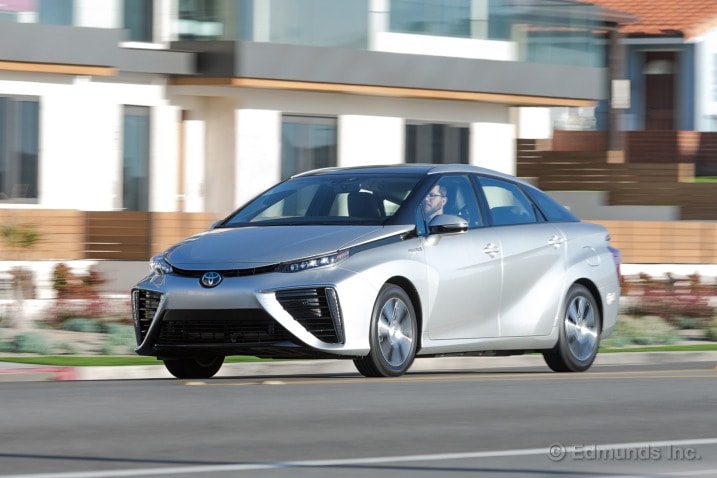
What do you want to know about?
- Introduction
- Set of Golf Clubs Fits in the Trunk
- 5 Favorite Things After 237.7 Miles
- First Impressions
- Trunk Is Larger Than It Looks
- Easy To Refuel
- Not a Fan of the Seats
- Button, Button, Who's Got a Button?
- Performance Tested - Running on Fumes
- Lexus Lite Interior
- Qi Wireless Phone Charging
- Everything Is Heated
- Can't Say You Weren't Warned
- Failure To Refuel
- This Water Is Not for Drinking
- Easiest DIY Maintenance of All
- Steering Heft and Parking Effort
- View From the Back Seat
- Coming to Grips with Hydrogen Fuel Economy
- Some of the Only Real Buttons You'll Find
- Station Location Situation
- Hydrogen is Ridiculously Expensive, or Free
- Busy Hydrogen Station
- Hydrogen Highway vs. Tesla Supercharger Network
- Hydrogen vs. Electricity Road Trip to Lake Tahoe
- Close Finish in Hydrogen vs. Battery Contest
- Old-School Parking Brake
- How Much Room Do You Need?
- Wrap-Up
Introduction
What Did We Get?
With sales starting late last year, the 2016 Toyota Mirai qualifies as the first fuel cell hybrid electric vehicle (FCHEV) available for public sale in North America. That's a big deal. The technology has been simmering in the background for a couple of decades, but Toyota has now reached the point where it feels comfortable selling it outright.
Similar progress has been made on the refueling side. There's now a small but growing number of retail hydrogen filling stations in the more populated parts of California.
A hydrogen fuel cell vehicle is powered by an electric motor, but it does not replenish its on-board battery by plugging it into an electrical outlet. Instead, a device in the car called a fuel cell creates electricity. It does it by fostering a chemical reaction between compressed hydrogen gas stored in onboard tanks and oxygen from the surrounding air. The only emission is pure water.
Functionally, a FCHEV like the Mirai drives with the same punchy low-end torque and quiet smoothness of a traditional battery-only electric vehicle. But hydrogen fuel cell vehicles enjoy a couple of practical advantages. When it comes to refueling time and driving range, a fuel cell car is comparable to an ordinary gasoline car. It takes just five minutes to fill the Mirai's reinforced carbon-fiber tanks with nearly 5 kilograms of hydrogen. The EPA says that's enough to allow the Mirai to travel 312 miles, which is farther than any current electric vehicle on the market.
What Options Does It Have?
Configuring a 2016 Toyota Mirai is easy. It's offered in just one trim level, and everything comes standard. Ours carried a sticker price of $58,335.
There are incentives, of course. Toyota offers $7,500 in "Trailblazer Purchase Support," the federal government offers an $8,000 tax credit and the state of California offers a $5,000 rebate. All of that adds up to $20,500. Toyota loaned us this Mirai, so we didn't have to do all the paperwork.
But that's not all. The Mirai is allowed into carpool lanes, and the first three years of hydrogen fuel are complimentary. The Mirai is starting to look a lot more attractive now, isn't it?
For that you get a well-appointed front-wheel-drive sedan that feels like a Toyota Avalon, only slightly narrower. The seats are leather, but hidden fuel cell system components limit the backseat to a pair of buckets and a center console. Toyota's top-level Entune system with navigation is standard and there's dual-zone automatic climate control, too. Safety goodies such as blind spot monitoring, lane departure warning, automatic emergency braking and adaptive cruise control are also part of the package.
Why We Got It
Hydrogen fuel cell vehicles have been pitched as the next big thing for decades now. Toyota certainly thinks so, but Elon Musk calls them "fool cells." Until now we haven't really had the chance to see who's right in this debate. The Mirai changes all that.
We're fully aware that it's still early days. After all, the number of publicly available stations has only recently crossed into double-digits, and Mirai sales are strictly limited to buyers who live and work in the areas of California those stations serve. But new hydrogen stations are starting to pop up with regularity, and this should quickly expand the car's practicality and radius of operation.
In the meantime, we're going to treat our Mirai like any other car in the fleet. We'll commute in it daily, run errands on the weekends and take the occasional road trip when possible. If fuel cells really are the next big thing, we'll get our first taste of the future. Or maybe we'll prove Elon Musk right. Only time will tell.
Follow the Mirai's progress on our long-term road test page for our latest thoughts and impressions of this truly unique machine.
The manufacturer provided Edmunds this vehicle for the purposes of evaluation.

There are so many aspects of our 2016 Toyota Mirai that are unusual. Thankfully, the trunk isn't one of them. Sure, it's not as big as it could be thanks to the twin tanks of compressed hydrogen hiding underneath the floor, but as you can see there's still more than enough room for a standard set of golf clubs.
We don't have official numbers on the size of the trunk. Just by looking at it I would say it's definitely smaller than the trunk of a Camry which is listed at 15.4 cubic feet. It's clear that the Mirai is much narrower overall and it's trunk is not nearly as deep as the Camry's. It also has no rear-seat pass-through for longer items. Still, my clubs fit just fine and I could have fit another set in there if I really tried.
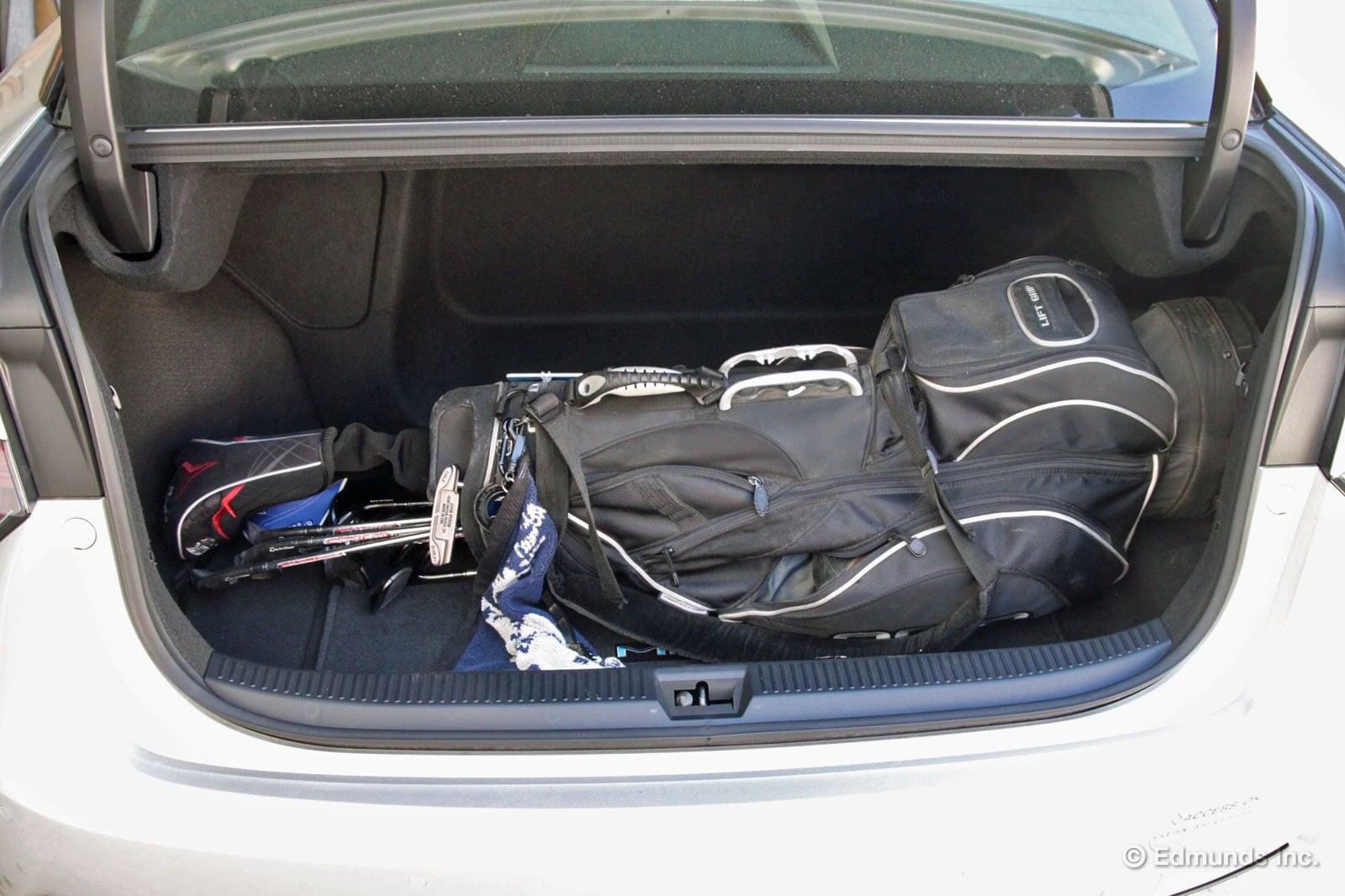
If cargo space is a concern the Mirai probably isn't going to work for you. But as alternative fuel vehicles go, I don't think the Mirai asks you to give up much.
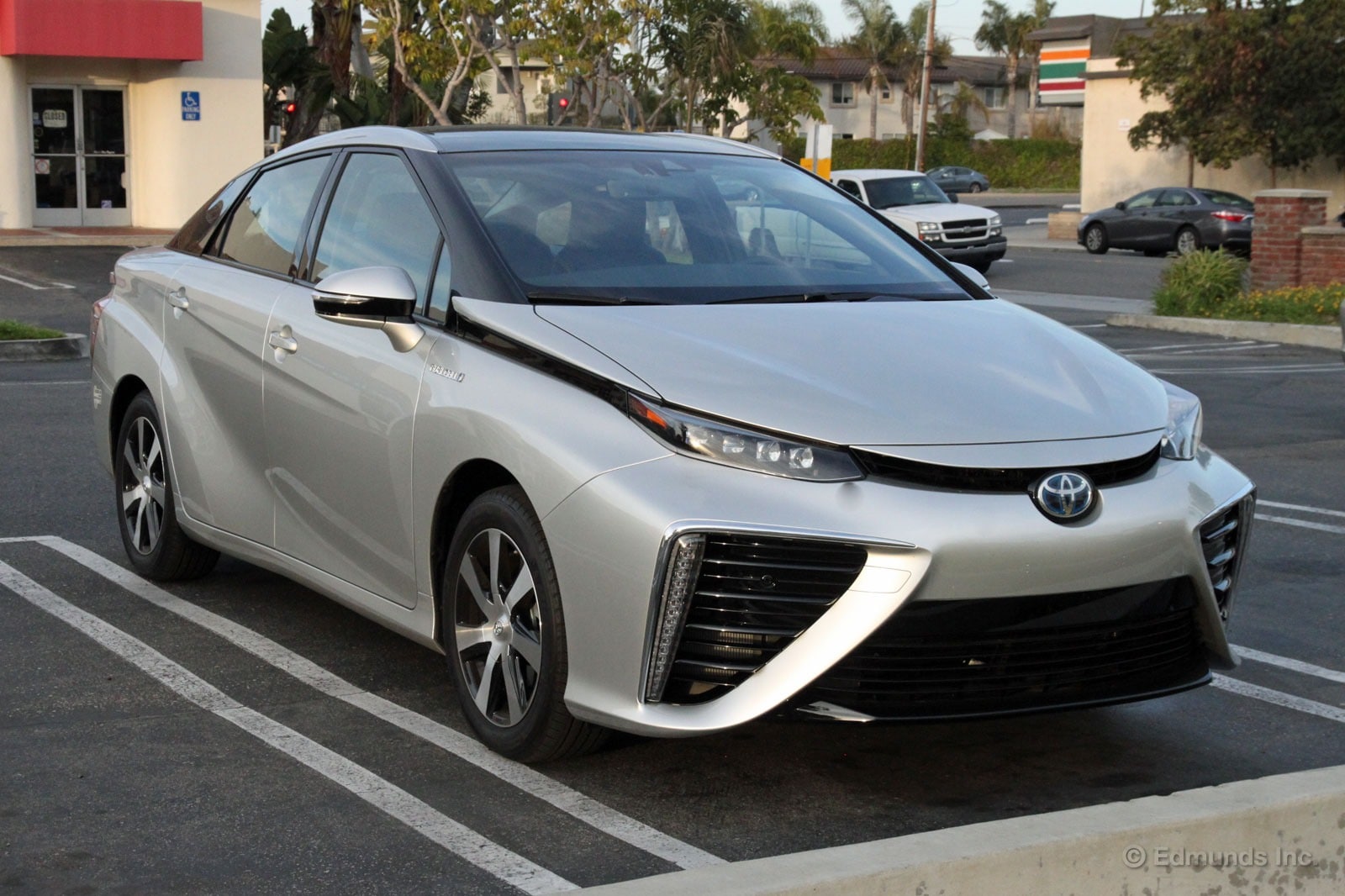
Santa Monica, Huntington Beach, Santa Monica, Playa del Rey, Burbank, Irvine, Costa Mesa and back to Santa Monica.
In just two days our new long-term 2016 Toyota Mirai and I covered this route together, which added up to 237.7 miles of driving.
Spend that many miles in that little amount of time behind the wheel and you learn a lot about a car. Here are five things I learned about the fuel-cell powered Mirai.
1) You can drive the Mirai in the carpool (diamond) lane regardless of how many passengers are in the vehicle. So long, suckers.
2) Its driver's seat and seating position are extremely comfortable. And its two-level (High and Low) seat heaters are plenty powerful.
3) It rides wonderfully, with its suspension soaking up everything it should but never feeling floaty or disconnected from the road. It's not sports car, but the Mirai feels planted, stable and easy to drive. It's smooth.
4) It's quick. At the test track it accelerated from 0-60 in 8.7 seconds. That doesn't exactly sound like a thrill ride, but in the real world the Mirai can leave traffic in its dust. And it will out accelerate a Toyota Prius easily.
5) This is a well-built car. Fit and finish is excellent. And everything works with precision. This is an expensive car, so it shouldn't ever feel cheap or tinny and it does not. The Mirai has a solid feel which I always find very desirable.
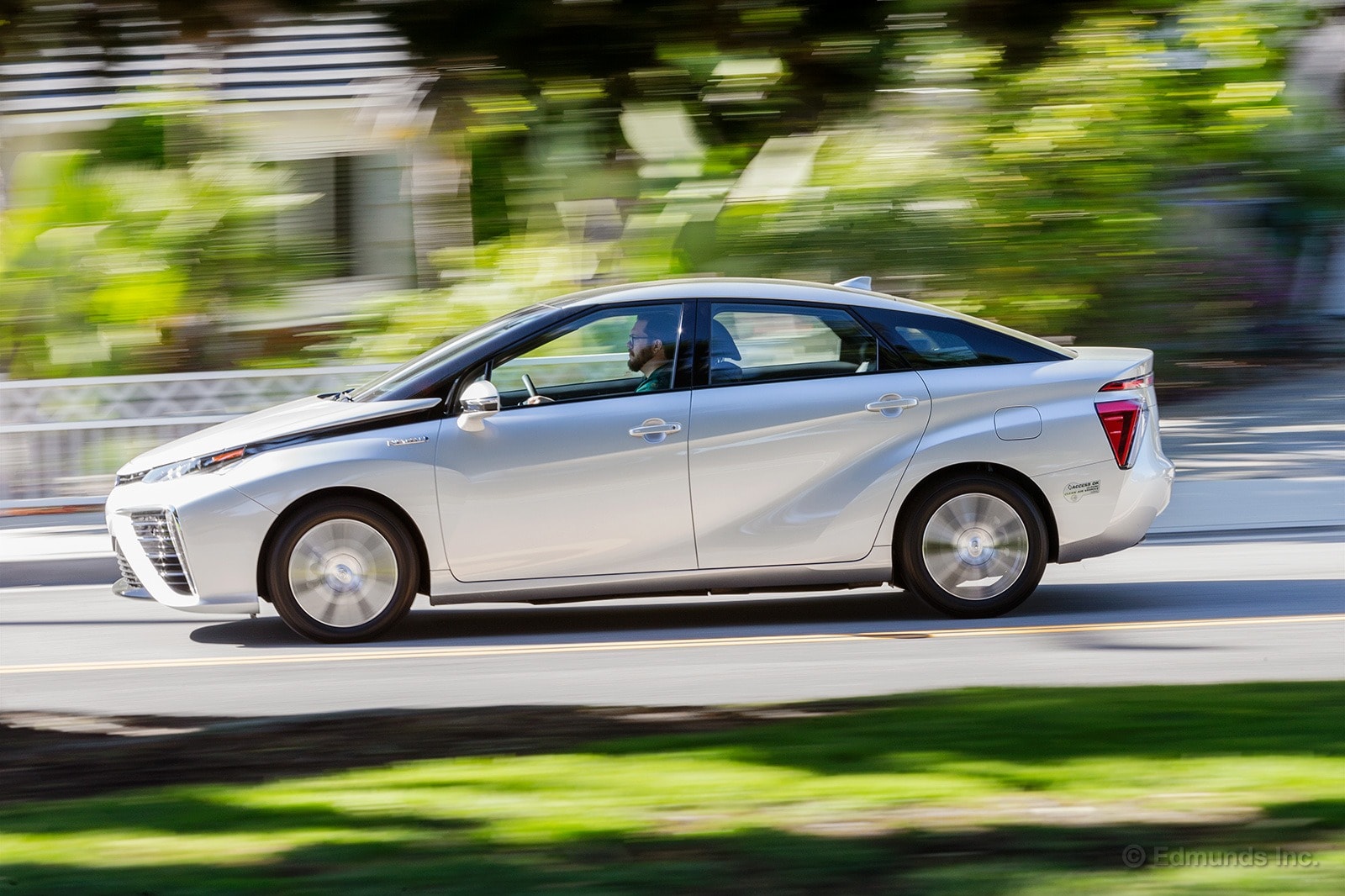
Our new 2016 Toyota Mirai is a very different kind of car. It's not only driven by an electric motor, it uses a hydrogen fuel cell to generate the electricity. Yet as revolutionary as it is from a technology standpoint, it's still very much a traditional sedan once you're behind the wheel.
The one thing that struck me the most about the Mirai over the course of a weekend was how quiet the cabin is on the road. Obviously, not having any engine noise helps, but it also has very little wind and tire noise. On some of the rare stretches of smooth highway pavement in L.A., this Mirai is as quiet as any high-end luxury car.
Seat comfort was also another surprise. I wasn't expecting anything special, but the driver seat in the Mirai fits my six-foot two frame perfectly. It has excellent bolstering along the sides and plenty of support for my thighs. I wasn't behind the wheel enough to judge long-distance comfort, but I would be surprised if they got any worse over the long haul.
There will be much more to tell as the Mirai racks up the miles, but so far it feels like a comfortable and practical sedan, as long as there are enough hydrogen stations nearby.
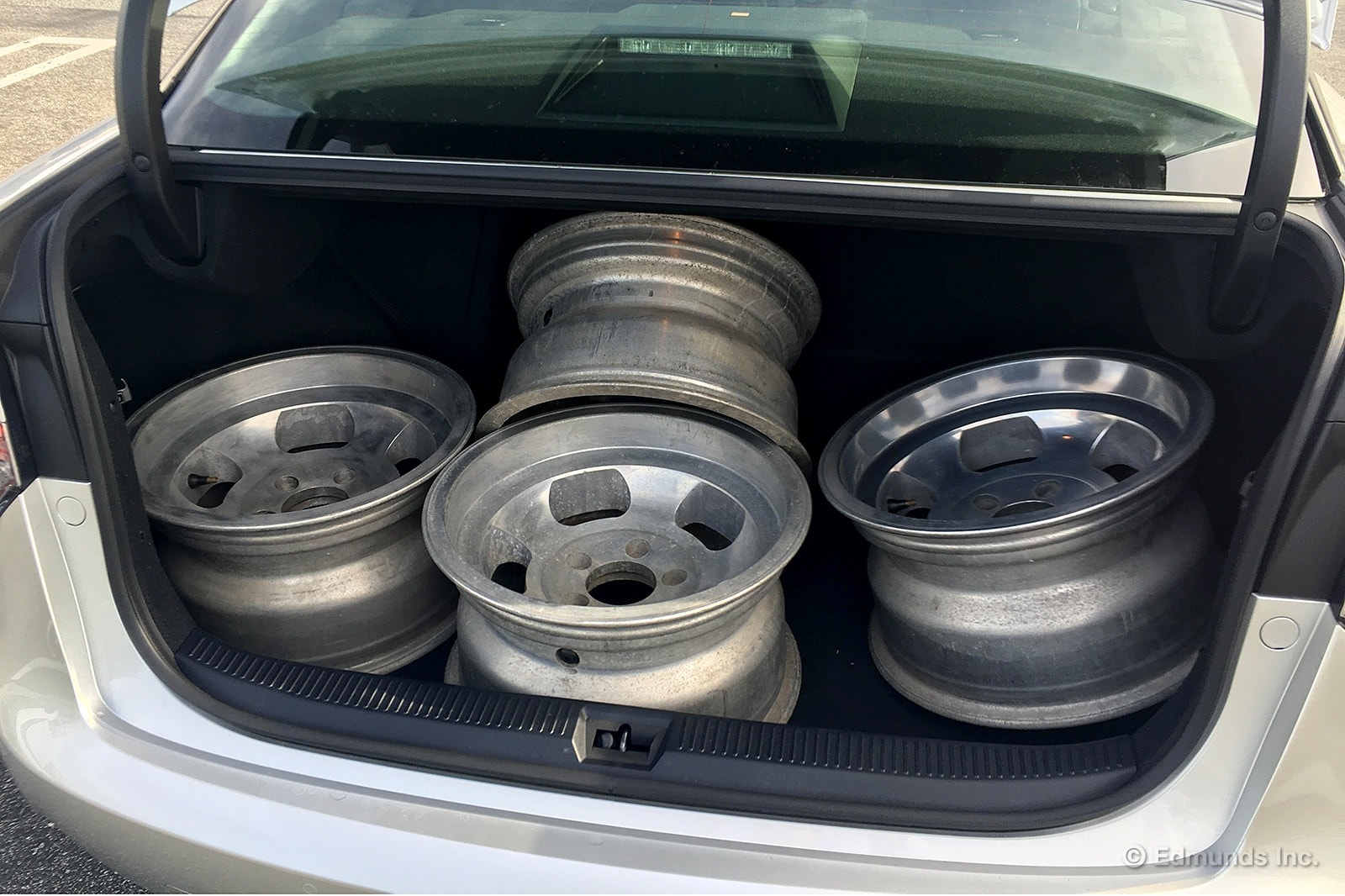
In our complete review of the fuel-cell powered 2016 Toyota Mirai we wrote, "Because the car was designed from the start to be a fuel-cell vehicle, the bulky fuel tanks and battery don't intrude much into either cabin or trunk space. The Mirai's trunk isn't as large as that of most conventional cars its size, but it's still roomy enough to handle typical chores like grocery shopping or runs to Target."
Poppycock, I thought, as I opened the decklid to our newly received silver long-term Mirai. I took one look at the Mirai's trunk space, and thought, "There's no way I'm getting four wheels in there."
I was wrong of course. They did fit. Easily.
Oddly, Toyota doesn't offer an official cubic foot measurement of the Mirai's trunk. Per our tape measure it's 21-inch deep and 50-inch wide, and to my surprise, that was more than enough space to haul my four 1970s vintage 15x8.5-inch slot mags, which came into my possession a few years ago after a weak Craigslist moment.
Well, what comes around goes around, including slot mags. They went back on Craigslist, then in the trunk of the Mirai and are now the property of a very kind Disney employee named Robert who plans to install them on his 1976 El Camino.
By the way, I can guarantee you I'm the first person on earth to ever haul aluminum slot mags from the '70s in a fuel cell vehicle. And I think that's pretty cool.
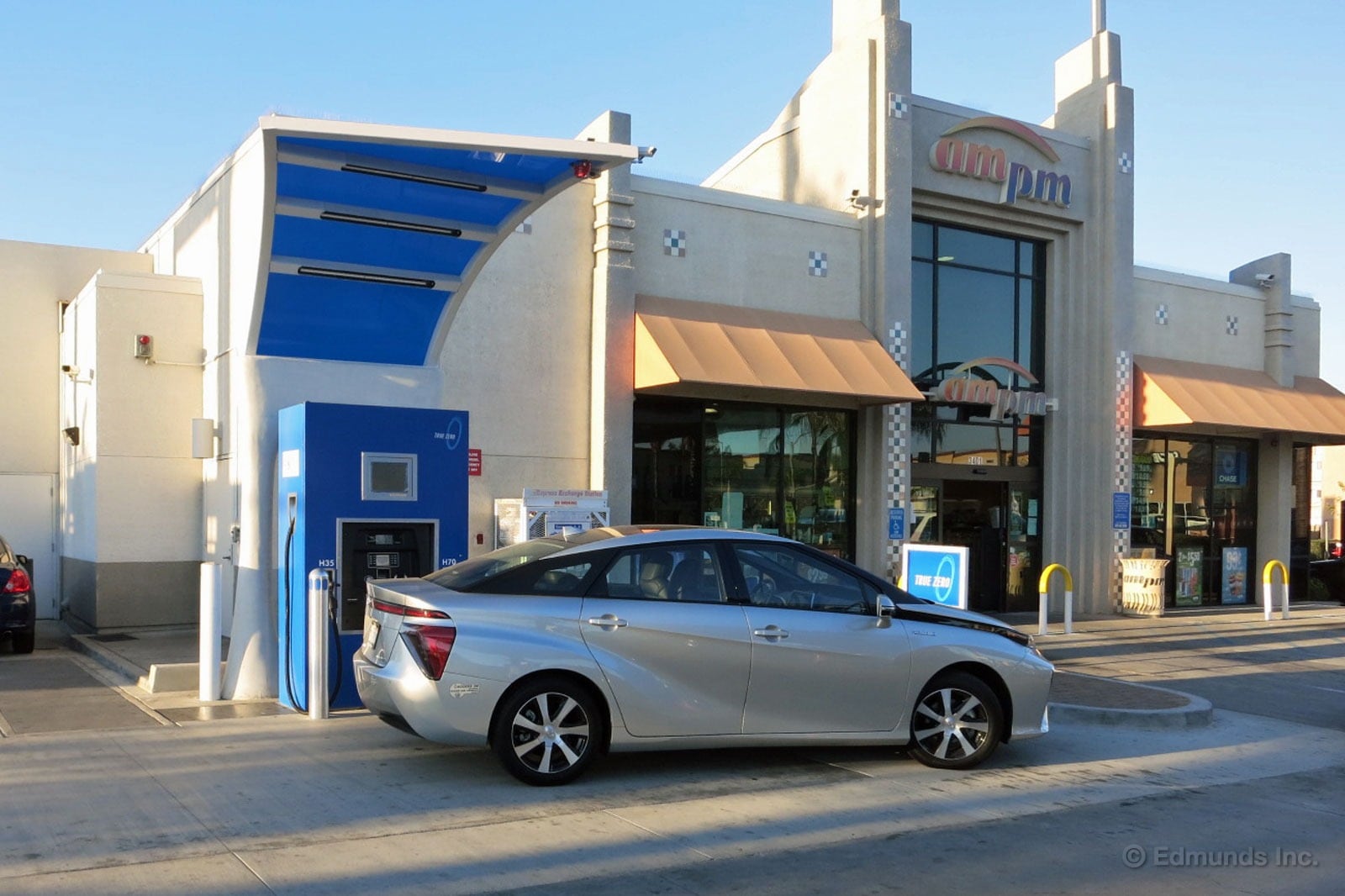
Our 2016 Toyota Mirai is a very complex machine. Easily the most technologically advanced car in our fleet. Does that mean it's a pain to refill its carbon fiber hydrogen tanks?
Not in the least. In fact, it's easier to refill than a normal car.
That's because at most of the stations, like this one in Long Beach, California, you get your very own parking spot. You just pull up, swipe your card and hook up the nozzle.
It's a slightly different setup than your average pump. In this case, you push the nozzle onto a metal fitting and then squeeze the handle to clamp it down. At that point, you lift the handle and choose your filling pressure.
For a full tank, you choose the H70 high pressure side. If, for some reason, you only wanted half a tank, the H35 side will do the job.
Once you've started the process, the system pressurizes first and then begins filling. There are various noises from the pump, but none of them are much different than a regular gas pump. Once the tank is full, the pump stops and the video screen tells you to release the nozzle. That's it.
It takes about the same time as it does to fill a regular gas tank. After that, you're back to having 300+ miles or range depending on how you drive.
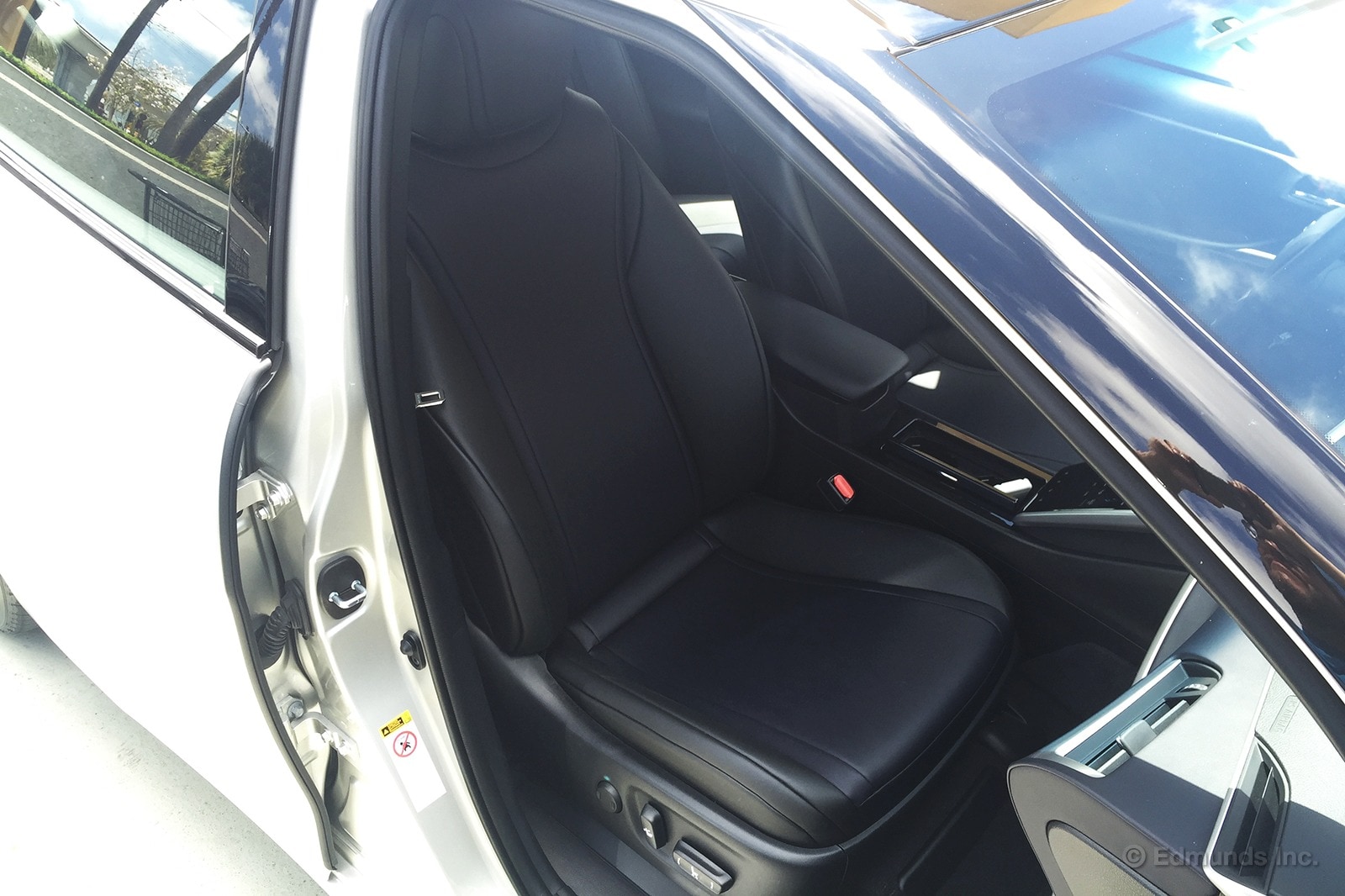
In stark contrast to both Scott and Ed's opinions on the seats in our long-term 2016 Toyota Mirai, I am not a fan. It has nothing to do with the shape. It's everything else that I have problems with.
First off, the seating position is too high for my tastes. I feel like I'm sitting on a bucket. It's the same problem I have with my wife's Fiat 500. Neither one allows the seat go down far enough. I think it's a packaging issue with the fuel cell goodies that forces the seat to be so high, but the end result is an awkward, upright, about-to-topple-over feeling.
Secondly, the seats don't breathe and my back starts to sweat after even short trips in the car. The Mirai doesn't have leather. Presumably Toyota feels that leather goes against the environmentally friendly image of the car. What we have instead is some type of faux leather that I stick to like no other car I've ever driven.
Scott says the heated seats are fantastic. I have no need or desire to test his claim.

Everything about our long-term 2016 Toyota Mirai, from the hydrogen fuel cell powertrain to the overall design language, screams "IT'S THE FUTURE!" I think the fuel cell bit is very interesting and I'm happy Toyota is loaning us a Mirai for our long-term fleet. It's some of the other stuff that I'm not hot on.
Now, looks are subjective, and I'm subjected to the Mirai's hideous shape every time I walk by. Other people may not agree, and that's fine. Other people are wrong all the time.
Getting inside keeps you from looking at that fish face, but the weird, semi-futuristic design carries to the interior. The seats are blue and black leather, the center mounted digital gauges carry over nearly unchanged from the Prius, but what really irks me about the interior is the large, glossy-black infotainment and HVAC control panel.
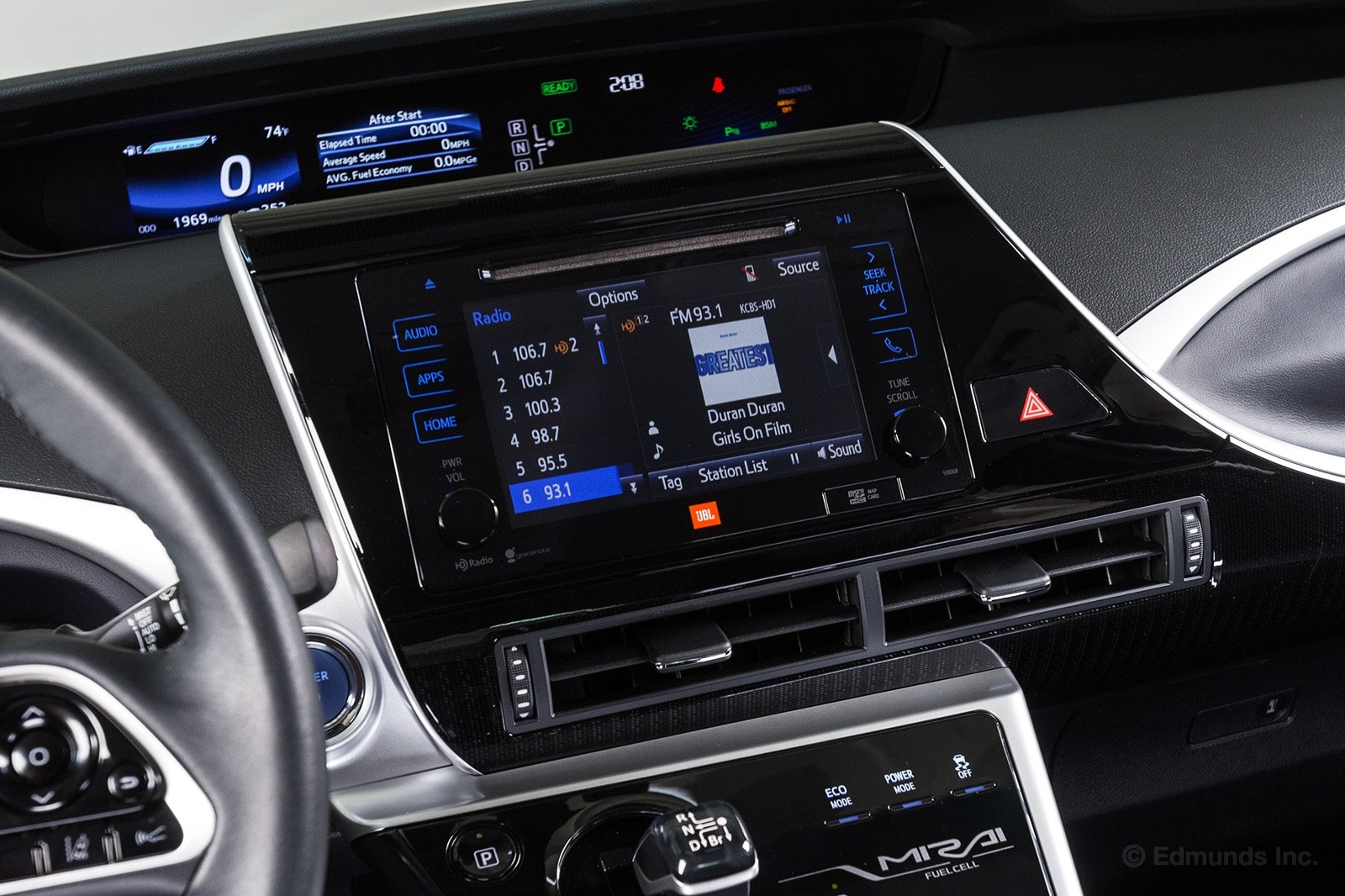
As you can see in the photos, the entire thing is gloss black and nearly buttonless. The infotainment system is the same one found in our long-term 2016 Toyota Prius and our long-term 2016 Toyota Tacoma. The rest is unique to the Mirai.
I have a few problems with the setup. First and foremost, the whole things draws dirt like a moth to a candle. After a few hours of driving with the windows down, there was a fine layer of dust on every bit of that gloss black surface. The dust does cut down on the glare, so maybe it can be considered a "feature."
My next issue is has to do with the lack of tactile buttons. I'm about the billionth auto writer to lament the downfall of the button, but there is a reason we all gripe. I don't like having to look away from the road for more time than required. Adjusting the fan or direction of the air flow or using the slider for the temperature means I have to look down. I don't care if it looks neat in photos. It's dumb.
What's more, the whole dash collects fingerprints. Anyone with a smartphone knows how easily they collect prints. That's annoying, but it comes with having a large glass touch screen. The problem in the Mirai could have been avoided. Toyota didn't need to make the entire thing gloss black. They didn't need to remove all the buttons, ensuring that there will be finger smears all along the temperature slider or on the little "APPS" button on the infotainment display. Hell, if it had buttons, it might cut down on the fingerprints since there wouldn't be so much random finger jabbing.
This may sound like I don't like the Mirai. That's not true. It's quiet, reasonably comfortable and drives like a finished product despite its rolling-laboratory powertrain. Plus you can spray water like an oil slick. I just wish that, in other ways, the Mirai didn't have to be so "car-of-tomorrow."
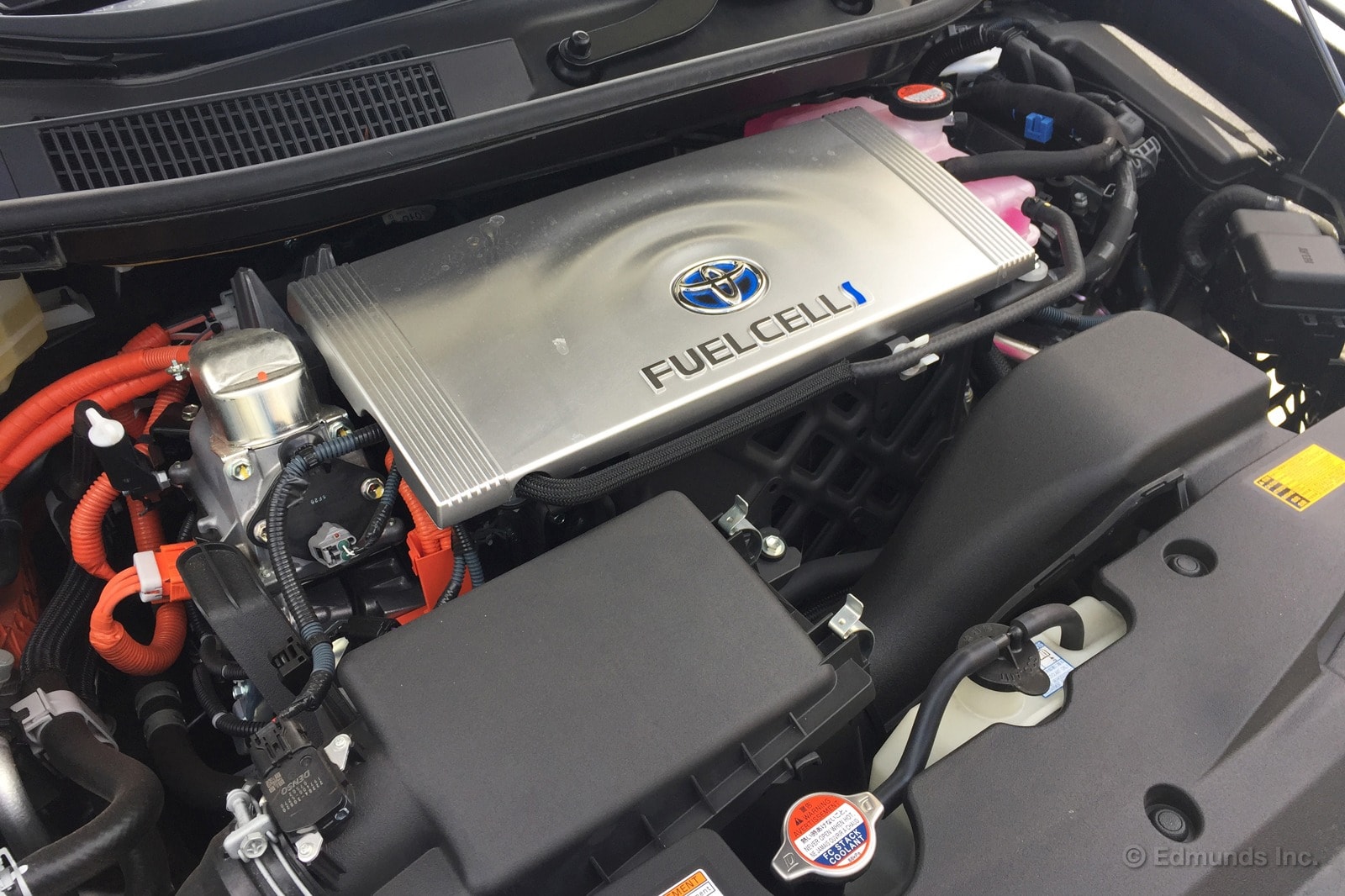
The hydrogen fuel-cell powertrain in our long-term 2016 Toyota Mirai separates it from every other vehicle in our fleet. We have a 2016 Chevrolet Volt, a 2016 Tesla Model X and a 2016 Toyota Prius, but nothing on the market directly compares to the Mirai.
This unusual powertrain doesn't mean it has a driving character that's totally out of whack with what you expect in a modern car. In fact, it behaves pretty much like a pure EV. Read ahead to see if it performs just like one.
Vehicle: 2016 Toyota Mirai
Odometer: 2,780
Date: 4/19/2016
Driver: Jonathan Elfalan
Price: $58,335
Specifications:
Drive Type: Front-wheel drive
Transmission Type: Direct-drive
Engine Type: Hydrogen Fuel-Cell Hybrid EV
Electric Motor Horsepower: 151
Electric Motor Torque: 247 lb-ft
Brake Type (front): One-piece ventilated discs with single-piston sliding calipers
Brake Type (rear): One-piece ventilated discs with single-piston sliding calipers
Suspension Type (front): Independent MacPherson strut front suspension with stabilizer bar and hydraulic shock absorbers
Suspension Type (rear):double wishbone rear suspension with coil springs, trailing arms, stabilizer bar and hydraulic shock absorbers
Tire Size (front): 215/55R17
Tire Size (rear): 215/55R17
Tire Brand: Michelin
Tire Model: Primacy MXV4
Tire Type: Low-rolling resistance all-season
As tested Curb Weight (lb): 4,060
Test Results:
Acceleration:
0-30 (sec): 3.2 (w/ TC on 3.2)
0-45 (sec): 5.6 (w/ TC on 5.6)
0-60 (sec): 9.1 (w/ TC on 9.1)
0-60 with 1-ft Rollout (sec): 8.8 (w/ TC on 8.8)
0-75 (sec): 14.3 (w/ TC on 14.1)
1/4-Mile (sec @ mph): 16.8 @ 80.6 (w/ TC on 16.8 @ 81.0)
Braking:
30-0 (ft): 31
60-0 (ft): 126
Handling:
Skid Pad Lateral acceleration (g): 0.75 (w/ ESC on 0.75)
Comments:
Acceleration comments:
The Mirai shows excellent response off the line, thanks to instantaneous torque from the electric motor. There is no real perceivable difference between Eco and Power modes when accelerating at full throttle. In fact, the runs get continually slower, meaning the initial "key up" run was quickest. The Mirai is completely silent until you step on the accelerator. This is followed by a series of high-pitched tones and whines as the systems switch on to produce electricity and the motor winds up. Acceleration torque feels most prominent from 0 mph to around 50 mph, and then levels off noticeably right after that. Turning traction control off has no effect on the launch, as there's no wheelspin to be had. Also, if you overlap the brake and throttle pedal applications in an attempt to power brake in the launch, you'll receive a warning on the dash that says you've overlapped them (a precaution prompted by the previous "unintended acceleration" debacle).
Braking comments:
There's a little bit of instability at the initial brake actuation. The brake pedal is pretty soft, a little squishy, but the travel is short and it's easy to reach maximum braking force. There is a moderate amount of ABS noise and tire squeal that is more audible since the car is so quiet, but you don't feel any of the brake pulses is through the pedal, which is a little unnatural feeling. There is also a surprisingly small amount of nosedive. Almost zero, actually. But there is some noticeable brake odor and a max increase in stopping distance of five feet after six stops.
Handling comments:
Skidpad:
Although the Mirai is heavy and possesses low levels of tire grip, with the traction/stability control systems turned off the car will allow for some surprisingly aggressive inputs. It isn't quick or sporty but it is predictable and relatively composed in its handling, which is something we didn't expect. With the system turned on, if you drive a clean steady line around the skidpad all you'll hear is a clicking noise by the front wheels from what we believe to be the brakes being actuated. If you push past this point slightly, the front inside wheel brakes will activate to dial out some of the understeer. Go further and system will grab significantly more brake, and jerk you into line. The steering has a pretty soft on-center feel but is direct otherwise. However, road feel is minimal to nonexistent.

If you're going to pay nearly $60,000 for a Toyota, it had better not have the interior of a $30,000 Prius. Thankfully, our long-term 2016 Toyota Mirai does not. Indeed, its cabin is what I would call "Lexus Lite," wherein it's a clear step above other Toyotas yet not quite to the level of the company's luxury division.
The materials themselves come pretty close to the exceptional Lexus norm, especially the leather-esque material that covers much of the doors and part of the dash (photo below). There is a rich, distinctive and slightly coarse texture to it that only Lexus does and it covers a nicely padded under-surface. Everything seems very well put together, too.
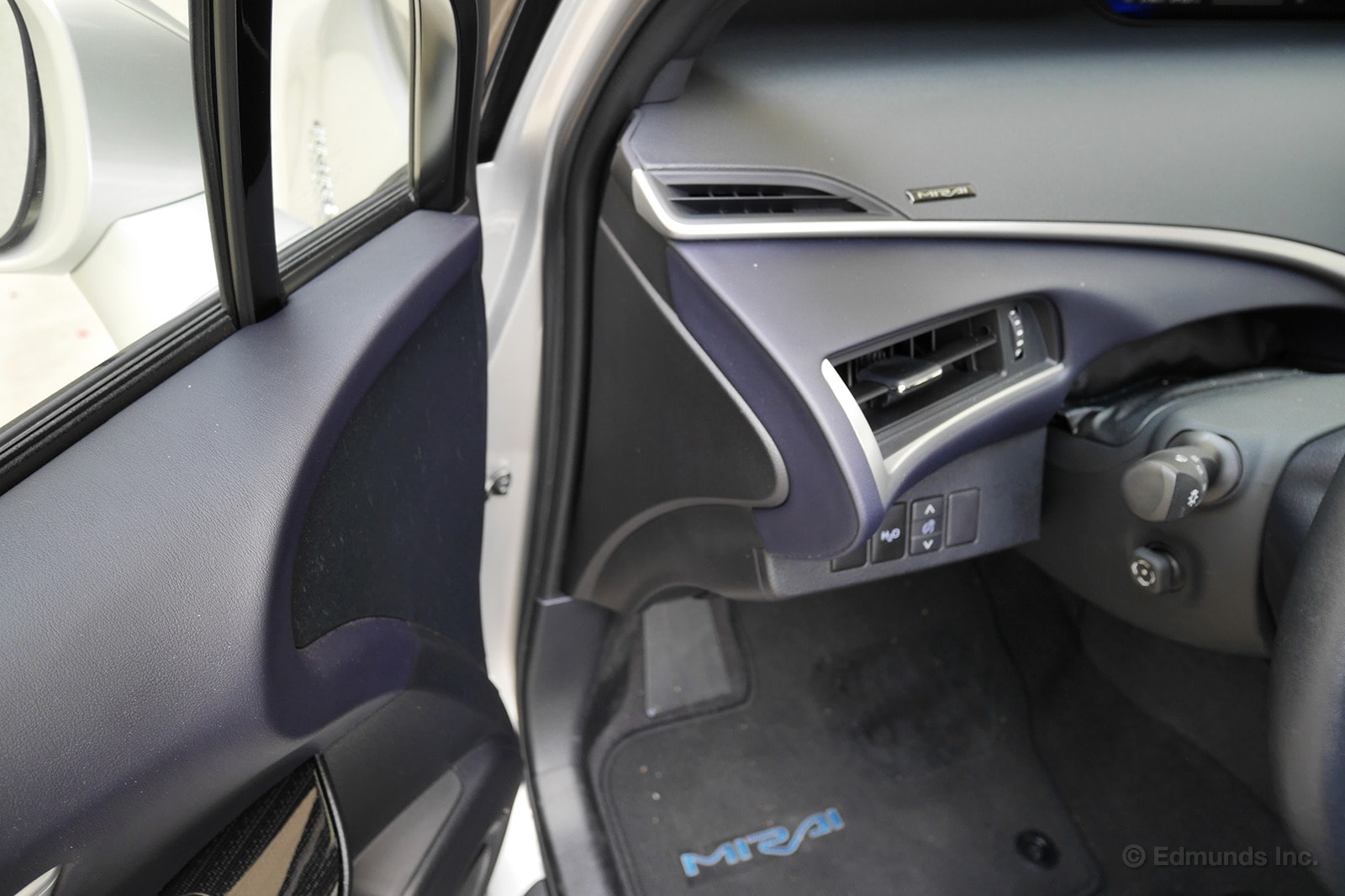
Caption: A closer look at the leather-like material that covers much of the doors and some of the dash. It's even a nice shade of dark blue.
Where it really differs from a Lexus is more related to style, design and technology choices than actual quality. The gloss black center console isn't cheap in look or feel, but it would also be out of a place in an IS 200t or NX 200t. The Toyota Entune touchscreen also wouldn't be found in a Lexus, which is a shame, since it's easier to use than Remote Touch and doesn't take up space on the center console with its silly joystick/touchpad controller.
One questionable area, though, is the SofTex simulated leather upholstery. Besides making things a bit swampy, it doesn't look or feel like the real cow-sourced stuff. Unlike Mercedes' superb MBTex, SofTex is unmistakably vinyl and is unlikely to fool your passengers. Now, Lexus offers something called NuLuxe simulated vinyl, but I've never had a chance to sample a so-equipped car to see how it compares.
Really, falling short of Lexus excellence shouldn't necessarily be considered a bad thing since it's a pretty high bar. Now, if the Mirai's cabin wasn't bolted to the same car as the future-tastic hydrogen fuel cells, it would be disappointing at $60,000. As it is, though, I think it's appropriate.

The 2016 Toyota Mirai is one of several new Toyota vehicles that comes with a Qi-compatible wireless phone charging pad. Different cabins locate the pad in different areas. In the Mirai's case, the charging pad is concealed inside the center armrest bin.
It sounds like a brilliant idea. Toss your phone on the pad, press the on button and *boom* your phone is charging without a cord.
But there is a catch, and it has led to complaints — especially among iPhone users. Your phone must have designed-in wireless charging capability or be fitted into a phone case or other adapter that is compatible. Apple iPhones up to and including the 6s do not have wireless charging capability, and some Toyota buyers were not made aware of the finer points of how the Qi charging pad works (or doesn't) before they bought their new car.
The iPhone problem can be rectified with a Qi-compatible phone case, which includes some newer Mophie backpack extended battery cases. Still, your case choices are limited.
But there is another way.
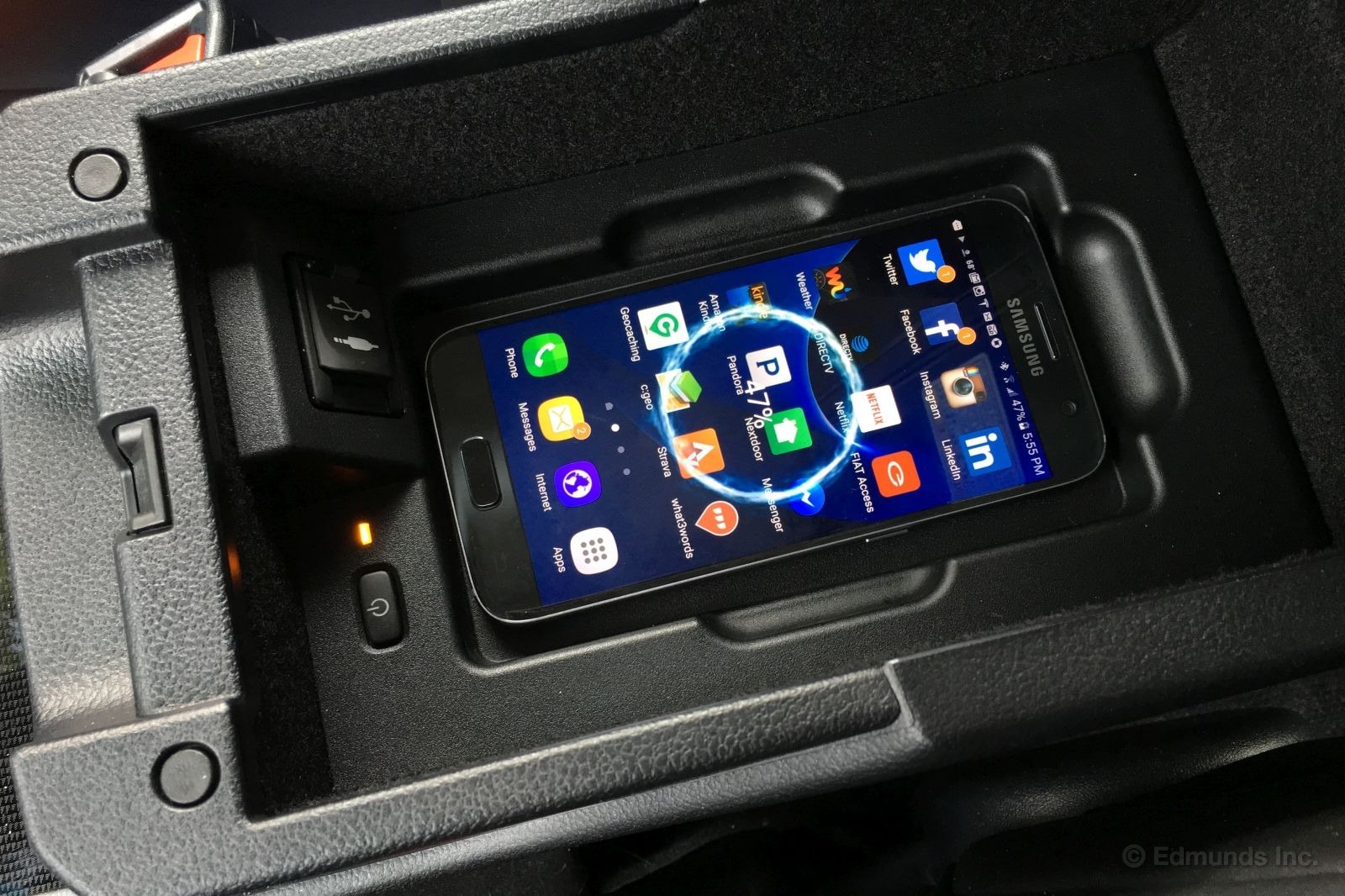
Get a phone that has built-in wireless charging. The Samsung Galaxy S7 is such a phone, and it takes things a step farther by charging at a far quicker rate than other models.
To let you know it's working, the screen emits a weird expanding ring when you first lay it on the dock. Then it goes to sleep while the phone continues to charge. The case situation can rear its ugly head in a different way here, though. Certain thicker cases can interfere with the charging process.
You can continue using a phone that's charging on a Qi pad, but in the Mirai you'd have to poke at the phone with the center armrest flipped open.
This is why many people dislike the whole wireless pad charging concept. A cord allows a charging phone to be handled and used when parked, or by a passenger while moving. And you'll want to use a cord anyway if you want to connect your iPhone to the audio system to listen to music or podcasts. Do that and your phone will charge anyway.
Perhaps the Qi wireless charging pad isn't such a big deal after all.
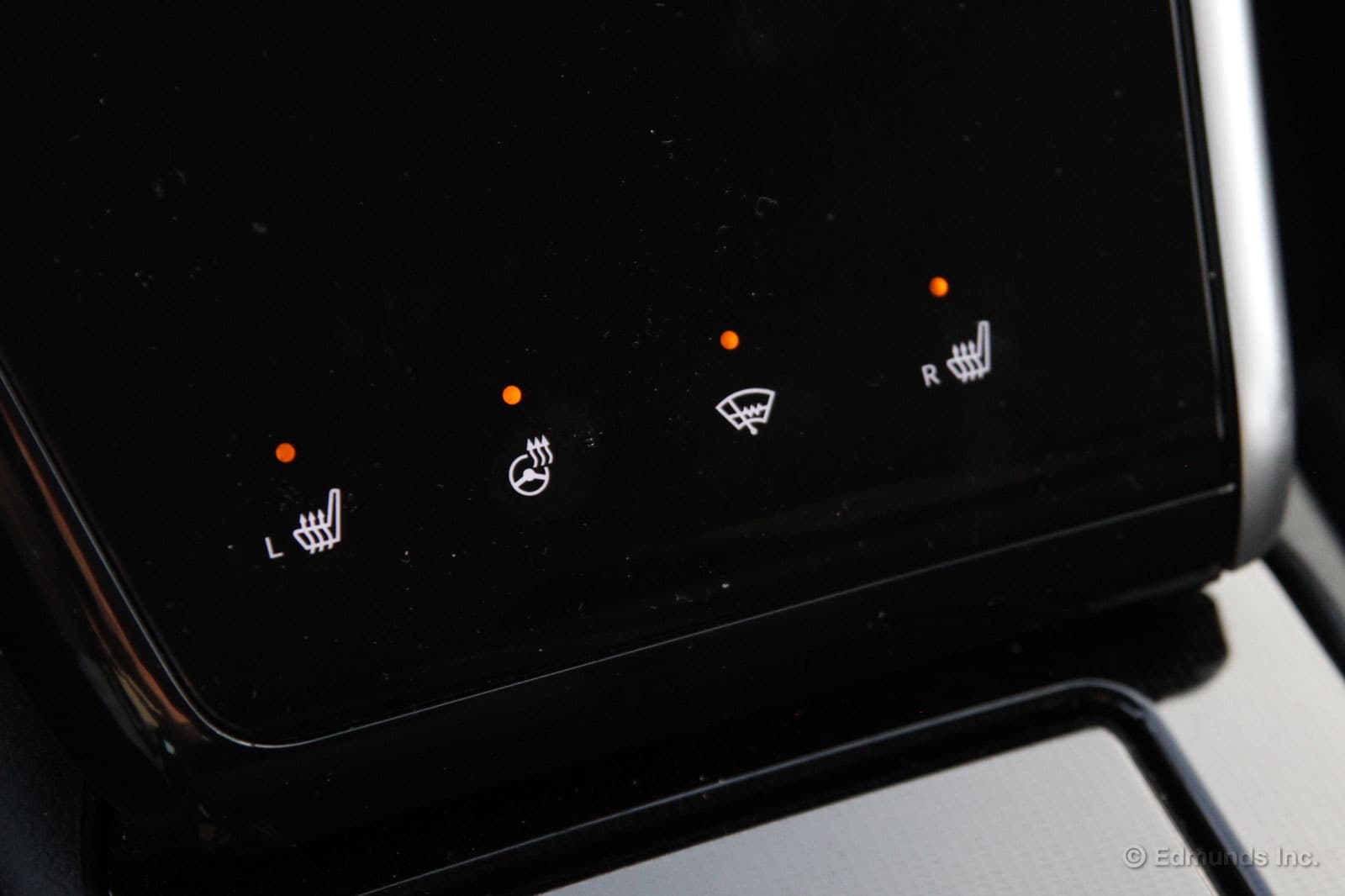
For a car that's only available in California at this point, the 2016 Toyota Mirai sure doesn't skimp on providing things that are heated. This panel at the bottom of the center stack includes controls for driver and front passenger seat heaters, the heated steering wheel and even heated windshield wipers.
Why all the heat? I have no idea. The seat heaters aren't unexpected, but a warmed steering wheel is a little bit extravagant in a car like this. I've seen a few vehicles with heated windshield wipers, but those cars were usually all-wheel drive models that were destined for duty in some hamlet in New England.
For the record, the seat heaters warm up quickly and maintain a comfortable temperature. They are two-stage heaters, so you can put it on low if you just want to soothe a sore back. Same goes for the rear seats, which get the same dual-level setup.
Since there hasn't been a chill in the air around here for many months, I can't vouch for the effectiveness of the heated windshield wipers. Someday when the temperature drops below freezing, I'll turn them on and stick a food thermometer in them to see just how warm they really get. I'm guessing they'll barely rise above 32 degrees F. Which, technically, is enough.

This is what you see on the dashboard when you power up our 2016 Toyota Mirai. It's a little startling to say the least. I can't help but think, "Is there really that much stuff that can go wrong?"
Turns out there's nothing to be worried about. The Mirai is no more prone to issues than any other conventionally-powered car. Most of these warnings are for fairly mainstream things like a low tire or leaving the parking brake on.
The reason it looks so daunting is the fact that they're clustered all together on one screen instead of being spread out across the dashboard like most cars. The centrally-mounted display screen is one of the Mirai's more unusual design elements.
It certainly looks different, but it's not my favorite setup. Having to look to the right to see your vehicle speed or one of these warning lights isn't the most natural driving habit. Sure, you grow accustomed to it, but a more conventional layout would be preferable. Then again, Toyota wants people to be constantly reminded that the Mirai is anything but conventional so it's no surprise that it features such an unusual layout.
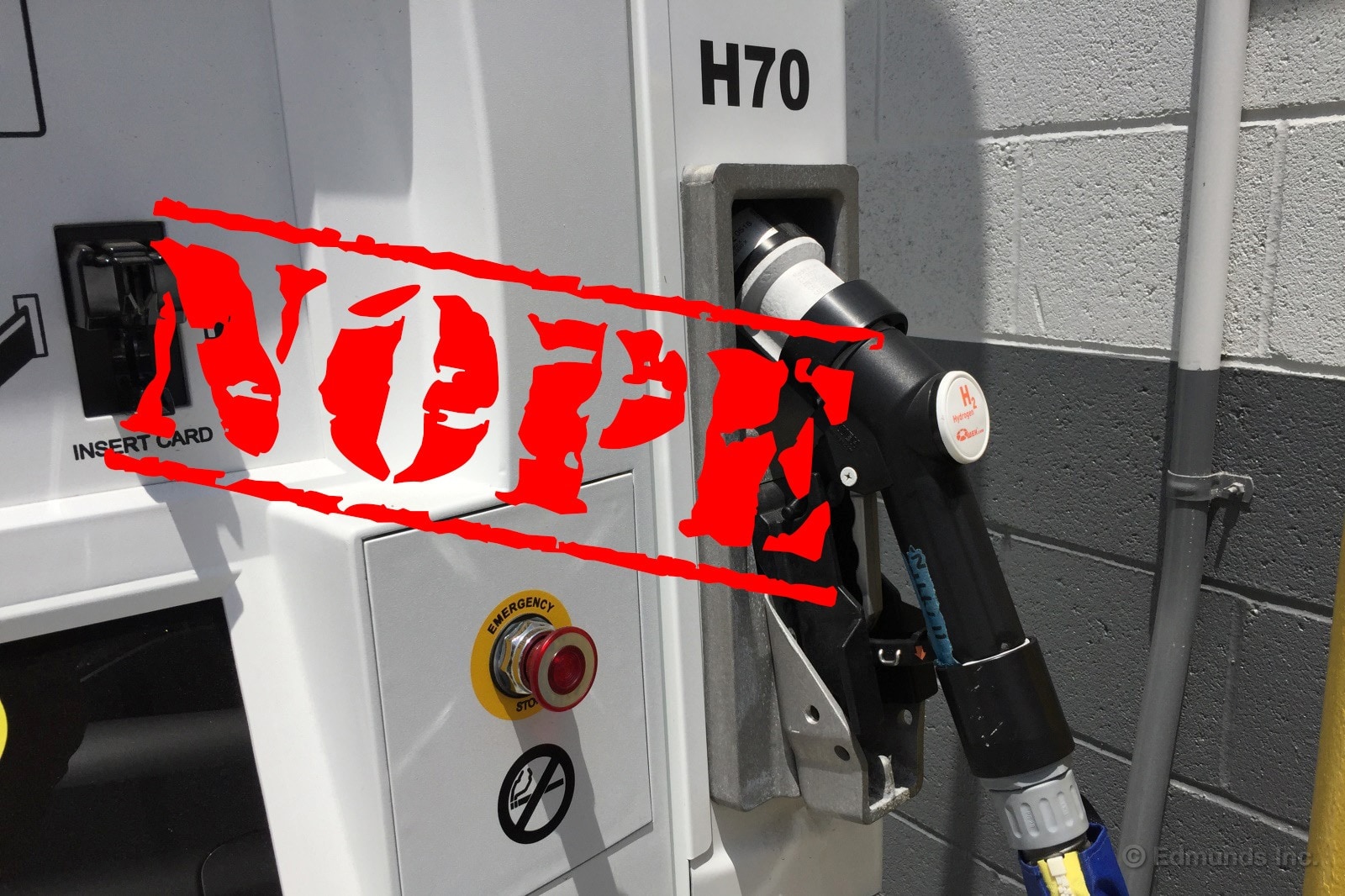
Attention Air Products, Inc — get your act together.
On Thursday I tried to refuel our long-term 2016 Toyota Mirai at Air Products' West L.A. station in Santa Monica, California. This being my first-ever attempt at refueling a hydrogen-fueled car, I followed the handy on-screen prompts. It didn't seem like rocket surgery. In fact, the process is virtually identical to fueling a conventional car.
With one exception — no hydrogen was delivered. The H70 pump timed-out after 20 seconds or so and prompted me to return the nozzle to the hook.
Though not included in the on-screen tutorial, I tried squeezing the lever on the dispenser a number of times at the point I thought such an action would be necessary to initiate fueling, but the lever was fixed in place. In turn, I assumed this fixed lever was standard operating procedure since what the hell do I know about gaseous hydrogen refueling? In any case, I made three attempts from start to finish to refuel the thing with no success.
I still had about 30 miles of range remaining so my situation wasn't dire. I'd just refuel on Friday at Air Products' Fairfax L.A. station near my house. So that's what I did, and it went without a hitch. Refueling the Mirai took about twice as long as refueling an average gasoline car, with a few (normal) minor pauses in delivery along the way. The dispenser handle grew cool to the touch, which is also normal (and welcome on this sweltering day). Easy peasy.
Notably, the trigger on this dispenser, unlike the West L.A. one, squeezed down the way you'd expect. Aha, I thought. A clue.
Fast forward to Monday morning. The Mirai was down to about a half-tank, but I figured I'd refuel it on my way to the office just to be a nice guy. I tried the West L.A. station again, figuring I must have done something wrong the last time. Maybe the dispenser handle had a little lockout or something I overlooked. Maybe I didn't squeeze hard enough. Maybe I'm a knucklehead. Who knows?
No dice. The trigger would not actuate; the pump would not dispense; there was no obvious lockout, and, as before, the system timed out with no fuel being delivered.
I went inside to see the attendant. He told me to call the number on the pump. I dialed the number and told the guy the pump's ID number and cross street location and that the pump would not dispense. After some time and a few on-holds, he transferred me to another tech. I again explained that the trigger would not actuate and that it was fixed in place and that no fuel would dispense.
More on-hold. He conversed with another tech. Relayed questions. Asked me if the on-site technician was present. No such technician was present. He seemed puzzled. He asked where I was again. Santa Monica Boulevard at Beloit, I repeated. "Oh," he said.
"That's the West L.A. location. I thought you were at the Santa Monica location. Yeah, the West L.A. pump is not currently working."
Note that there was no sign on the pump indicating its nonfunctional state, nor did the screen alert would-be users to this fact. Instead the entire card-sliding, code-entering, tutorial-giving, instruction-relaying, hand-holding process remained intact, except for the part that no fuel was ever dispensed. It even printed the receipt afterward.
"Well," he continued, "the technician is over at the Santa Monica station right now. When he's done there, he's going to head over to the West L.A. one. If you can wait for him, he should be over in a little while." I'd already been on the phone with them for 13 minutes. I replied that it'd be more logical and less time-consuming if I simply drove over to the Santa Monica station a few miles away and refueled there. He agreed that that made sense and apologized for the inconvenience. I hung up and went on my way.
Ten minutes later I received a voicemail from the technician. He was now over at the West L.A. station and said that he thought I was going to wait for him to show him the problem. He sounded mildly annoyed.
Because I'm swell, I tried calling him back. The call wouldn't connect. Instead all I got from the phone's earpiece was a full-volume, eardrum-shredding hiss of white noise that sounded exactly like high-pressure gas being vented.

Just to the left of the steering wheel in our our 2016 Toyota Mirai is a cluster of buttons. You might recognize the buttons on the outside (auto high beams, instrument panel brightness), but that one in the middle is unique to the Mirai. So what does it do, exactly?
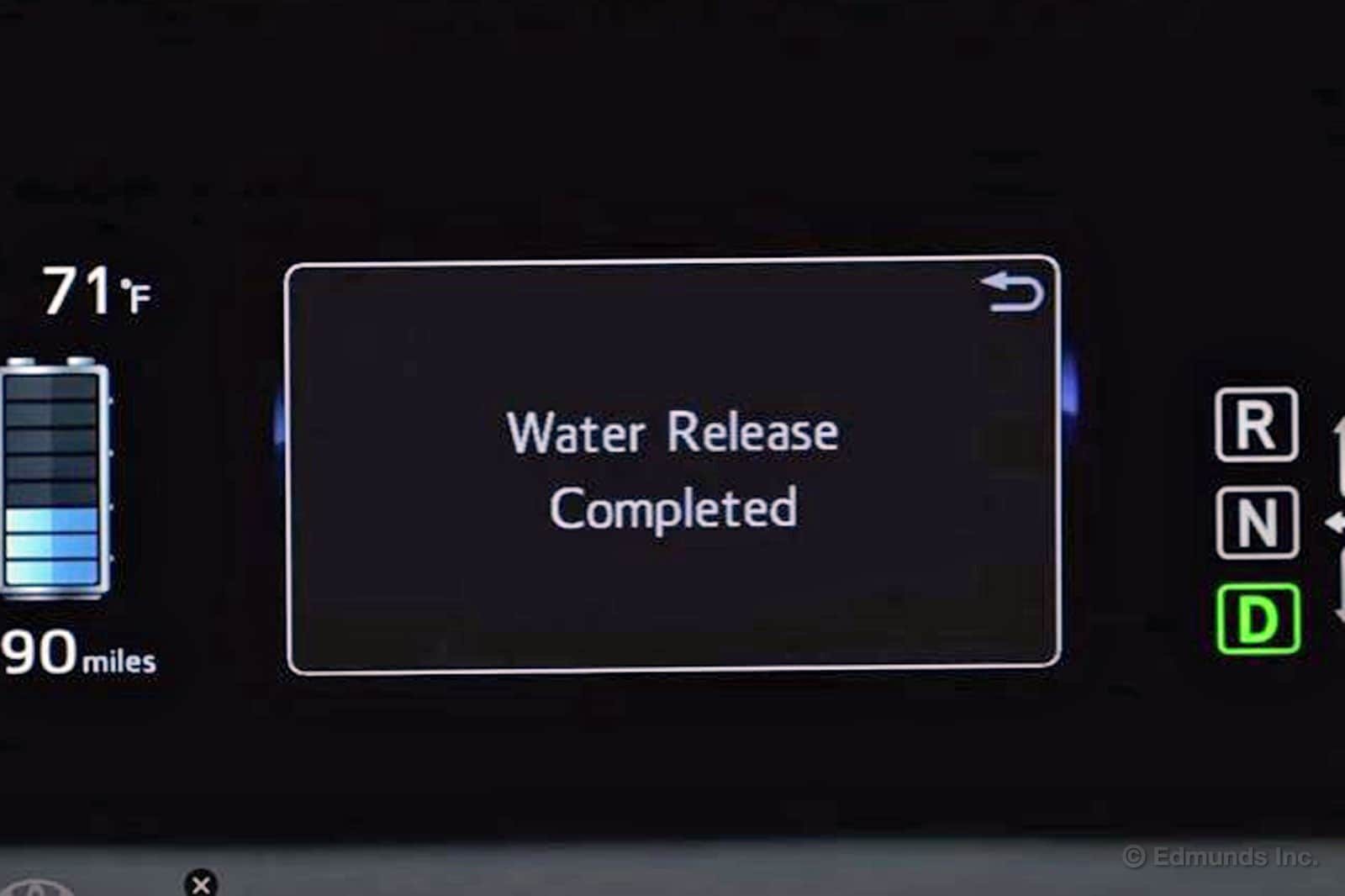
It's the water purge button. As you may or may not know, the sole byproduct of the fuel cell's conversion of hydrogen into electricity is water. Under normal use, that water is expelled through a discharge pipe underneath the car, so it might leave a small puddle much like the air-conditioning system of a normal car does.
It's an automated process that you don't need to think about most of the time, but the designers of the Mirai realized that there might be times when you want to get rid of the water proactively before it drips where you don't want to. For that, you simply hit the button and wait 15-20 seconds or so. The total amount released is pretty minimal, so should you ever get stranded in the desert with nothing to drink, the Mirai isn't going to be your savior.
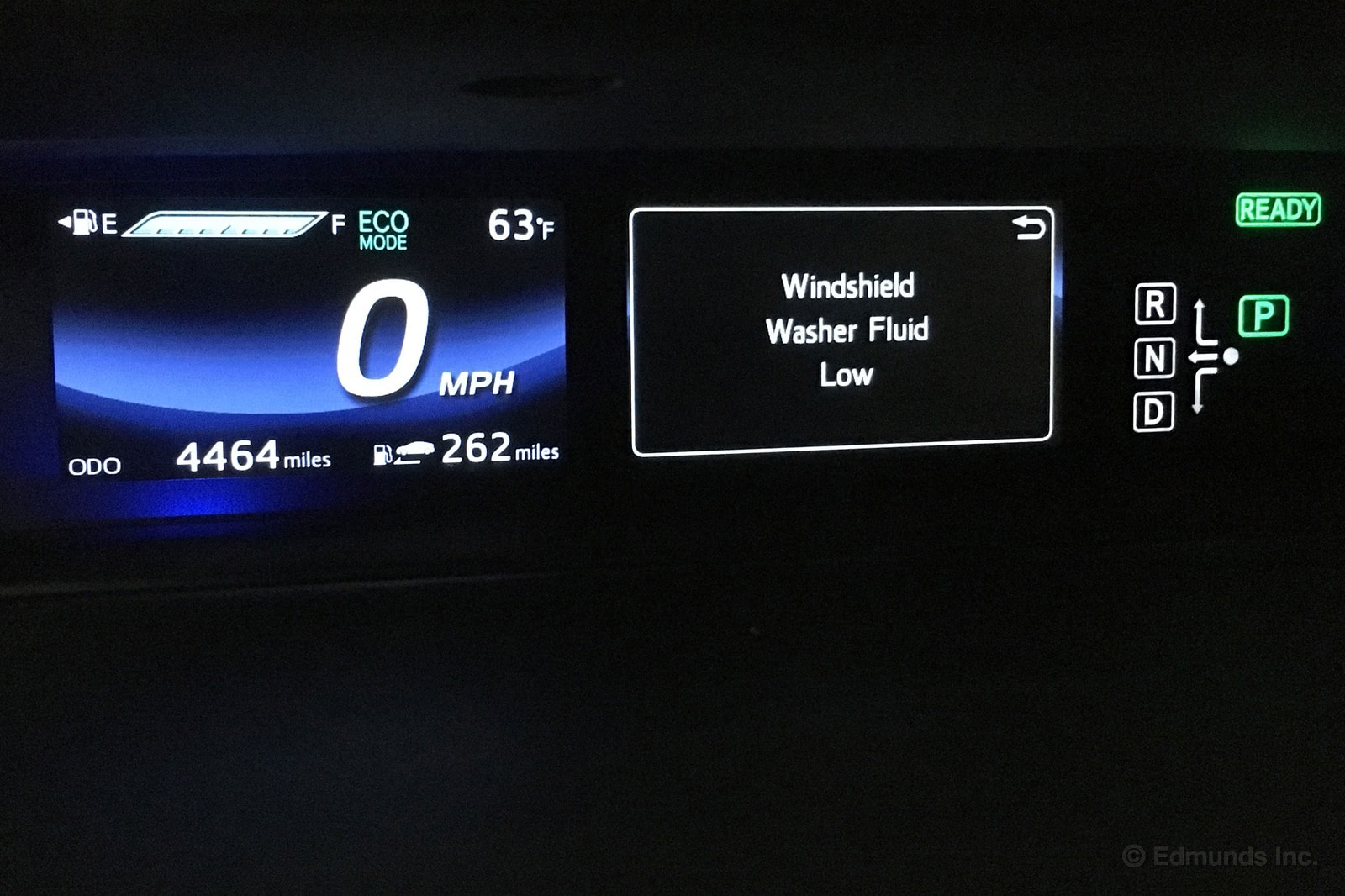
Today I performed the easiest DIY maintenance job of all on our 2016 Toyota Mirai. It needed wiper fluid. What would have been as simple as swinging by the auto parts store, gas station or even grocery store was made more so because we still had a jug of the stuff in storage.
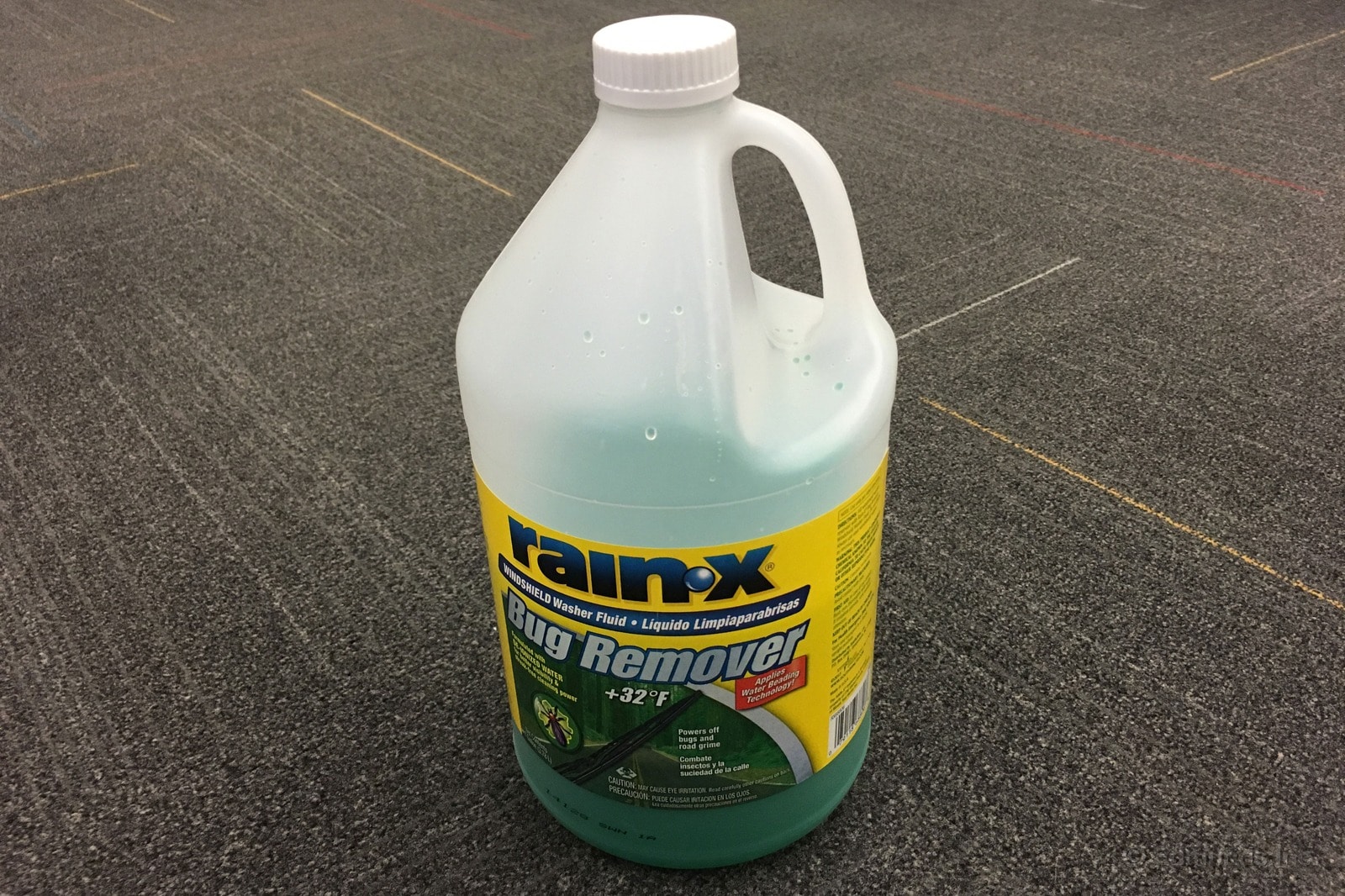
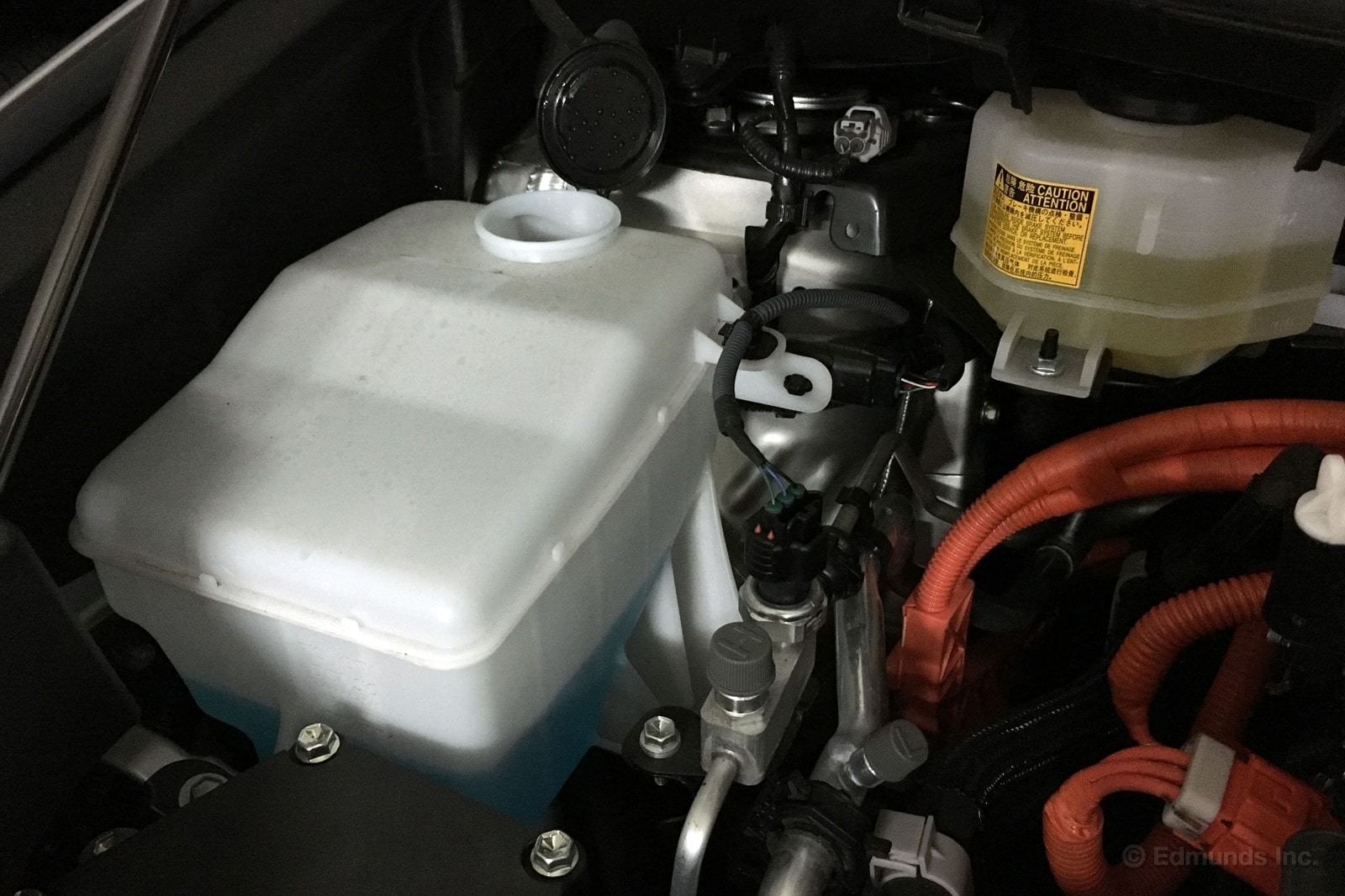
The wiper fluid reservoir was easy to find under the hood. It's tucked near the firewall on the passenger side. Less than a gallon satisfied the warning light. Case closed. It's Miller time.
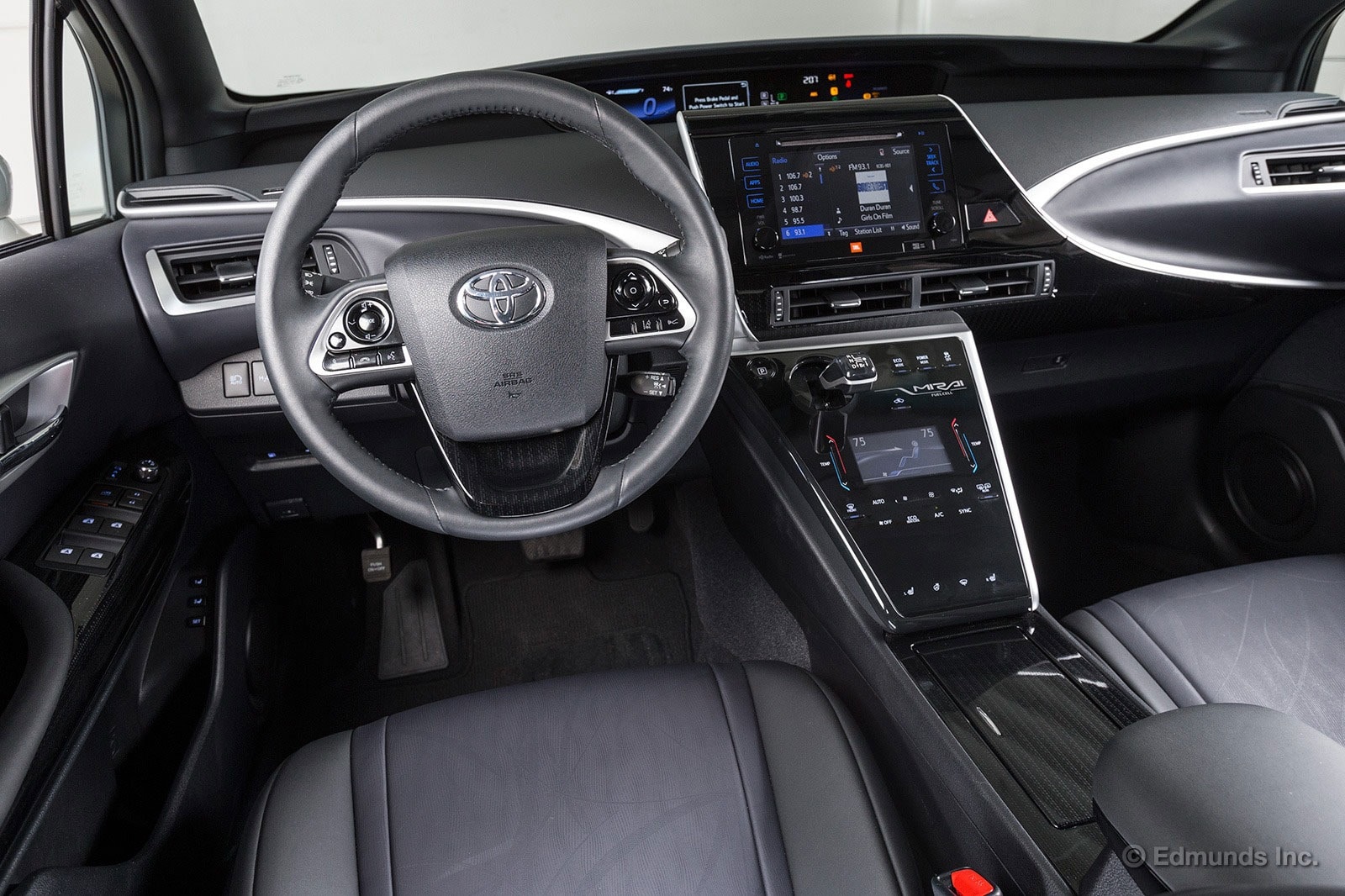
Heavy steering can be good. And heavy steering can be bad. In the case of the 2016 Toyota Mirai it is both. Let me explain...
At highway speeds a nicely weighted steering wheel provides stability. Additional heft filters out unintentional inputs and seems to better keep the car tracking straight. And fewer steering corrections equates to more driver stamina and comfort. The Mirai does that right.
In low-speed situations a heavily weighted steering wheel is a negative attribute. Here the Mirai misses the mark. It requires a concerted effort to turn into parking spaces, for example. On multiple occasions the effort was such that I had to crank overly hard on the wheel to complete even simple maneuvers.
Not helping matters was the turning radius. It's big. The Mirai regularly forced me into five-point turns that other cars this size do in three.
Combined, the steering heft and large turning circle make the Mirai hard to park and generally cumbersome to maneuver in tight quarters. After a week in the Toyota I found these driving characteristics to be my least favorite. That is all.

I was the last one to make it out of the house this morning, and as I walked through the garage, I found my kid had already taken my spot in the passenger seat of our long-term 2016 Toyota Mirai.
Ed and I were dropping her off just a few miles down the road, so rather than ruin both our mornings by issuing a firm "Move your butt" command, I climbed into the backseat instead.
What I found was a pleasant surprise.
Sitting behind the 5-foot 5-inch Emma, who of course hadn't moved her seat forward to accommodate her 5-foot 7-inch mother, I realized I had plenty of room for both my knees and my feet. So much in fact, that I allowed my laptop bag to share my footwell.
The Mirai's seats were also well-padded and comfortable, and the heated seat switch was an added bonus.
Who needs to ride shotgun, anyway?
Coming to Grips with Hydrogen Fuel Economy
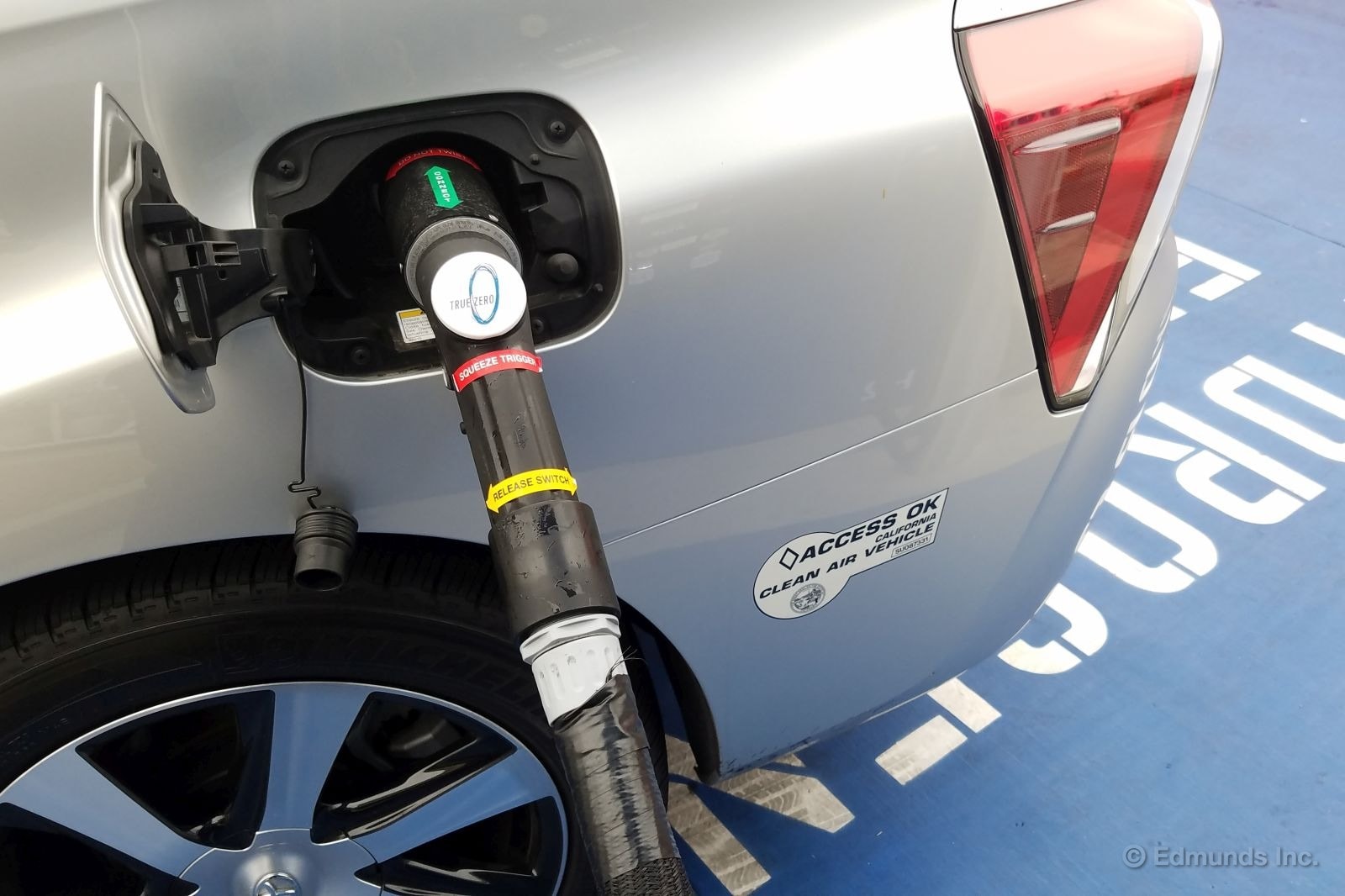
Our 2016 Toyota Mirai is a unique machine powered by an unfamiliar fuel — hydrogen. How far can it go? What is the consumption like? These are among the many questions we wanted to answer.
Let's get started.
The Mirai is easy enough to fuel up. It takes about as long as a gasoline fill-up — five minutes — and the equipment isn't hard to use. And although hydrogen cars are still in their infancy, finding a station hasn't been too much of a problem. There are two near the office, one about halfway along my commute home, one near the John Wayne Orange County airport I frequent and another out near where we test cars. I have a decent array of choices, in other words, and I've never encountered a wait at any of them.
So refueling hasn't been a huge issue, Jay's saga notwithstanding. The concerns boil down to the usual ones: fuel consumption and range. (I'll tackle cost in a future post.)
The Mirai's EPA consumption rating is 67 mpg-e, where the "e" stands for gasoline gallon equivalent. But what is the hydrogen equivalent? How is it sold? It turns out that 1 gallon of gasoline is equivalent to 1 kilogram of hydrogen, and hydrogen fuel pumps display the amount dispensed in kilograms.
What this means is that the Mirai's 67 mpg-e rating translates to 67 mpkg. And since the pumps sell it in kilograms, the math required to figure fuel economy is utterly familiar. Simply pretend you are buying gallons and proceed as normal. Handy.
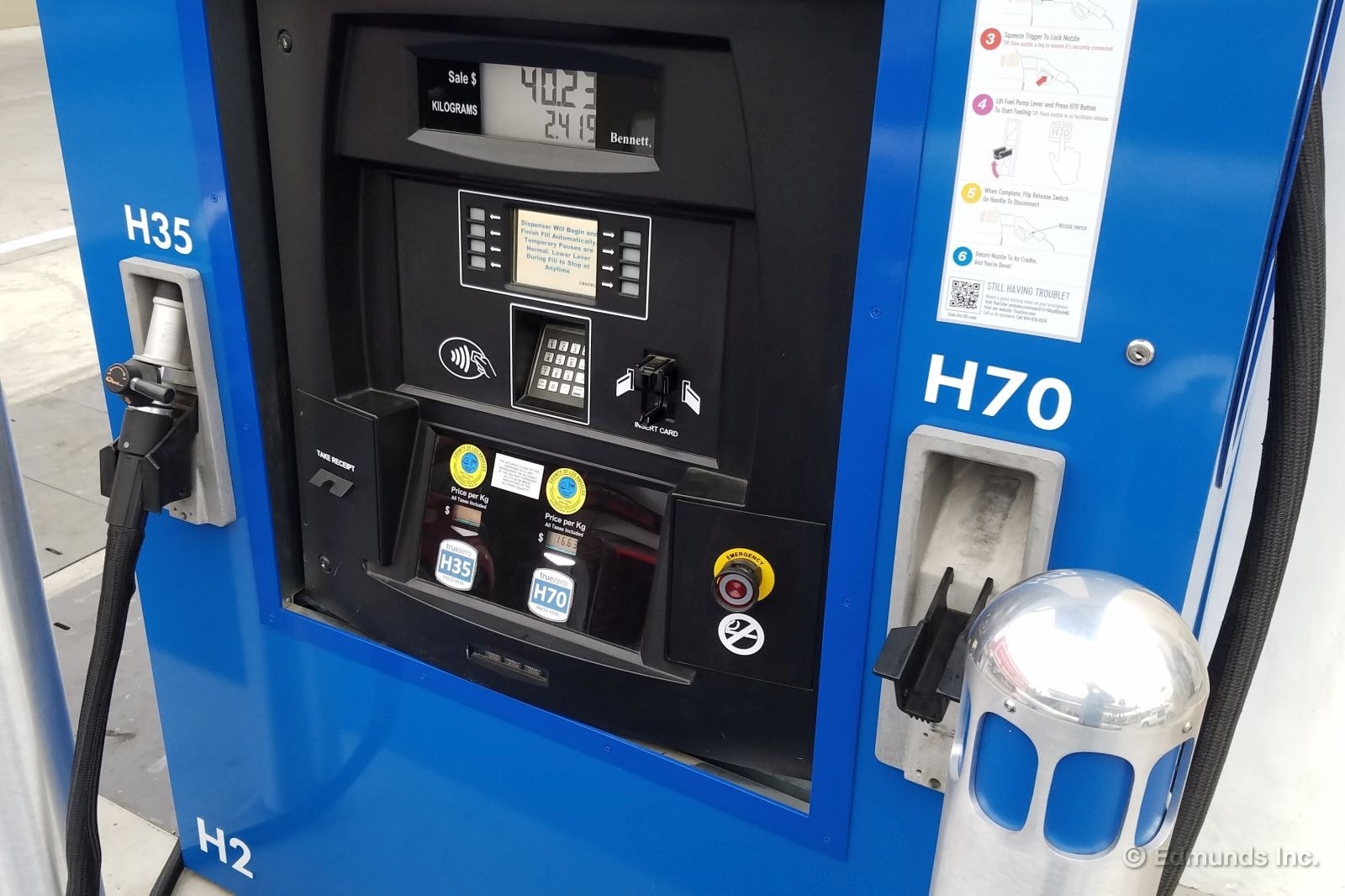
Through the end of July we've amassed over 5,000 miles and refueled our Mirai 24 times using six different stations — the five I rattled off plus another one closer to downtown LA.
The Mirai's tanks (there are two) hold just under 5 kilograms of hydrogen at a pressure of 70 MegaPascals, which is 10,000 psi. Hydrogen pumps serve up two choices: H70 (70 MPa or 10,000 psi) or H35 (35 MPa or 5,000 psi). Since a gas always completely fills the tank it is housed in, in gasoline liquid terms you can think of an H70 fill as a full tank and an H35 fill as a half tank.
There's no reason to use the H35 pump when filling a Mirai, in other words. Not unless the H70 one is broken.
With a tank filled with the H70 pump, the Mirai's range is rated at 312 miles. We've not yet run it down to empty, but we have come fairly close. Our best range was 245.2 miles, and we've driven more than 230 miles a couple of other times. The distance we've covered has thus far been dependent on when we've been in the neighborhood of a pump.
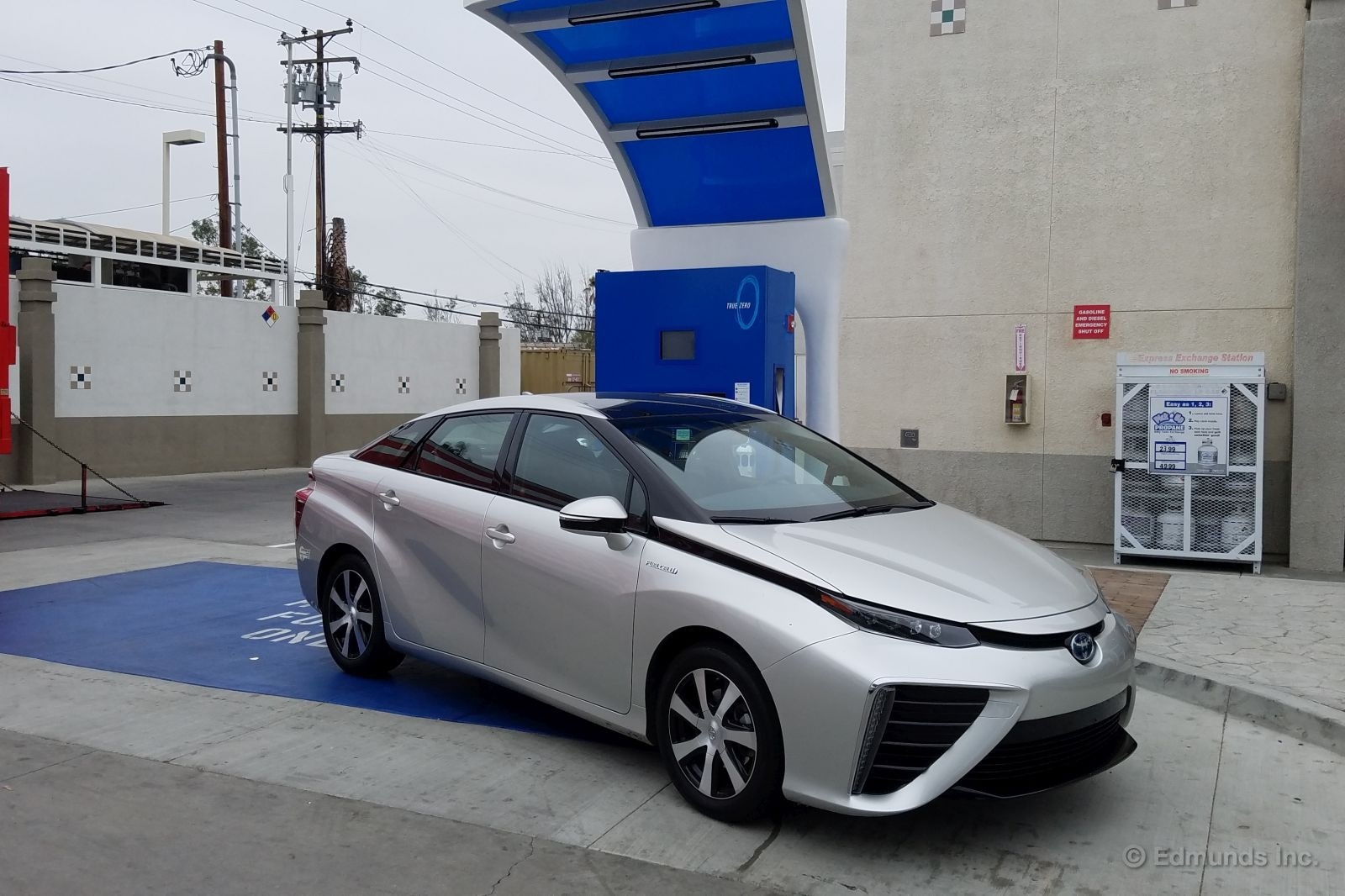
I'll give you the numbers earlier than usual, because there's a lot to talk about.
Worst Fill MPKG: 41.9
Best Fill MPKG: 74.3
Average Lifetime MPKG: 56.7 (1.8 kilograms per 100 miles)
EPA MPKG Rating: 67 Combined (67 City/67 Highway)
EPA Range Rating: 312 miles
Best Range: 245.2 miles
Current Odometer: 5,190 miles
Our best tank of 74.3 mpkg beat the rating by 11 percent, which illustrates the elevated potential of a relaxed driving style. On the other end of the spectrum, our worst tank of 41.9 mpkg occurred at the track as we were busting out several wide-open acceleration runs. By all rights it should have been worse. The Diamond Bar hydrogen station we used is about 10 miles from the track, which means this mpkg figure was buoyed by 20 sedate freeway miles that the gasoline-powered cars that visit the track don't get (we refill them immediately before and after testing).
Overall, our Mirai's average observed fuel consumption of 56.7 mpkg lags 15 percent behind its rating. We're using 1.8 kilograms of fuel every 100 miles instead of 1.5 kilograms per 100 miles, in other words. That's partly because our all-new Mirai has attracted a lot of attention from Edmunds execs, and most of them live in very congested areas. Yes, the Mirai's city, highway and combined ratings are equal, but navigating West LA traffic can be a cutthroat business.
At this point it's looking like hard driving may punish the Mirai's fuel consumption as much as an easygoing and relaxed approach can reward it. But we need to investigate further. A pump located near Harris Ranch makes it possible to get to San Francisco, Sacramento or even Lake Tahoe and back. Look for someone to make one of those runs in the near future.
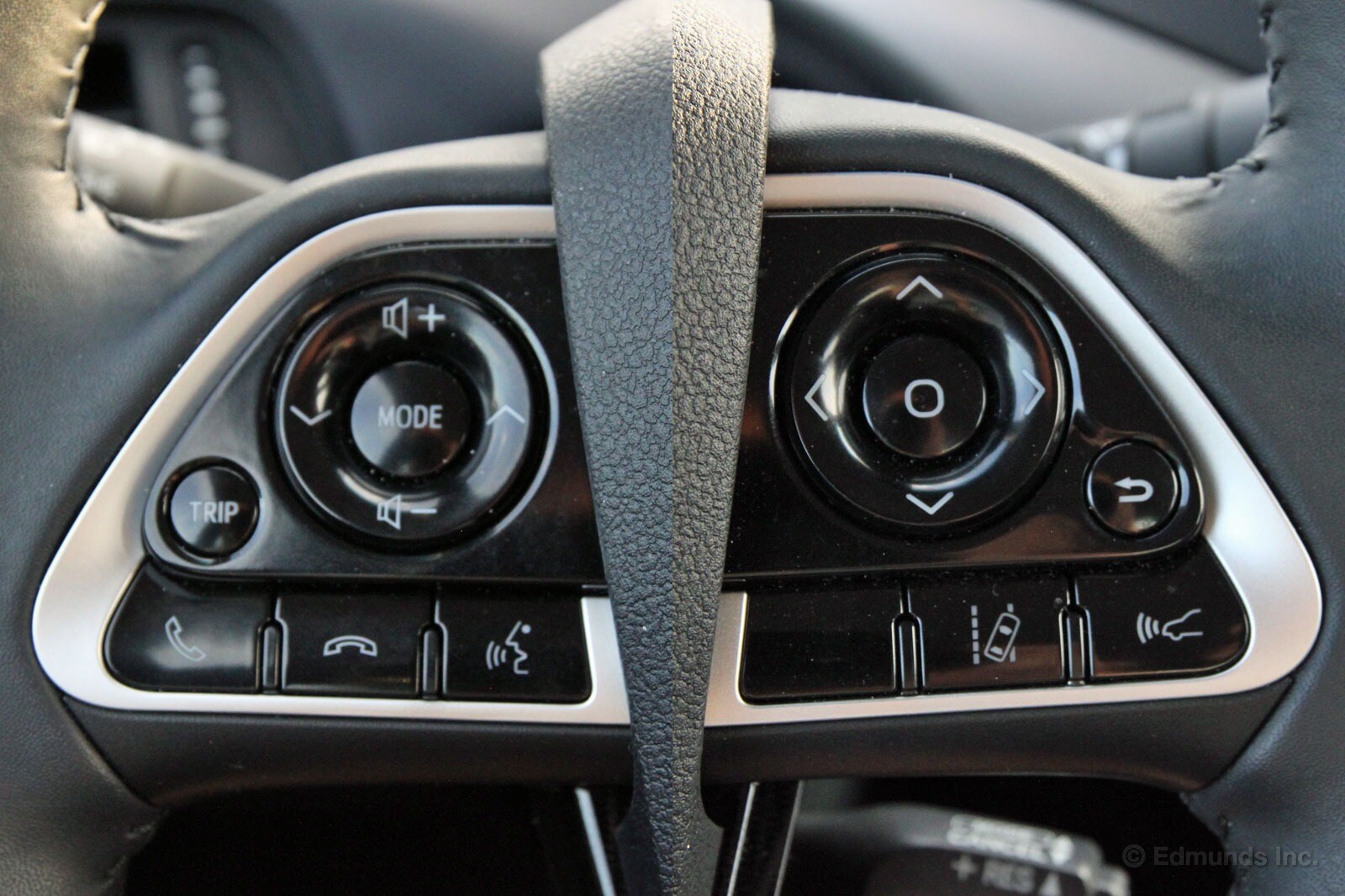
If you like futuristic touchscreen controls, you'll love the 2016 Toyota Mirai. It has them in spades, even where you don't want them. Thankfully, there are some redundant controls on the steering wheel that use actual buttons.
Are they enough to make up for the clumsy touchscreen on the center stack? Uh...sometimes.
When it comes to controlling the audio system, the buttons on the left side of the wheel work just fine. You get the all-important volume control (which thankfully gets a knob on the dash), a source button for switching between the radio and a podcast, and seek arrows for moving through tracks.
Then there's the buttons at the bottom for answering and ending phone calls, plus the oddly placed trip-computer toggle button. Why the designers felt the need to put that on the steering wheel is a mystery.
The other side of the steering wheel is a little less useful. It's basically like a joystick for cycling through the menus on the dashboard display. It works fine if you're not moving and can concentrate on the display, but out on the road it's not all that handy. Seems like something more useful could have gone here. Oh, and the buttons at the bottom toggle the lane-departure system on and off, along with adjusting the collision-avoidance sensitivity. Again, controls that could have probably lived elsewhere.
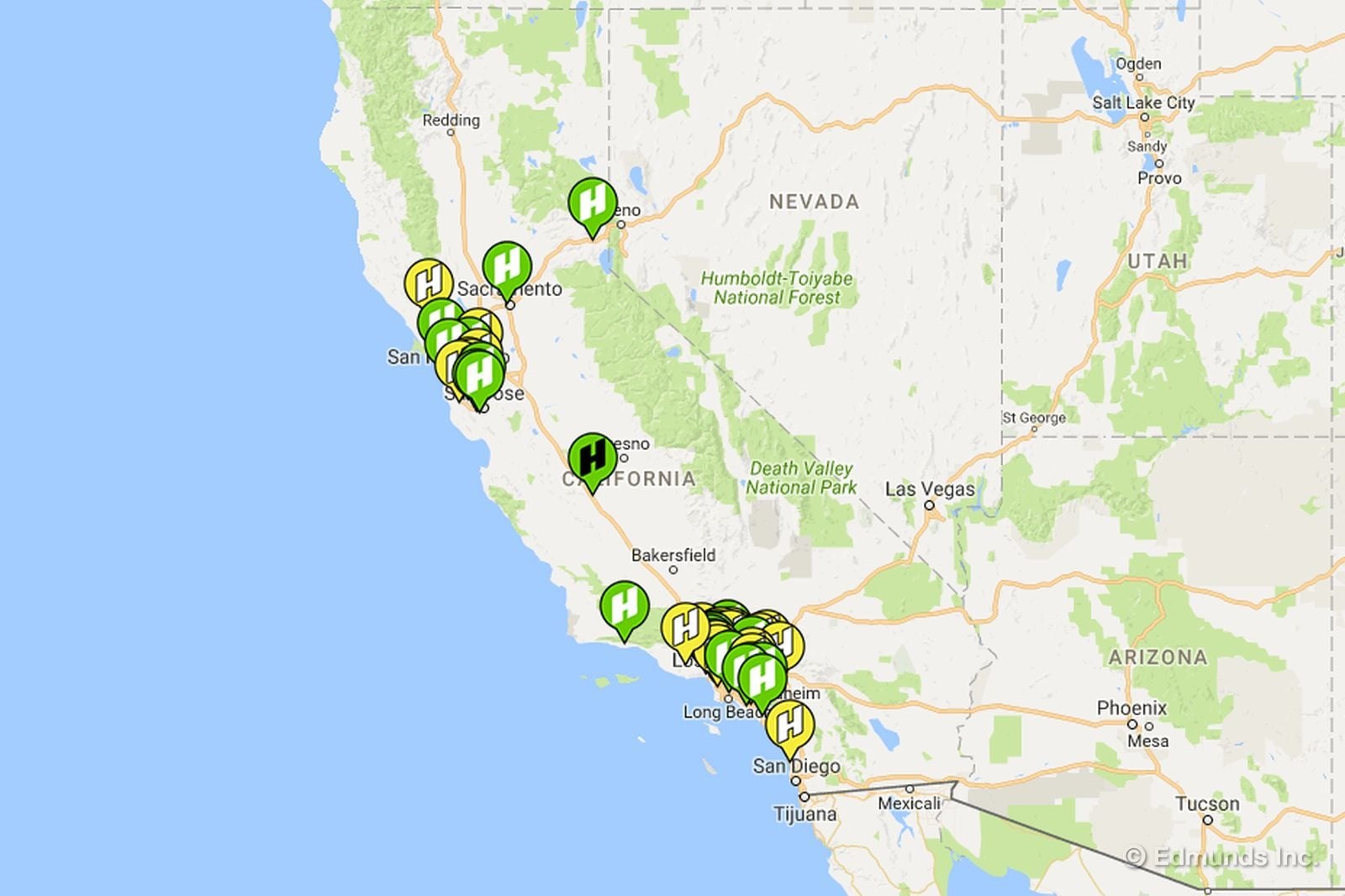
In response to my last post, a commenter pointed out our 2016 Toyota Mirai lives in a bubble. That's absolutely true. The state of California is pushing hard for hydrogen development, so that's where the main action is.
The effort is being shaped by the California Fuel Cell Partnership (CaFCP), an organization that describes itself as "a collaboration of auto manufacturers, energy companies, fuel cell technology companies and government agencies." Their plan: develop and commercialize the technology with the goal of making it financially viable at some point down the road.
To do that it is necessary to have cars on the road and stations to refuel them. Many lessons must be learned. Everyone needs to see that it really can work. This has been going on in the background for some years with CaFCP member fleet vehicles and private pumps.
The Mirai and those that will soon follow represent the beginning of the next phase: private customer cars and public refueling stations.
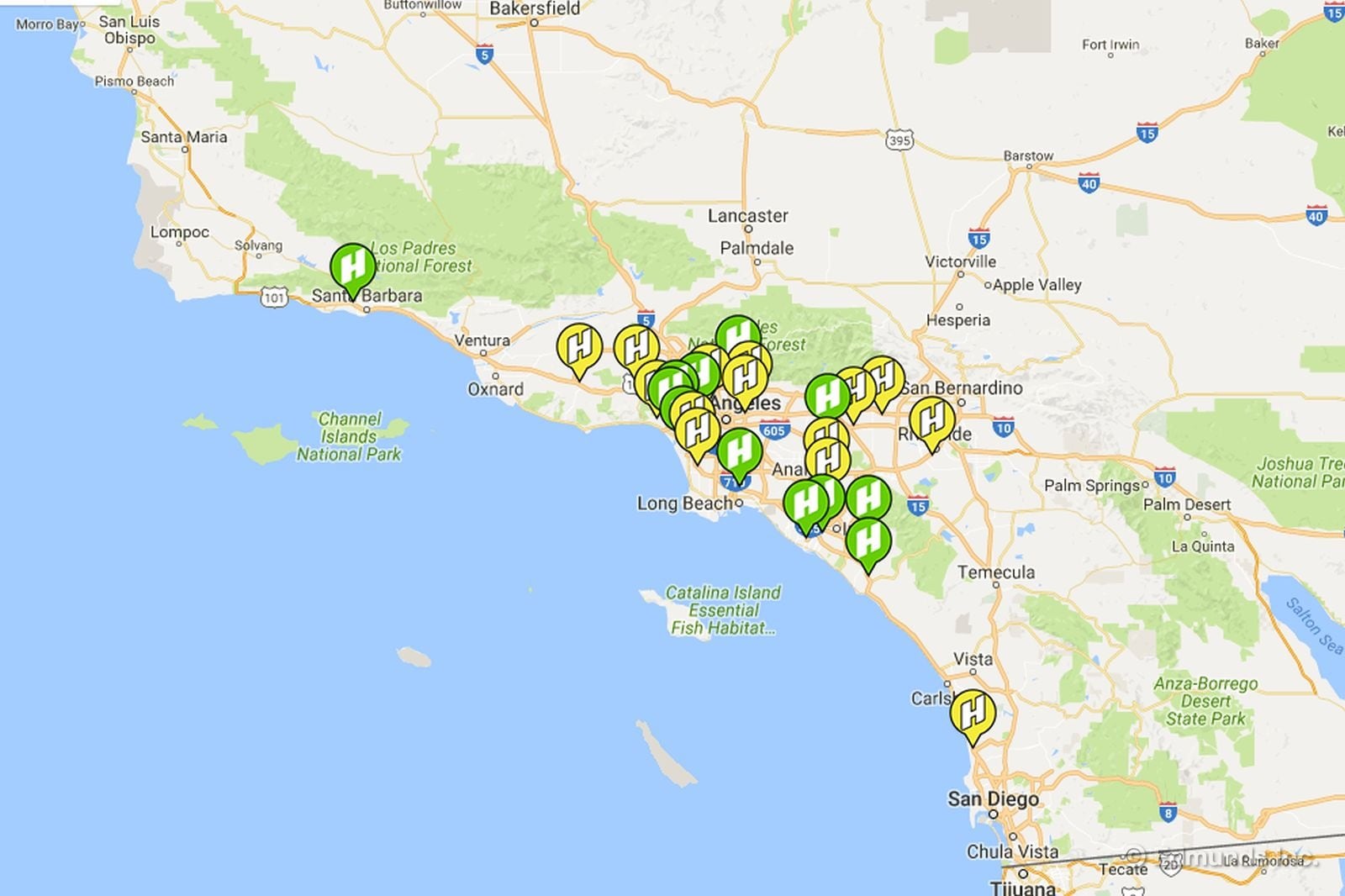
The public refueling stations we've been using to refuel our Mirai are among the green pins shown on these maps. The yellow ones are "coming soon" locations that are slated to open between now and next summer.
So the Mirai currently lives in two bubbles, one centered around Los Angeles and Orange counties and another around the San Francisco Bay area. Depending on how you count and where you draw the lines, the 2010 census says those areas contain 20.5 million people. If Mirailand were a country it would rank 58 out of 234 in terms of population.
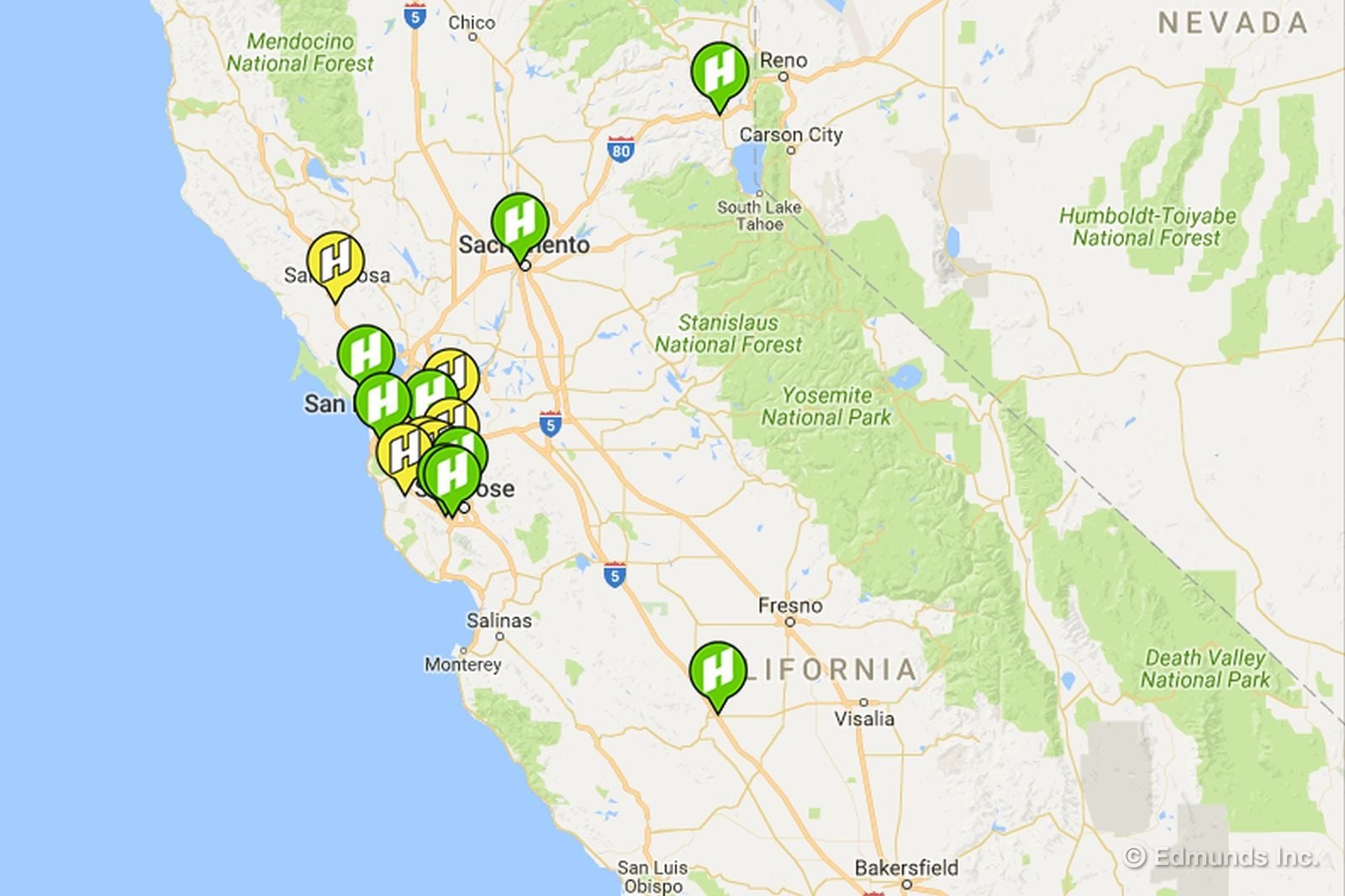
And that population will soon grow. The northeast is next. Early 2017 marks the start of a plan to construct 12 stations across five states: New York, New Jersey, Rhode Island, Connecticut and Massachusetts.
I'm reminded of the Tesla Supercharger network. When we first got our Model S there were maybe six of them, and we were all excited about the prospect of driving to Lake Tahoe. I was able to drive it to Oregon the following Christmas, and six months after that Kurt and I drove our Model S cross-country to New York and back. Today most anyone in the US can drive their Tesla just about anywhere, including the Florida Keys.
Electricity has the advantage of being everywhere. Find a location, do a deal, pull some permits, hire an electrician and you're off and running.
But hydrogen has to be produced elsewhere trucked in. Come to think of it, so does gasoline. The difference is down to the cost and well-to-wheels cleanliness of making the fuel. Consumer demand and economies of scale will move those efforts forward, so wheels on the ground is what it's going to take to get this bubble to expand to the point where it envelops the entire continent.
Hydrogen is Ridiculously Expensive, or Free
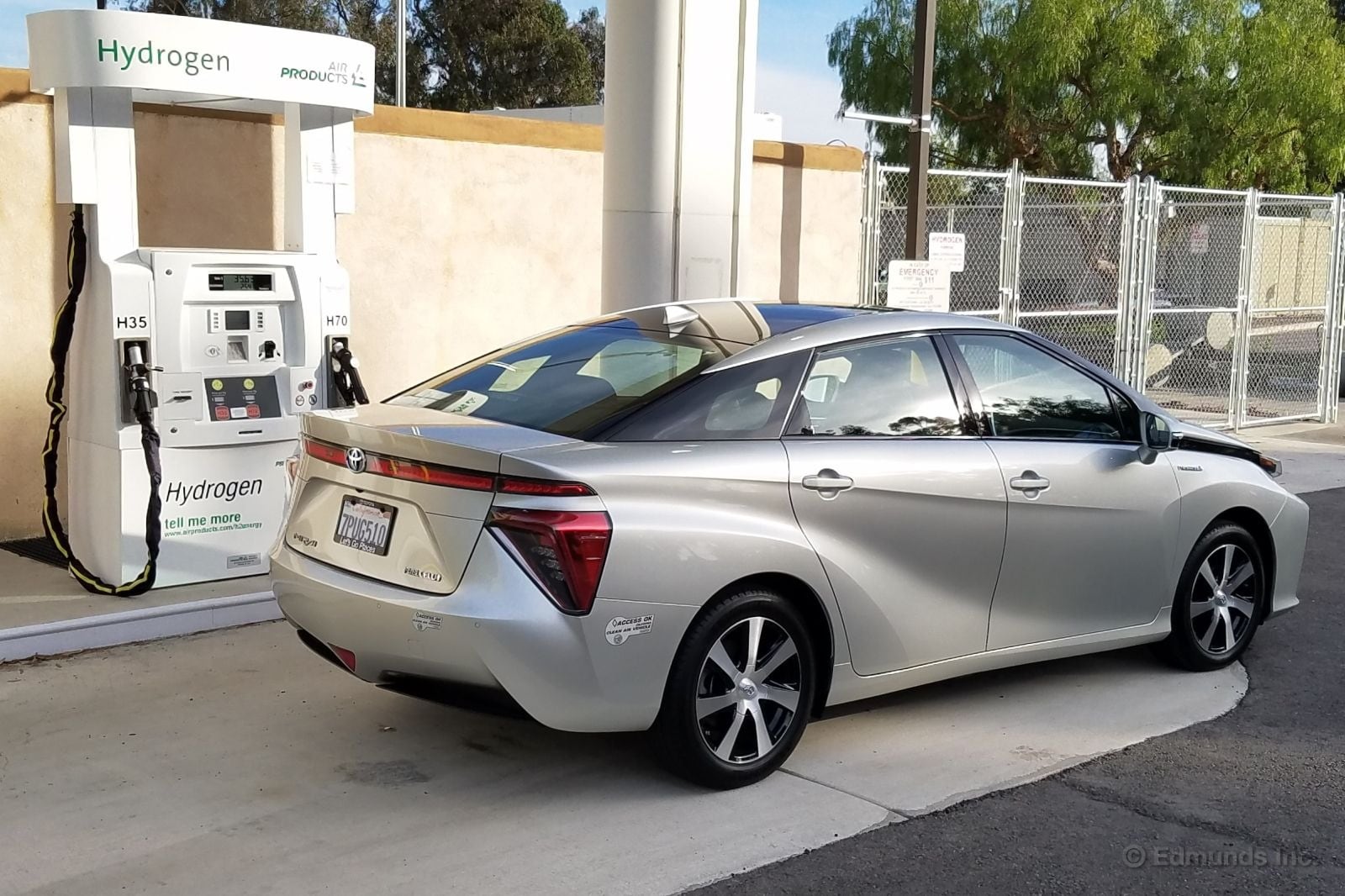
We have refilled our 2016 Toyota Mirai over two dozen times at a half-dozen pumps. Even though the car is powered by electric motors, filling it is very similar to filling a gasoline-powered car.
What's different is the price. Hydrogen is ridiculously expensive.
Or it's free!
Let me explain.
The price at the six stations we've visited has ranged from $12.85 per kilogram to $16.63 per kilogram. That's a big difference, one I cannot easily explain. Local taxes and/or subsidies, I suspect. It seems to vary by city limits. Either way, this fuel is frighteningly expensive.
The Mirai is rated at 67 mpg-e. As I have often said, mpg-e is a bogus way to estimate an alt-fuel car's cost of operation if you use mpg as a shorthand for dollars and cents. The mpg-e equivalency is only meant to convey the energy content of the fuel, not how much it costs. Hydrogen makes that point very clear.
The truth starts to emerge when we turn mpg-e into cost per mile. After that we can convert that back into what I call mpg-c in order to characterize the Mirai's performance using mpg as a cost yardstick.
Behold, the math.
As it happens, 67 mpg-e is equal to 67 mpkg of hydrogen. Assuming you achieve that mileage, divide the per-kilogram price by rated mpkg to get cost per mile. Hydrogen bought at $12.85 per kilogram in Santa Monica works out to 19.2 cents per mile. The more expensive price of $16.63 they charge in Long Beach boils down to 24.8 cents per mile.
Now let's look at a garden-variety 2016 Toyota Prius. That car is rated at 52 mpg on regular gasoline. Today's national average price for regular is $2.141 per gallon. That works out to just 4.1 cents per mile.
Yeah.
This is where it gets fun. Pretend the Mirai's per-mile costs were incurred by a gasoline-burning car. What mpg would that gasoline car have to achieve to rack up the same cost per mile? That result is what I call the Mirai's mpg-c. That number changes with the cost of the fuel, so we'll get different results for Santa Monica and Long Beach. This cost sensitivity is why it's not practical to put mpg-c on a window sticker.
Anyway, the 19.2 cents per mile that our Mirai costs in Santa Monica represents the same drag on your wallet you'd get from your gasoline-burning car if it achieved 11.2 mpg. At the Long Beach price (24.8 cents per mile), the Mirai costs the same to run as a gasoline-burning car that gets 8.6 mpg.
What car is as bad as that? I couldn't find one. The 2015 Bugatti Veyron is rated at 10 mpg combined. The Lamborghini Aventador is a comparative hypermiler at 13 mpg.
As for us, we're not quite hitting the 67 mpkg rating with our car, and we're filling up at a variety of stations with prices that range between the Santa Monica and Long Beach endpoints. Our overall average works out to 26 cents per mile, which is 8.2 mpg-c when compared to gasoline.
Note that none of these frighteningly low mpg-c figures say the Mirai is inefficient. What they say is hydrogen is very expensive.
Or it's not.
Buy or lease a Mirai and you'll get a gas card that gives you free fuel for three years. Like a Tesla's Supercharger electricity, it costs you nothing. In three years you get up to $15,000 worth, so you'd have to be a real leadfoot or drive a lot of miles — or both — to burn through all that. Competing fuel cell cars are set to offer the same deal.
After three years, though, you're on your own. Maybe the price will drop. Probably the price will drop. The future of hydrogen power depends on it. But by how much? Maybe it's better to lease this one. A lot can change in three years. Something better will come along. Something better-looking certainly will.
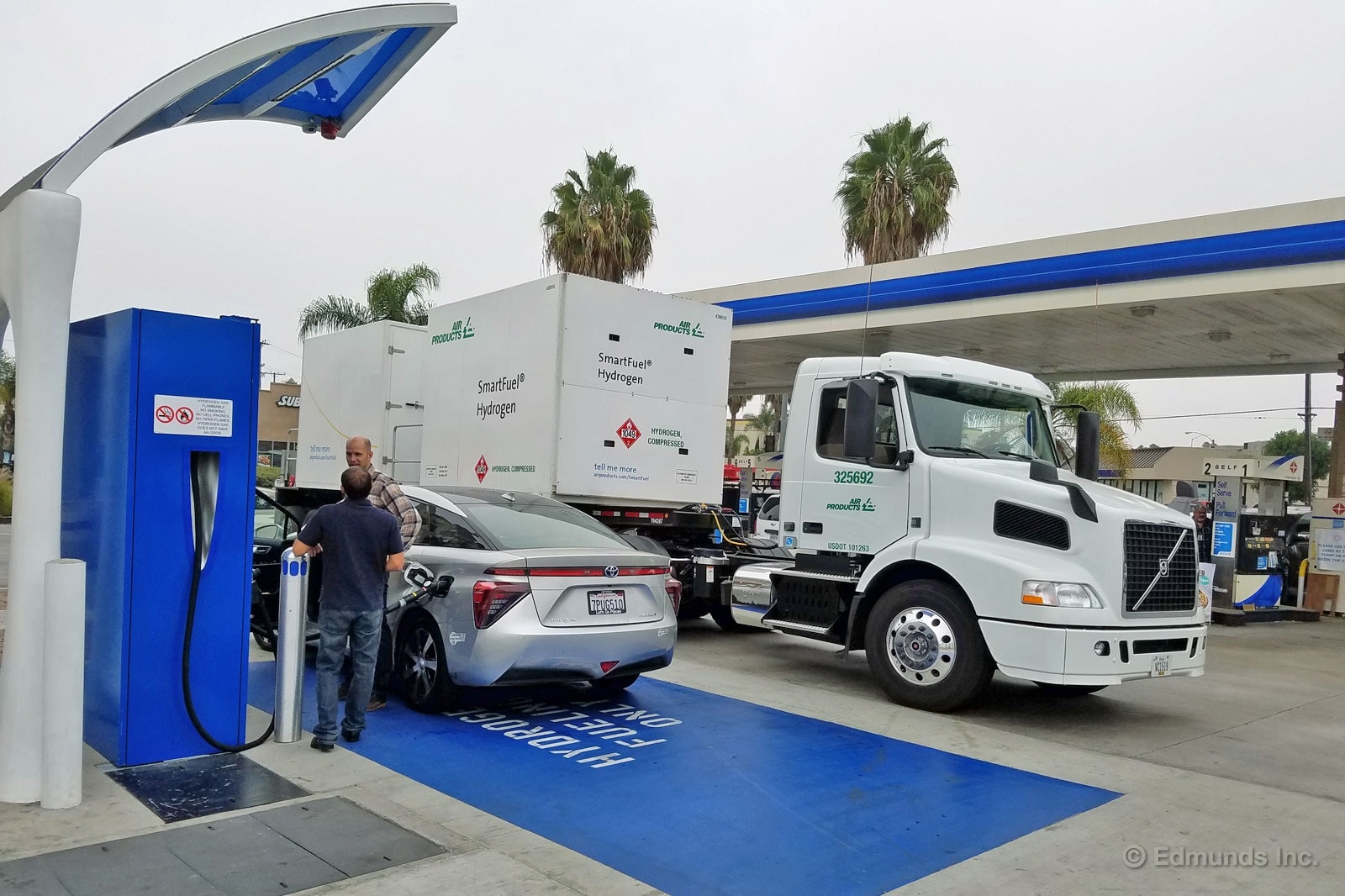
This morning I stopped at the hydrogen pump on Long Beach Blvd. to fill up and had a quick conversation with a representative of True Zero, the company that maintains the system. As I started the fill process, he came over to tell me that the pump was registering the wrong numbers on the screen, so he would have to take a minute to reset things.
As he was working on the system, I asked him how busy this particular station was compared to others in the area. He said it was the most popular station in their network. I wasn't that surprised given its central location and easy access off a busy freeway.
Just as he was finishing up, a hydrogen refueling truck pulled into the station. The company rep said it comes about once a week to replenish the supply. By the time the truck had maneuvered into place, I was topped off and ready to go. Another Mirai was pulling into the station as I pulled out, so I guess the guy wasn't exaggerating when he said it was busy. Then again, I saw two more Mirais on the way to the office, so we're clearly in the heart of Mirai country.
Hydrogen Highway vs. Tesla Supercharger Network
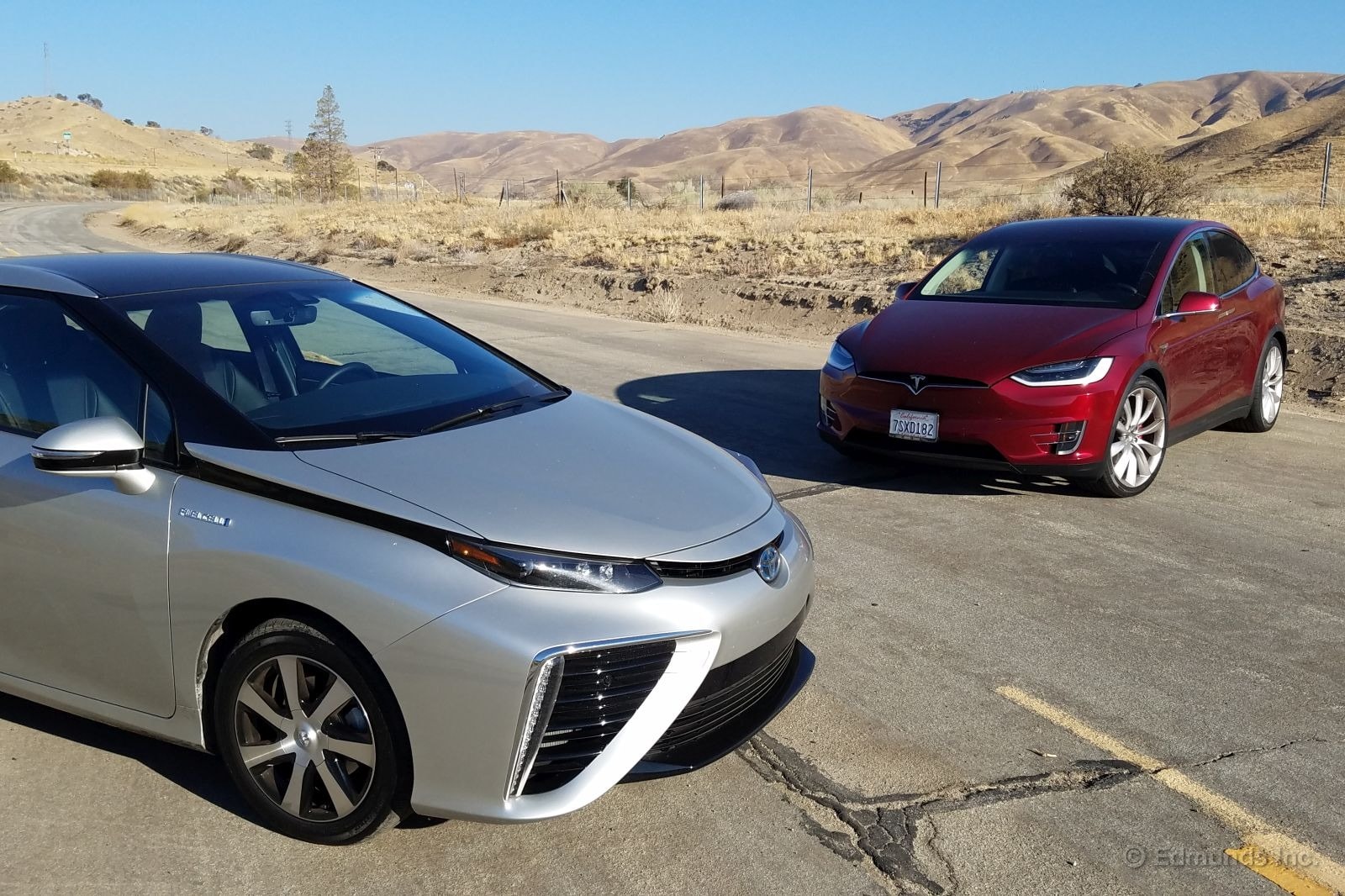
As far as road-tripping is concerned, our 2016 Toyota Mirai can only go where there are hydrogen filling stations. I recently described a clump of them in the LA basin and another cluster that serves the San Francisco area. There's also a lone station in a place called Coalinga that links these two regions, and another up near Donner Summit on the way to Lake Tahoe.
Turn back the clock to late 2012 and you'll see a map with just six Tesla Superchargers in more or less the same places. At the time, we marveled at how these revolutionary quick-charge stations would enable us to drive our newfangled 2013 Tesla Model S all the way to Lake Tahoe and back. Think of it!
You can see where this is going. Today's Hydrogen Highway is eerily similar to those early days of the Tesla Supercharger Network, and that realization recently prompted Jay Kavanagh and me to concoct a friendly contest. It's the 2016 Toyota Mirai versus the 2016 Tesla Model X, hydrogen versus electricity, fuel cell versus batteries. It's the Hydrogen Highway versus the Tesla Supercharger network.
Place your bets.
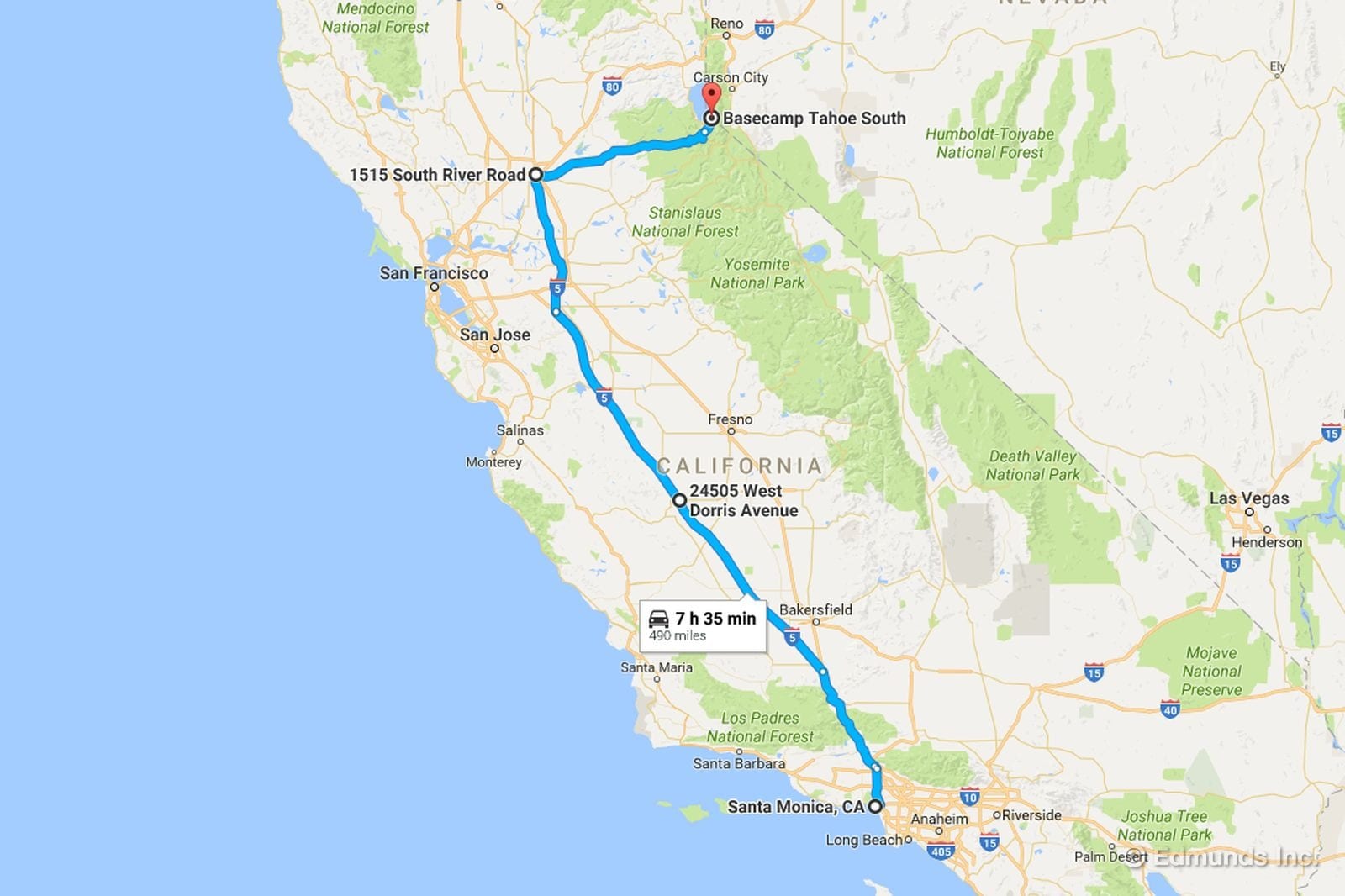
The destination: the Basecamp hotel in South Lake Tahoe. The rules: both cars will leave our Santa Monica offices with a full tank or battery (as the case may be), and Jay and I will travel along the same 487-mile route that's served by both networks.
The competing Coalinga stations are close enough for a stare-down across the parking lot, but we're not likely to see each other, because each of us will be free to run at whatever speed seems most prudent for the vehicle we happen to be piloting. And none of the other stations we'll hit will be nearly as close together as they are in Coalinga.
We've got some ideas on how we might change things up on the return leg of the contest, but we plan to see how it all unfolds on the trip north before we make any decisions.
Hydrogen vs. Electricity Road Trip to Lake Tahoe
It's 7:05 am as Jay and I climb aboard our mounts and back out of our respective parking spaces. At 7:07 am we're lined up outside the building, waiting for the first traffic signal of the trip to turn green. I'm piloting the 2016 Toyota Mirai and Jay is behind the wheel of our 2016 Tesla Model X. Both cars are filled with their respective fuels and headed for an eventual rendezvous at the Basecamp Hotel in South Lake Tahoe.
We merge onto the 405 freeway and maneuver ourselves to the carpool lane. For now we're queued up line astern, but we're bound to lose sight of each other once we reach a predetermined photo-op point on the outskirts of the LA Basin and start running at whatever speed each of us deems most prudent.
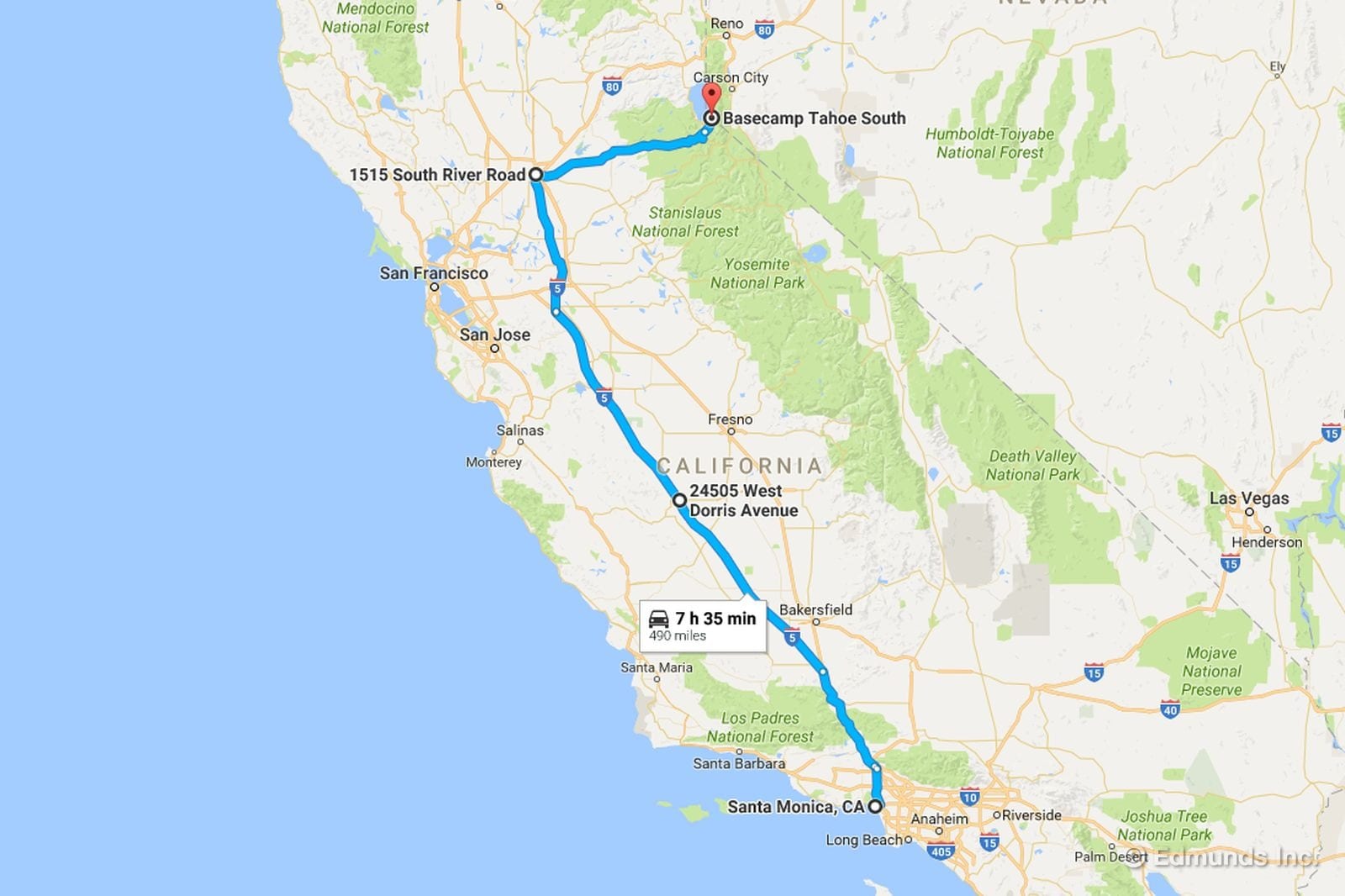
I'm not sure what Jay is planning in the way of fuel stops, but I'm 100-percent certain I'll be making just two of them. The first is 197 miles up ahead in Coalinga, California at Harris Ranch. No strategy is involved here; it's my first and only choice.
This should be easy, because the Mirai has a nominal range of 312 miles. That said, the road north out of LA leads up and over the Tejon Summit, a mountain pass of some 4,160 feet. I've never driven a fuel cell hybrid up such a long grade before. Will consumption go through the roof? I resolve to run no faster than 65mph on the way up and see how it goes.
It soon becomes clear that I have little to worry about. The range meter does not plummet as the Mirai silently wends its way toward the summit. A few extra miles melt away, but not many. There's hardly any drama at all.
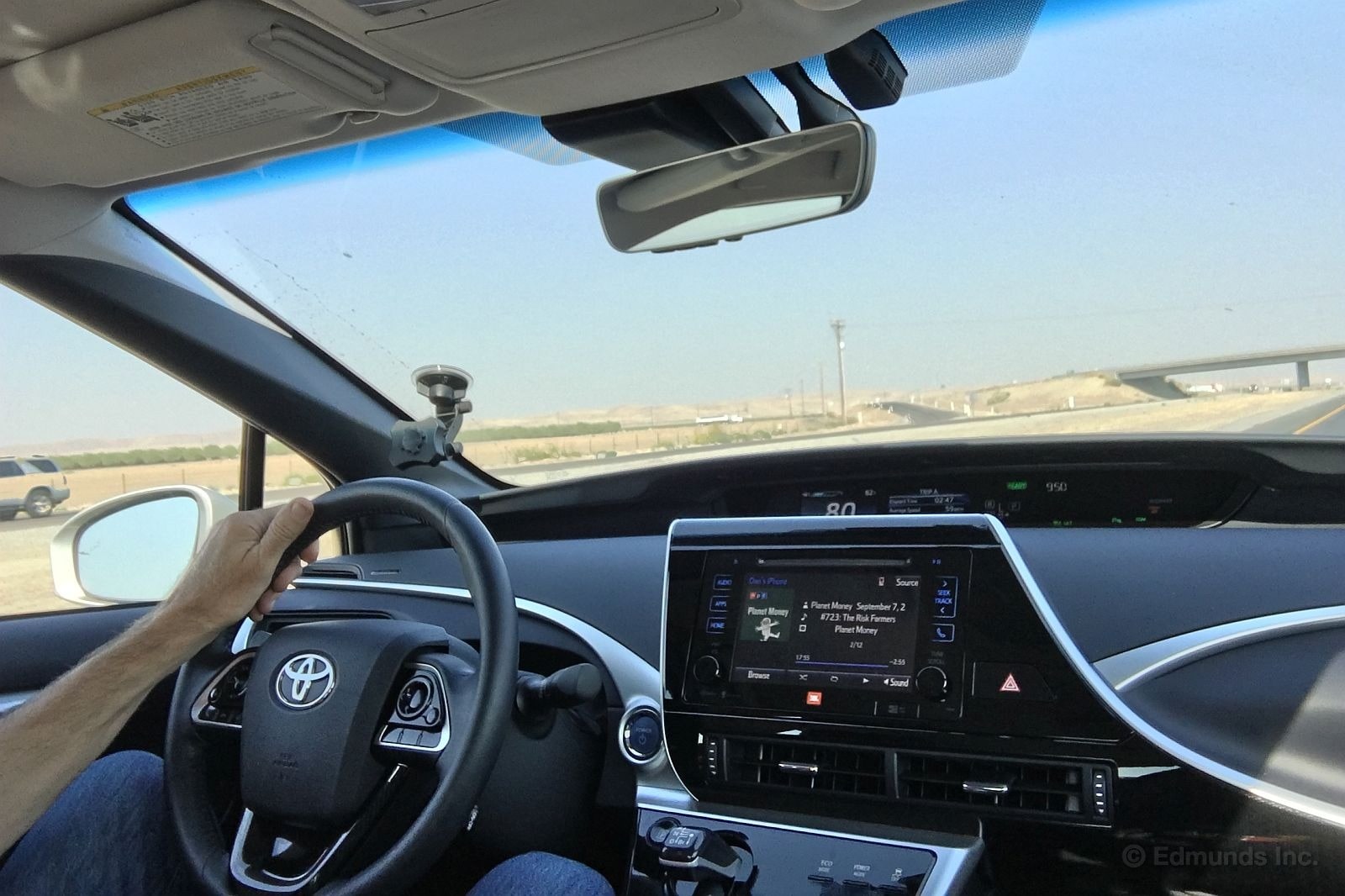
There's even less on the way down, where the question of consumption is moot. Soon I'm on the endless flat billiard table that is California's great central valley. As it usually does, the prevailing speed of the sparse traffic climbs almost immediately. The Mirai has no trouble keeping up, and it feels utterly composed and stable as I settle into a fast cruise.
I have no need to stop for provisions. I scarfed a bowl of cereal and filled an insulated mug with office coffee before we started. I take occasional sips of the still-hot brew and regularly scan the mirrors as my podcast backlog unwinds through the Mirai's speakers. This car is relaxing, steady, quiet, smooth...and utterly normal. Its most controversial weirdness is the exterior styling, which I cannot see.
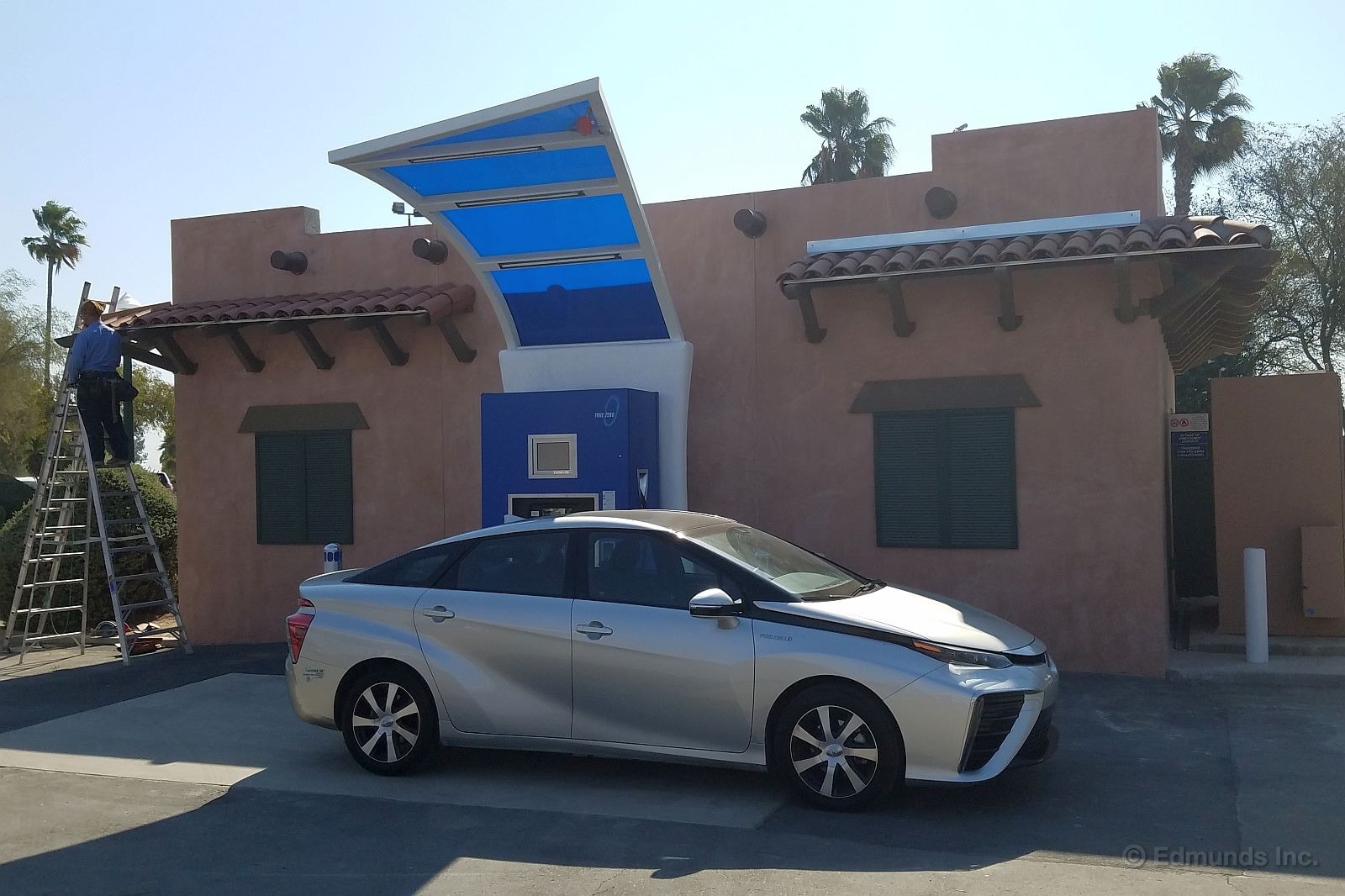
The Coalinga exit comes into view in what seems like no time at all. The map doesn't pinpoint the exact location of the Coalinga hydrogen station, but they're usually on the property of an existing gas station, away from the main pumps. I quickly spot the hydrogen dispensary attached to a small outbuilding on the corner of the Shell station's lot. No one is using it.
The hydrogen fill up takes exactly 5 minutes and 14 seconds, timed from the moment I open the door and step out to the moment I sit down and close it again. The process is much quicker than Supercharging a battery, and there's no point in doing anything other than a complete refill. No appreciable amount of time can be gained by employing the Tesla technique of prematurely terminating the fill as soon as the car has taken on enough to get to the next station.
As I get back on the road and up to speed, I start to wonder about Jay. I figure he's probably still plugged in and waiting somewhere as I sail up the interstate. The concept of my own range anxiety never once enters my mind. I am utterly unconcerned about the Mirai's chances of reaching the next hydrogen waypoint.
After all, my five-minute pause at the pump netted me an absolutely full tank good for another 300-plus miles. My next stop in West Sacramento is 186 miles ahead. But it soon becomes clear I'm not going to make it without stopping somewhere in between. It's the coffee. I pull off at the next rest area, then merge back into the fast-flowing stream of traffic.
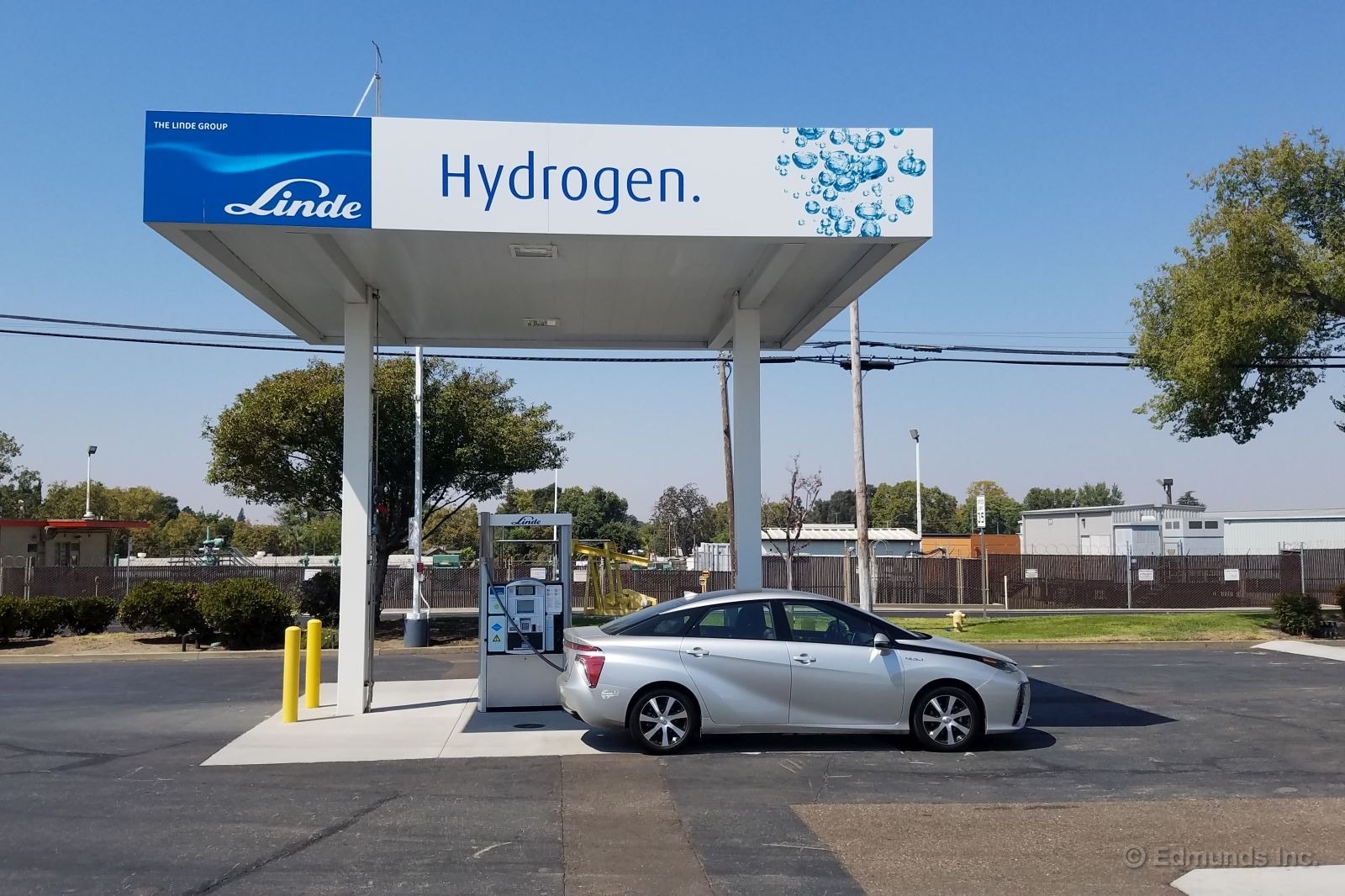
West Sacramento's hydrogen station is located a little ways off the beaten track in an industrial area. It's a cardlock diesel truck stop and an unmanned gas station. The place has E85 pumps, biofuel pumps and a CNG station in addition to the hydrogen I need.
This station requires me to watch an instructional video on the pump's screen before it will issue me a code number that I must then input before I can operate the pump. This first-timer video requirement drags my refueling session out to 9 minutes 40 seconds.
It's my last fuel stop, but this unmanned station has no Mini Mart. There are no food joints in sight, fast or otherwise. I'm going to have to stop again for lunch somewhere up the road. Jay may have an advantage here. Supercharging may take longer, but you can eat as the car charges. Supercharger travel is all about multitasking.
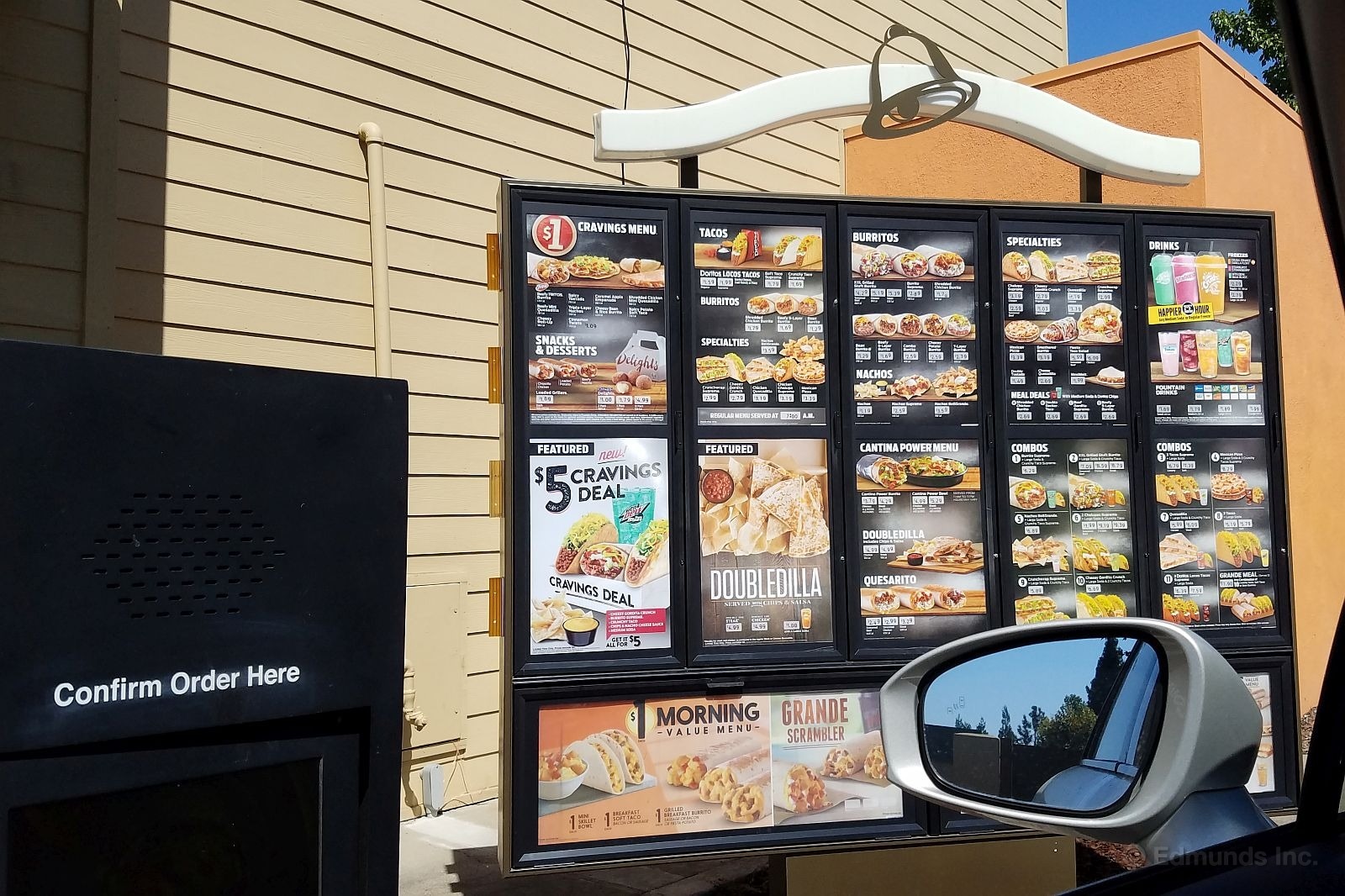
My destination at Lake Tahoe is now just 106 miles ahead. The road turns east as I transition onto Highway 50 and begin climbing into gentle rolling foothills that are the advance guard of the Sierra Nevada mountains. Jay is almost certainly behind me somewhere, but I might be wrong. I can't afford to mess about when I stop for my late lunch. At times like this there's just one answer: Taco Bell Drive-Thru.
A roadside sign gives away the location of one some 20 minutes later. As I wait in the line I have an epiphany: the Tesla app is on my iPhone! It can show me the current location and status of our Model X.
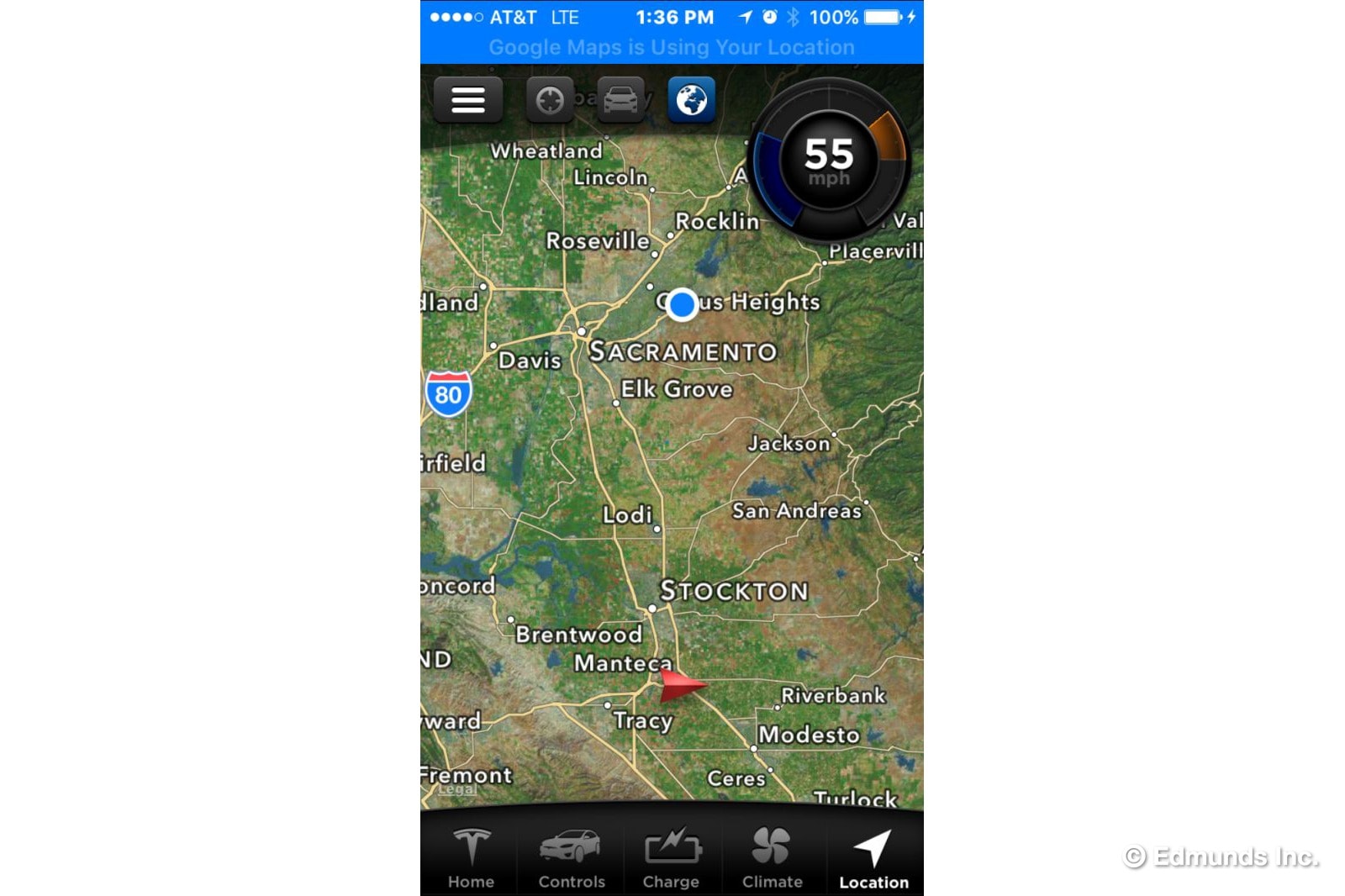
The blue dot that represents my phone's location is at least an hour ahead of the red arrow that shows the Model X's position. It shows that Jay is moving, but I can't tell if he has to stop again. I pay for the burritos and get back onto Highway 50 with a grin on my face.
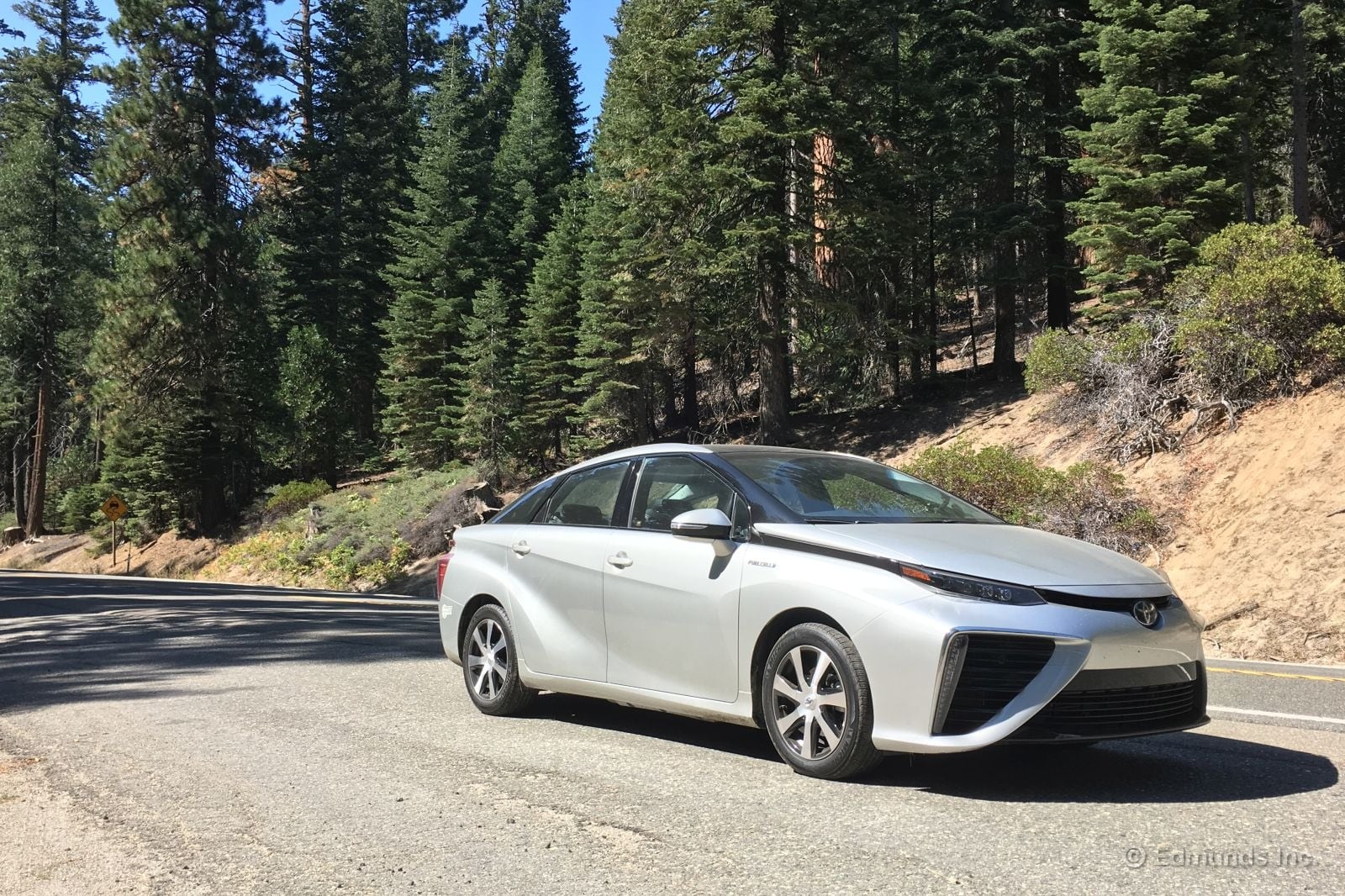
It's no contest, so much so that I risk a stop at a roadside point of interest for a couple of photos. Bridalveil Fall is quite lovely this time of year. A dozen miles later I stop again. Another peek at the Tesla app reveals that Jay has stopped at the Supercharger in Folsom. I am going to destroy him.
The road narrows to two lanes it climbs higher, and I soon get bottled up behind a caravan of tourists and a couple slow-moving trucks. But there are passing lanes, and the Mirai has more than enough sauce to make quick work of the slowpokes. Thinner high-mountain air can't siphon off power from an electric motor.
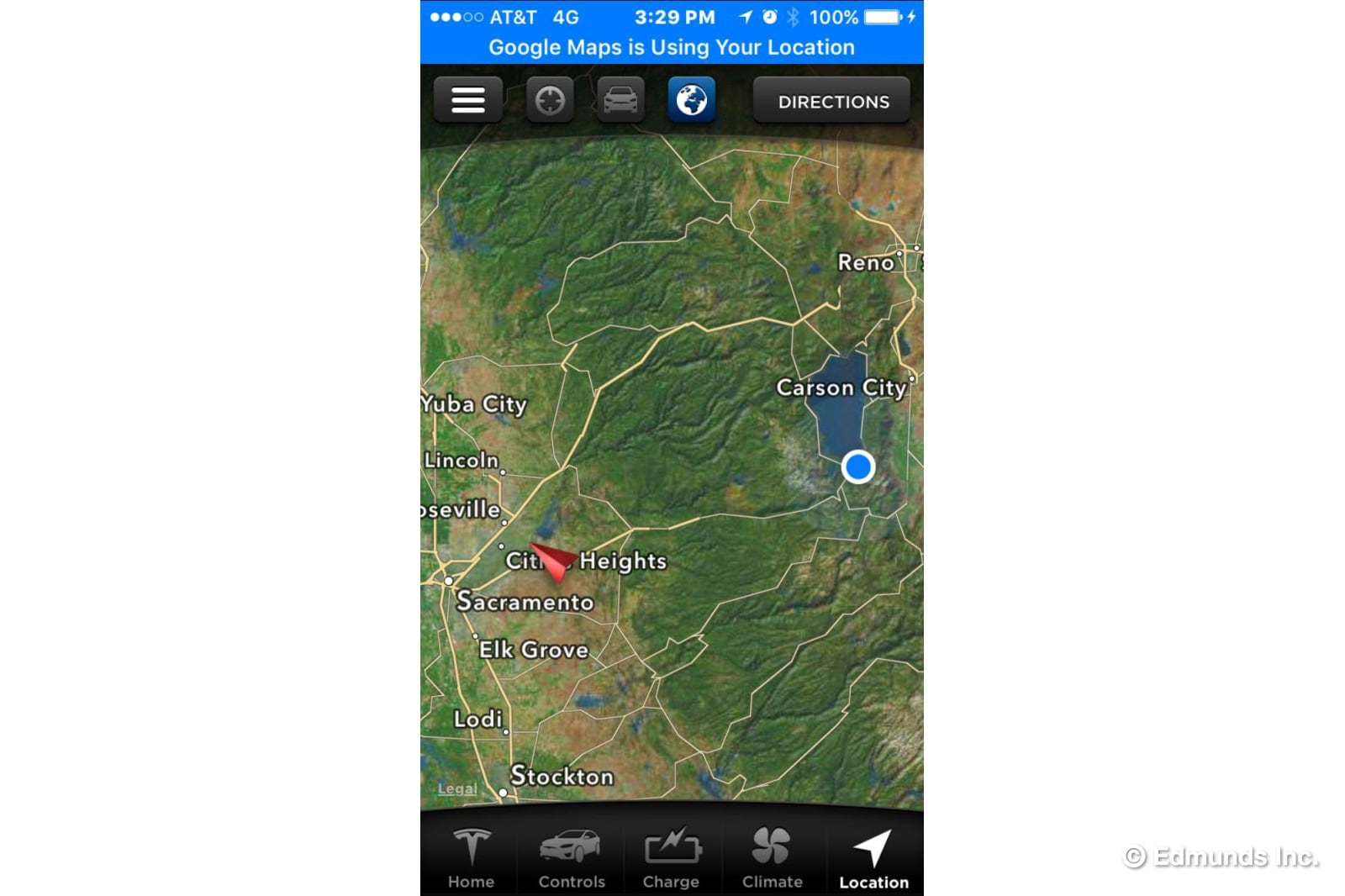
It's not long before I crest the summit and get my first glimpse of Lake Tahoe's shimmering vastness. From here it's all downhill to the Basecamp Hotel on the south shore. At this point I'm so far ahead that I decide to indulge in one of my geekier hobbies: I stop and take a short walk for a geocache. It takes less than 10 minutes. The arrow icon representing Jay's Tesla is still motionless at the Folsom Supercharger as I prepare to drive the final two miles to the hotel.
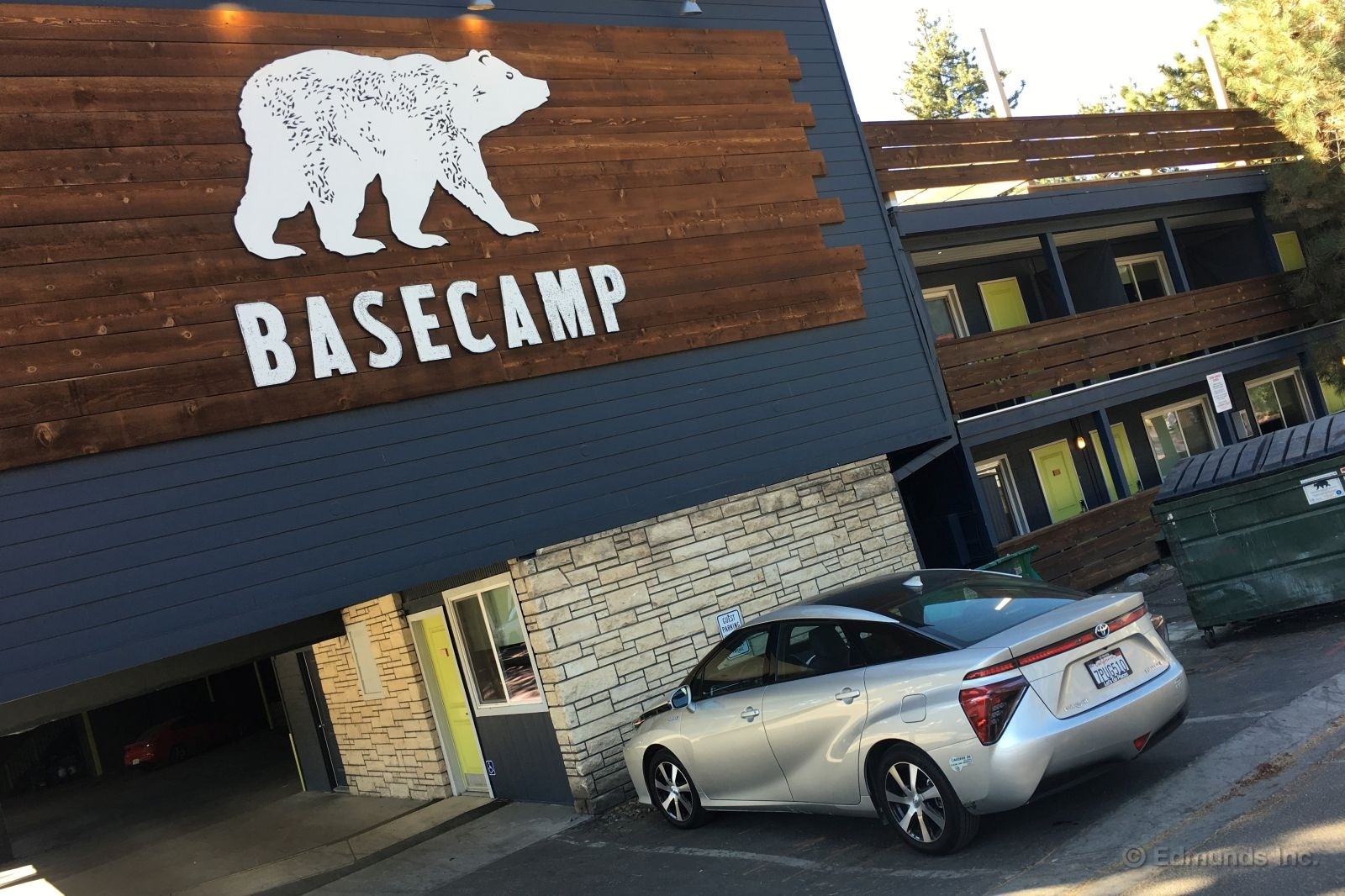
The clock on my iPhone reads 3:38pm as I nose the Mirai into the Basecamp hotel's parking lot, which is 8 hours and 33 minutes after Jay and I began our alt-fuel contest. The trip computer says I averaged 60 mph and the car was switched on for 7 hours and 57 minutes, which means I spent a total of 36 minutes outside the car.
Thirty minutes pass. No sign of Jay. I check-in and unpack my bags. The hour mark comes and goes. Still no sign of Jay.
He finally rolls up a full 90 minutes after I arrived. He's blown away by the magnitude of the gap, at which point I make sure to point out that it could have been 15 minutes worse if I hadn't chosen to make three superfluous stops after lunch.
Hydrogen won this contest because it essentially takes no more time to refill a Mirai than a Prius. The Tesla could only have been competitive if battery-switching technology had been available, a concept that Tesla has backed away from.
But forcing both vehicles to take the same route was certainly a best-case scenario for the Mirai, because the current Hydrogen Highway can't hold a candle to the Supercharger network. On the trip home we're going to let reality bite. The Tesla will be free to take the shortest route the Supercharger network can currently support — and it'll start off full, because the Basecamp Hotel has a Tesla destination charger.
The Mirai, on the other hand, will be too empty to return the way it came because of some sightseeing miles we'll add while we're here. It'll be forced to venture north to refuel at the Truckee, California hydrogen station before it can head for home.
Double or nothing?
Close Finish in Hydrogen vs. Battery Contest
For the return voyage on our alt-fuel road trip from Santa Monica to Lake Tahoe, Dan Edmunds and I switch cars. This time, I'll be in our long-term 2016 Toyota Mirai and he'll take the 2016 Tesla Model X.
There's a wrinkle, though.
The Tesla will be charting a different course. It will head south on I-395, a shorter route than taking I-5. It will do this because it can — there are Superchargers along I-395. There are zero hydrogen stations, however, so the Mirai can't take the shortcut. This factor will clearly give the Tesla an advantage it didn't enjoy on the inbound leg.
What's more, the Mirai won't simply be returning the way it came. It used up enough range while driving in the Lake Tahoe area (after the completion of our Santa Monica to Lake Tahoe "sprint") that it needs to be refueled in Truckee. Truckee is not on the way back to Santa Monica, but it is closer than Sacramento, home of the next-closest hydrogen station.
So, the Tesla will be taking a shorter return trip and the Mirai will be taking a longer one. This arrangement more accurately reflects the current reality of alt-fuel motoring. Moreover, the lengths of the two cars' routes differ by about 90 miles according to the map. Considering that the Mirai beat the Tesla by 90 minutes on the inbound leg, the outbound contest should be much more even.
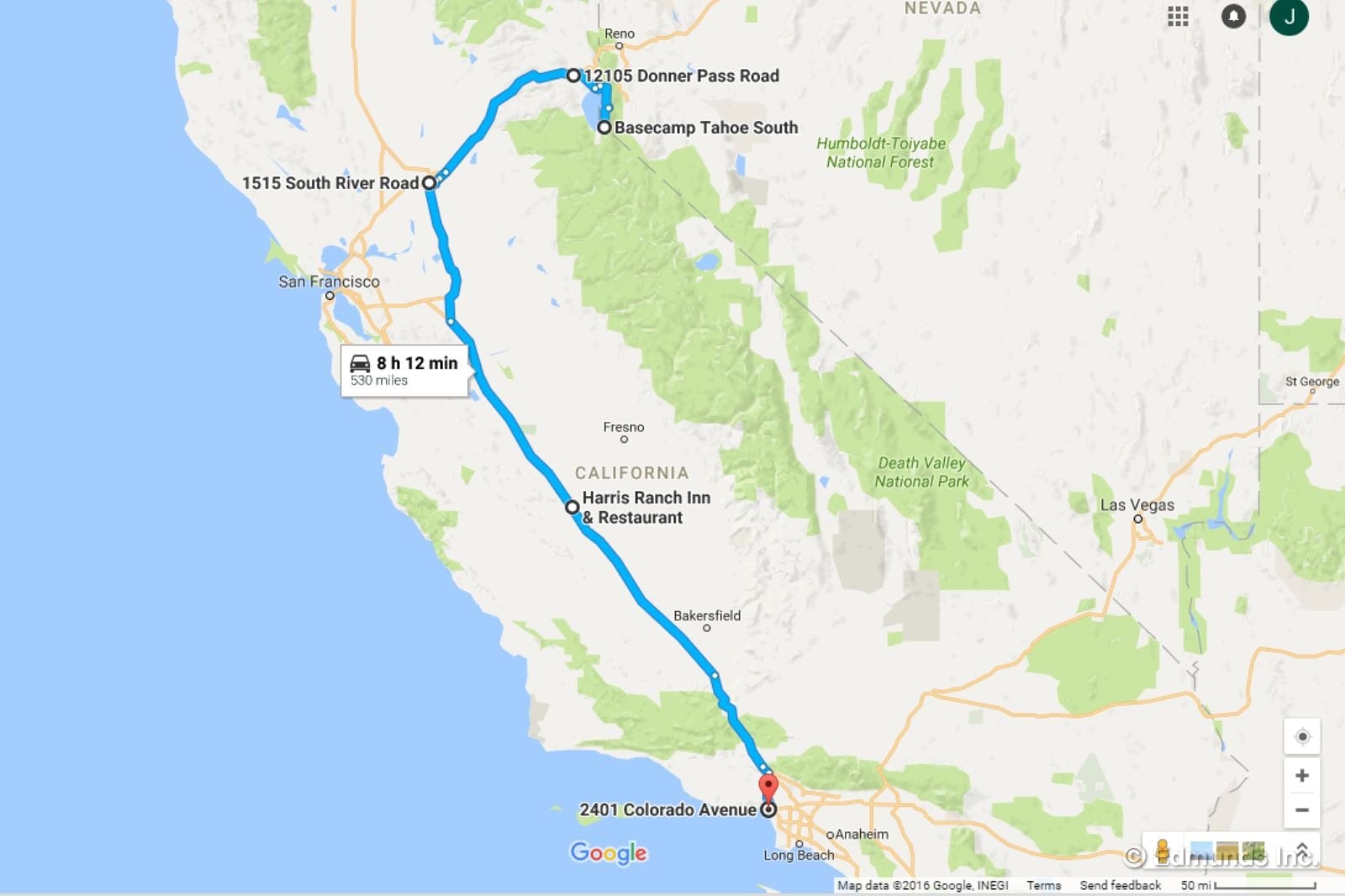
Off we go. At 7:59 a.m., we depart Base Camp Hotel in South Lake Tahoe. Our routes diverge almost immediately as Dan peels off in town while I continue around the lake to reach Truckee.
Dan's a competitive guy, and I'm a sucker for car-related contests. I want to win. I am determined to win. It's game on. There's no stopping me now.
I have to stop almost immediately. There's been a lot of road construction in this area lately and the road goes to one lane in several areas. The road crews are doing those alternating-direction closure deals. This isn't the way I wanted to start.
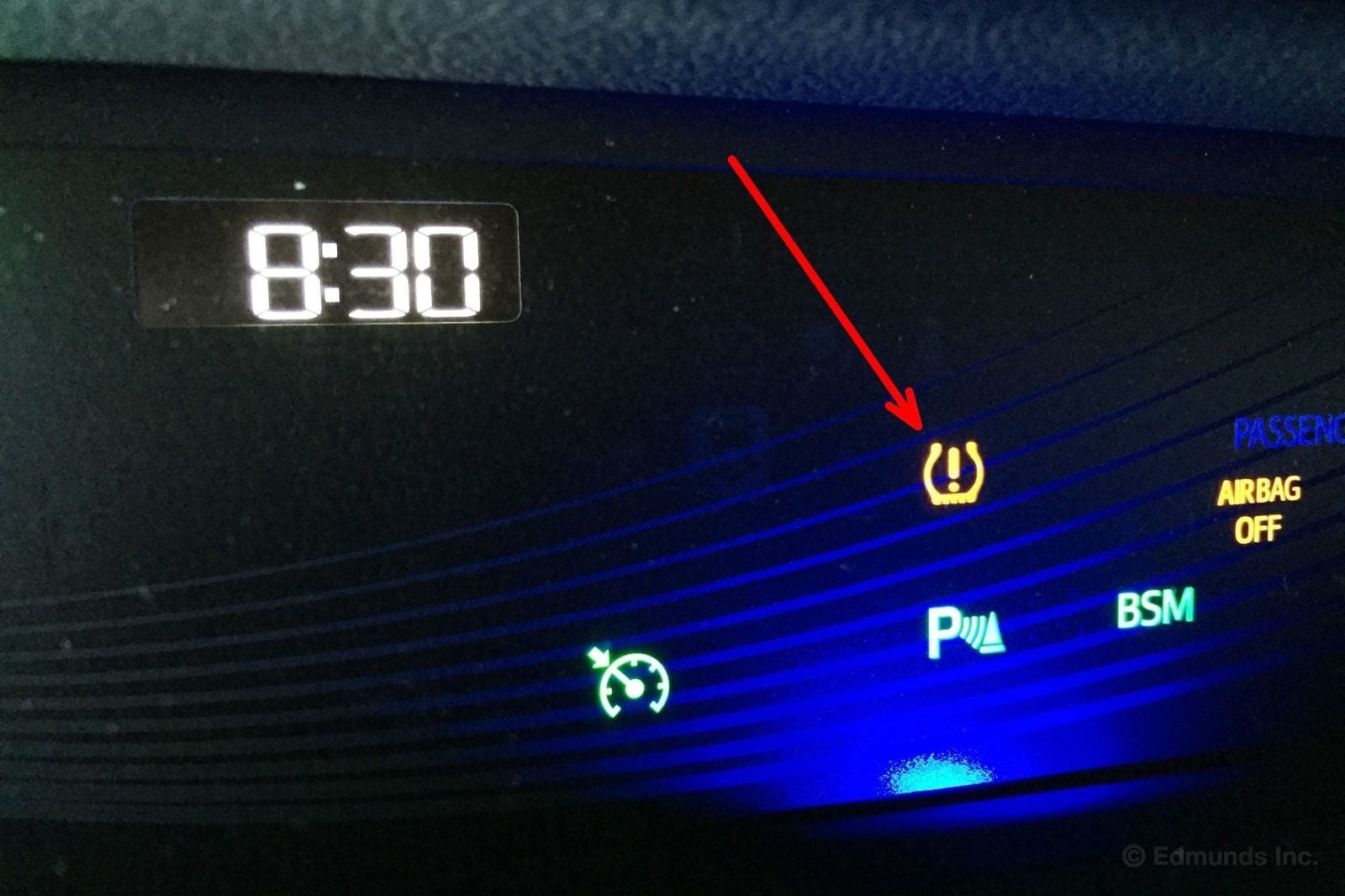
Worse yet, only minutes into the trip I notice something troubling in the Mirai's instrument cluster — an illuminated tire pressure (TPMS) icon. Drat. Does the Mirai have a low tire? It sure isn't driving that way, but sometimes a few missing psi can be hard to notice. Why doesn't this thing have individual tire pressure readouts? Maybe it does and I simply can't find them. Double drat. Stupid icon. It's not angry red, but it's also not going away.
I still have about 40 miles to go before reaching my planned hydrogen stop in Truckee. Depending on how low the tire is, that distance could destroy it. Then again, maybe the lit icon is simply a consequence of the ambient temperature being somewhat cooler than when the tires were set, and everything is actually fine. Maybe.
I start to rehearse the upcoming stop in Truckee in my mind. Every minute on this trip counts. I want to check the tire pressures during refueling to minimize downtime, so I'll need a tire pressure gauge. Fortunately, I carry one in my laptop bag. I dig it out and stick it into the Mirai's cupholder so it'll be at the ready.
The hydrogen pump in Truckee is easy to find. I begin refueling and get to checking the tires. They're cool to the touch and all of them are within two psi of the doorjamb sticker pressures. Perfect. This refueling stop takes eight minutes from power off to power on, and I don't lose a single minute due to the tire scare.
With a full tank and only 100 miles between here and the Sacramento station, I am now free to cane this thing with impunity.
At speed the Mirai is undramatic. Its ride comfort is better than the Tesla's, and its relatively compact dimensions make it feel tidier on the road. Rolling on skinny all-season tires, it has nothing like the handling and braking capability of the Tesla. But the driving experience is reassuringly normal.
I also find the Mirai's lack of gimcrackery refreshing. Its doors actually work as you expect, its windshield isn't a constant annoyance and its software isn't full of bugs. One of the few frustrations is its quaint, small touchscreen, which has Atari-like graphics compared to the Tesla's and will lawyer you into submission if you dare attempt to enter a navigation destination while moving.
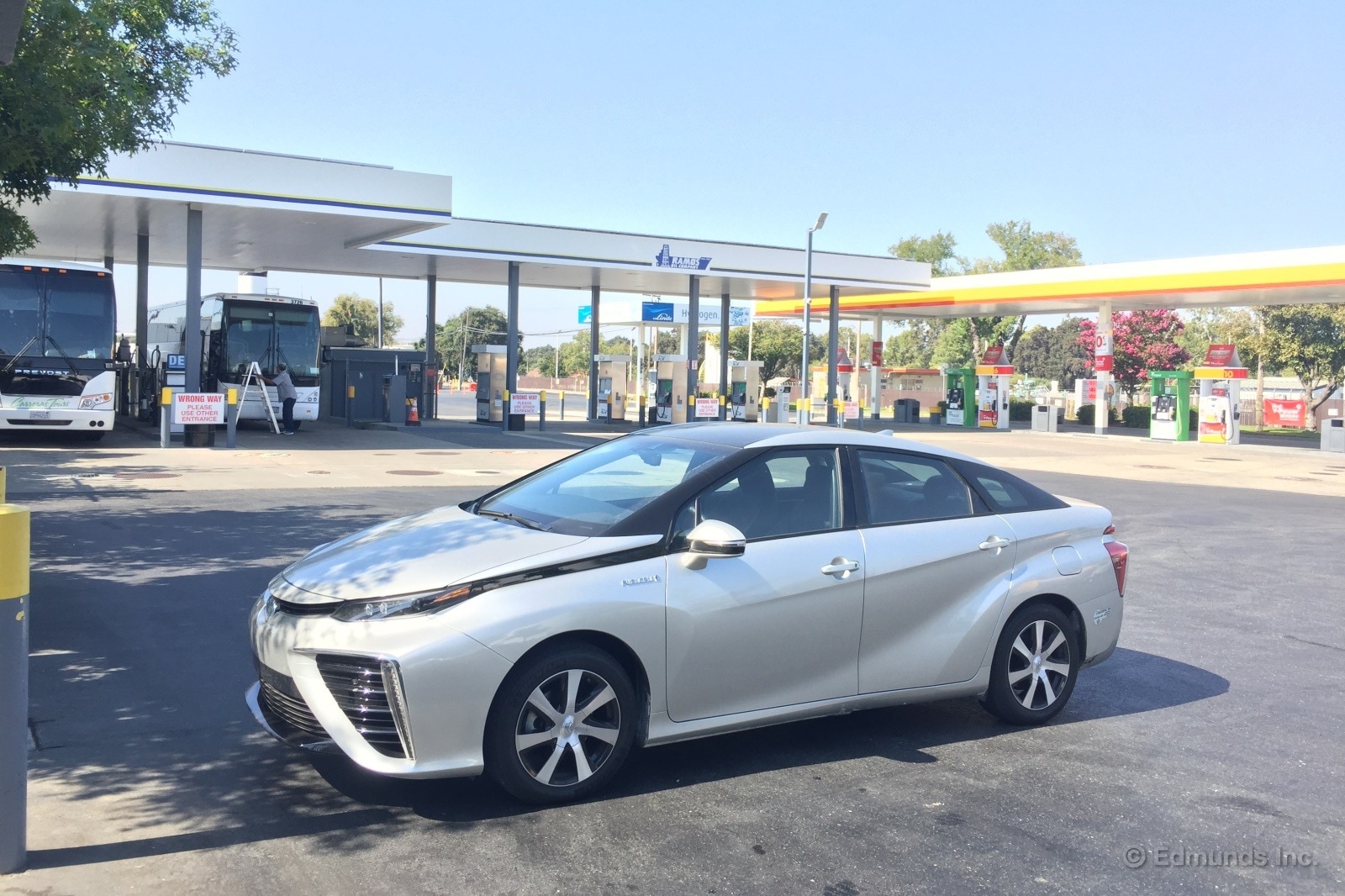
Sacramento comes up swiftly, but the filling station forces me to watch the dreaded instructional video before refueling. Arrggh. Then some poor instructions result in the video playing a second time. And then a third. I didn't budget for this. I also need to use the bathroom, and leaving the car unattended at the pump (like you do at a Supercharger) doesn't feel appropriate. Still, the refueling stop consumes only 12 minutes, even with the unexpected delay.
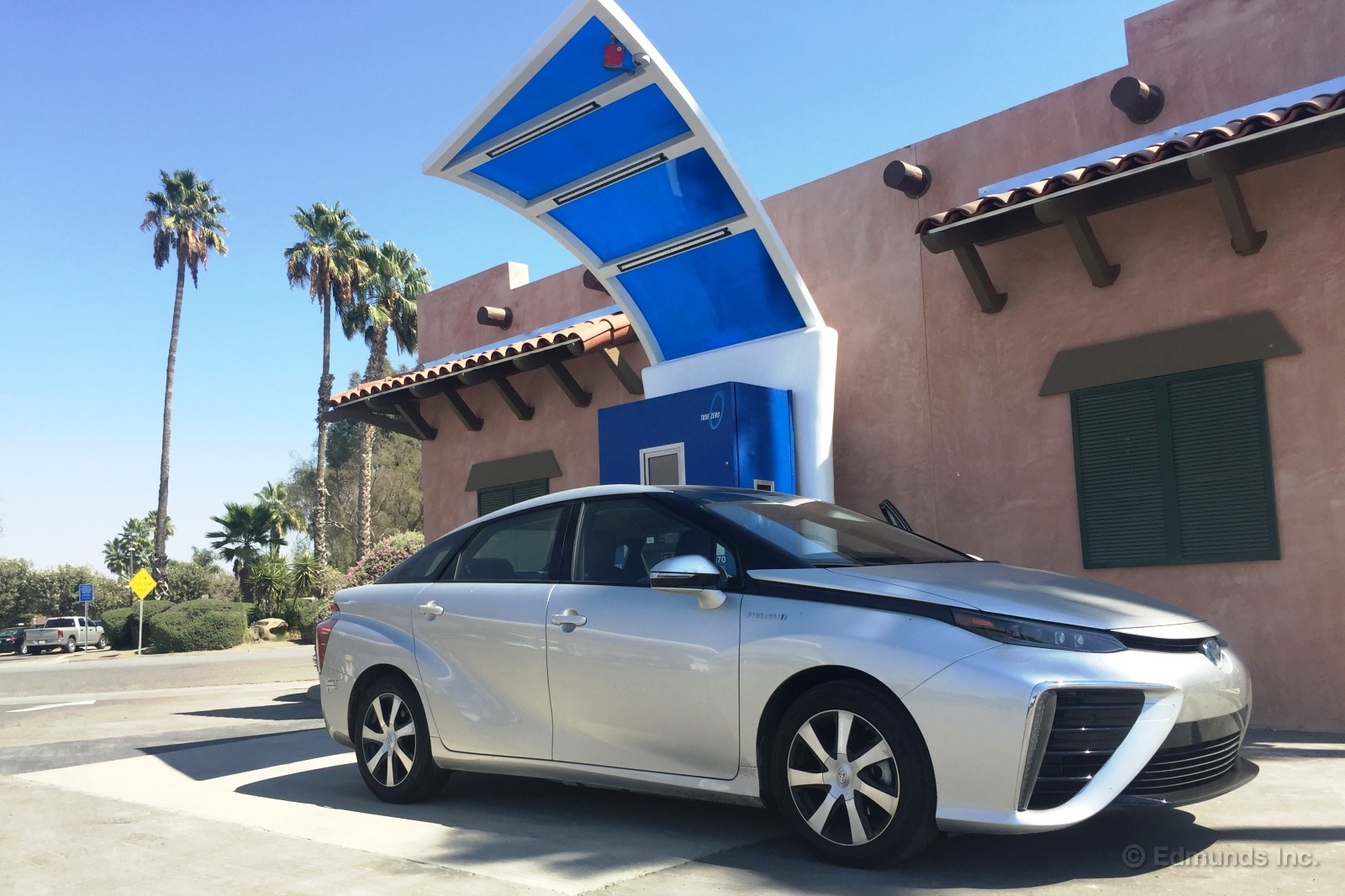
My next fuel stop is Harris Ranch, except I miss the exit. Yep. User error. Seconds after whizzing under the overpass, I remember that I had turned the volume down on my phone a while back, effectively muting Waze's navigational prompts. The next exit is nine miles away. Eighteen superfluous miles, all because I'm a meathead. This one hurts. Refueling at Harris Ranch takes only 8 minutes, though, and that's my last stop before the finish line.
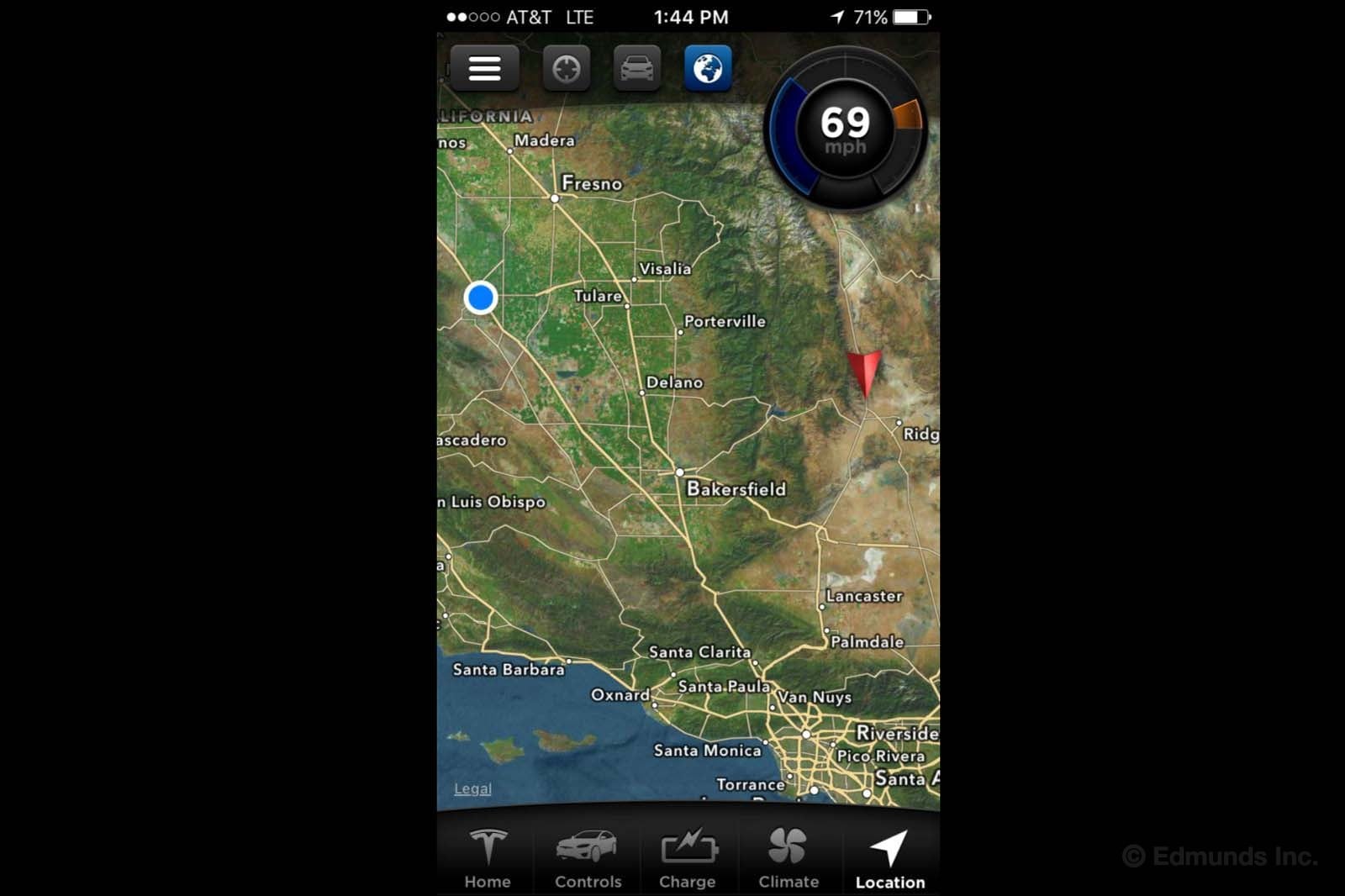
While at Harris Ranch, I check Dan's progress via the Tesla's iPhone app. There's not much space between us. This will be a close one.
When I finally I turn down the ramp to our parking garage in Santa Monica, it's 4:25 p.m. No Tesla. The Mirai has triumphed once more. But how far away is Dan? I have no signal in the parking garage, so I log a few notes, gather some items, chat with Mike Massey for a bit and head upstairs.
There, I check the app again.
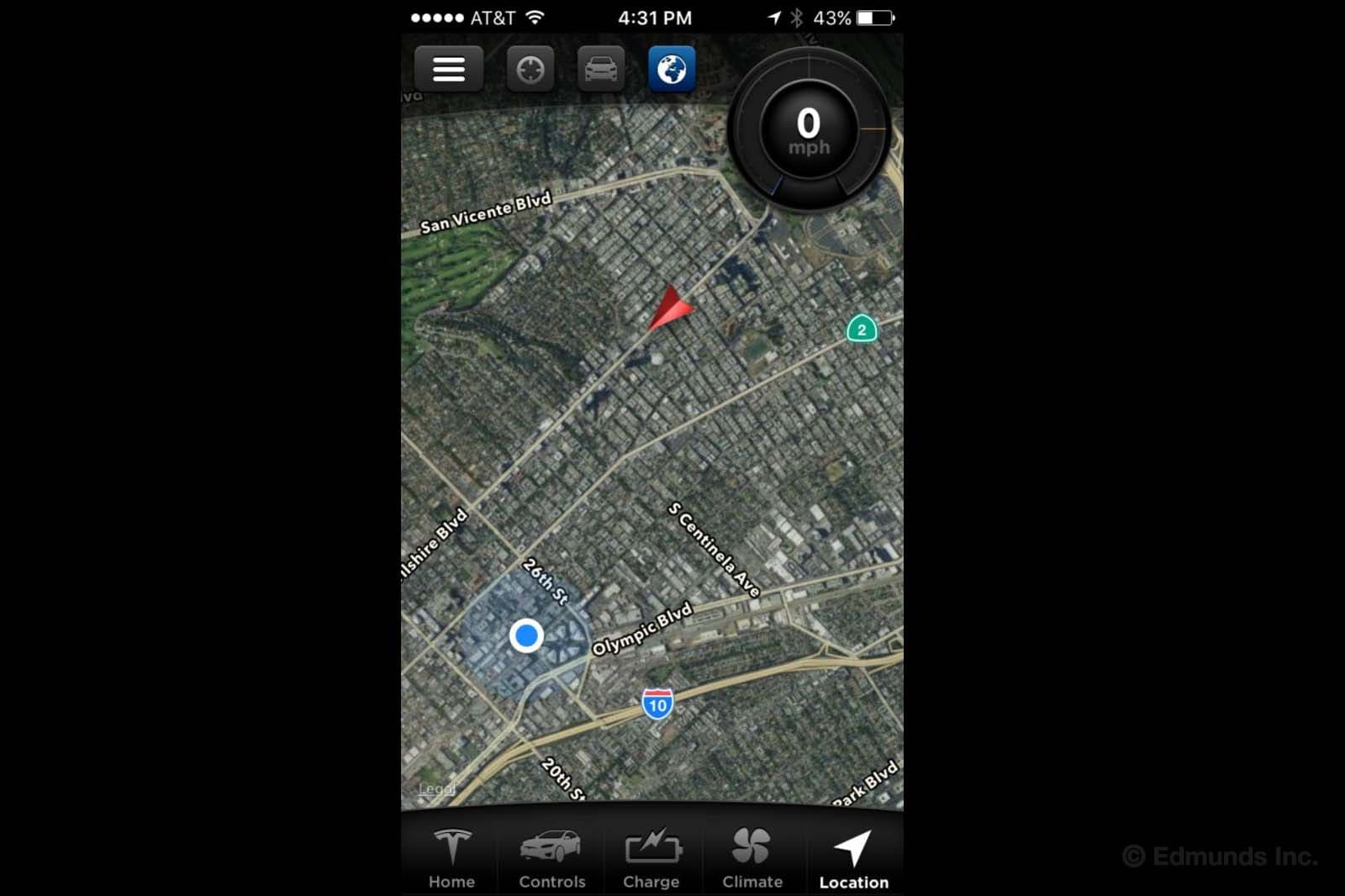
Dan's really close now. I run outside and a minute or so later he rolls past.

I snap the above victory photo — timestamped 4:37 p.m. — and stroll down the parking ramp to swap stories.
Dan says he was exasperated by the numerous slow-moving vehicles he encountered heading out of Tahoe, and now he's demoralized by how close the contest was. I kindly inform him that I inadvertently added 18 miles to my trip with my Harris Ranch snafu. Hopefully he feels a bit better knowing that the win could have been even more decisive than it was.
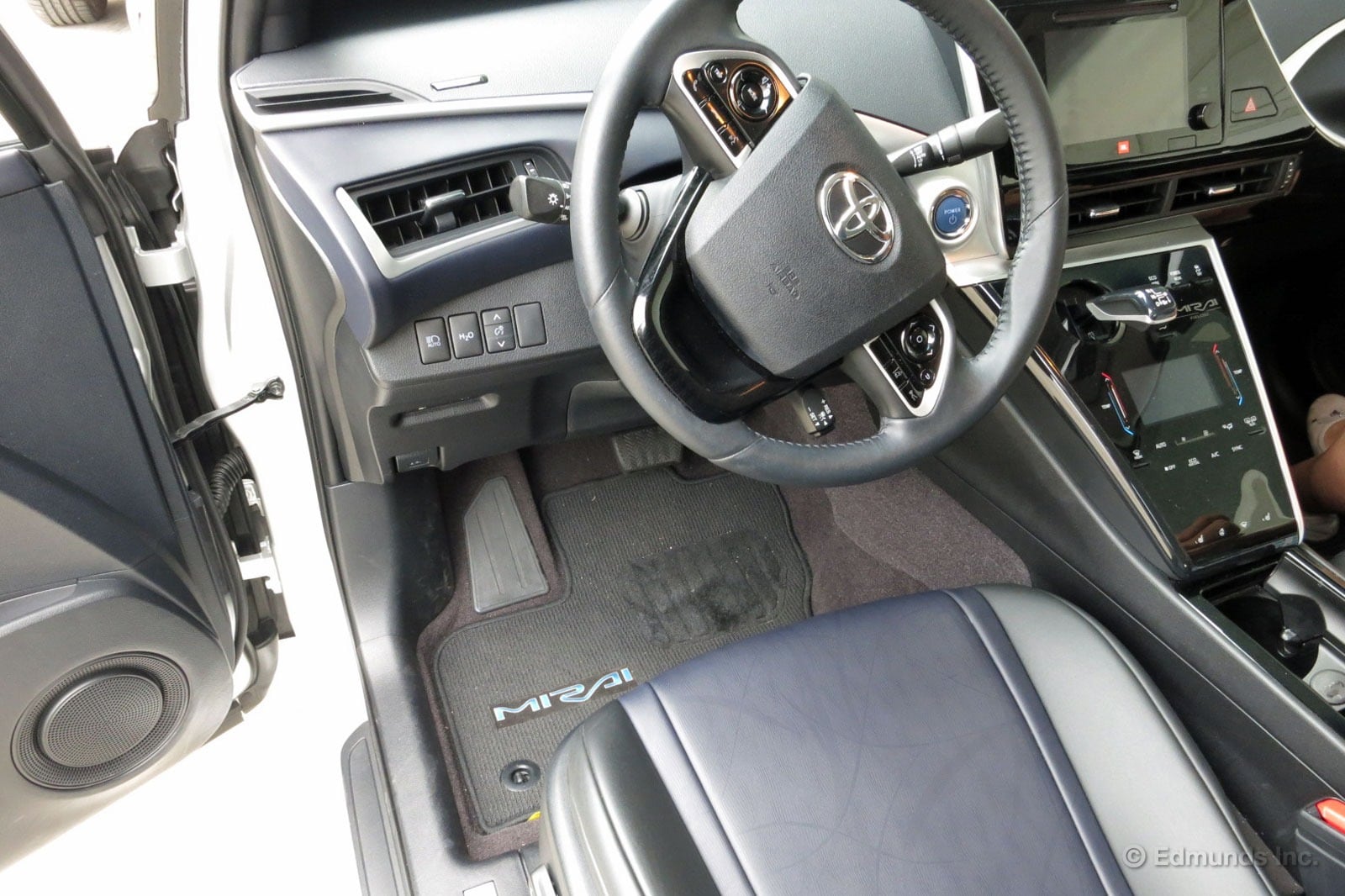
In a hurry to get to the pharmacy before they closed, I hopped in the 2016 Toyota Mirai, hit the power button and looked for the electronic parking brake release button.
I quickly searched the center console. Nothing. I looked to the left of the steering wheel. Nothing.
"No way this thing has a manual foot-pedal parking brake," I thought, glancing down at the left side of the footwell. Again nothing.
Now feeling extreme gotta-make-the-pharmacy pressure, I resorted to exiting the Mirai, taking a deep breath, and getting back inside to look again.
Nothing.
With neighbors watching from their front lawn, I again got out of the car, this time bending down to look directly in the footwell.
Sure enough, there was a mechanical foot-pedal release, but fully depressed it is virtually invisible, as shown in the above photo.
Here's what it looks like when the pedal is disengaged.
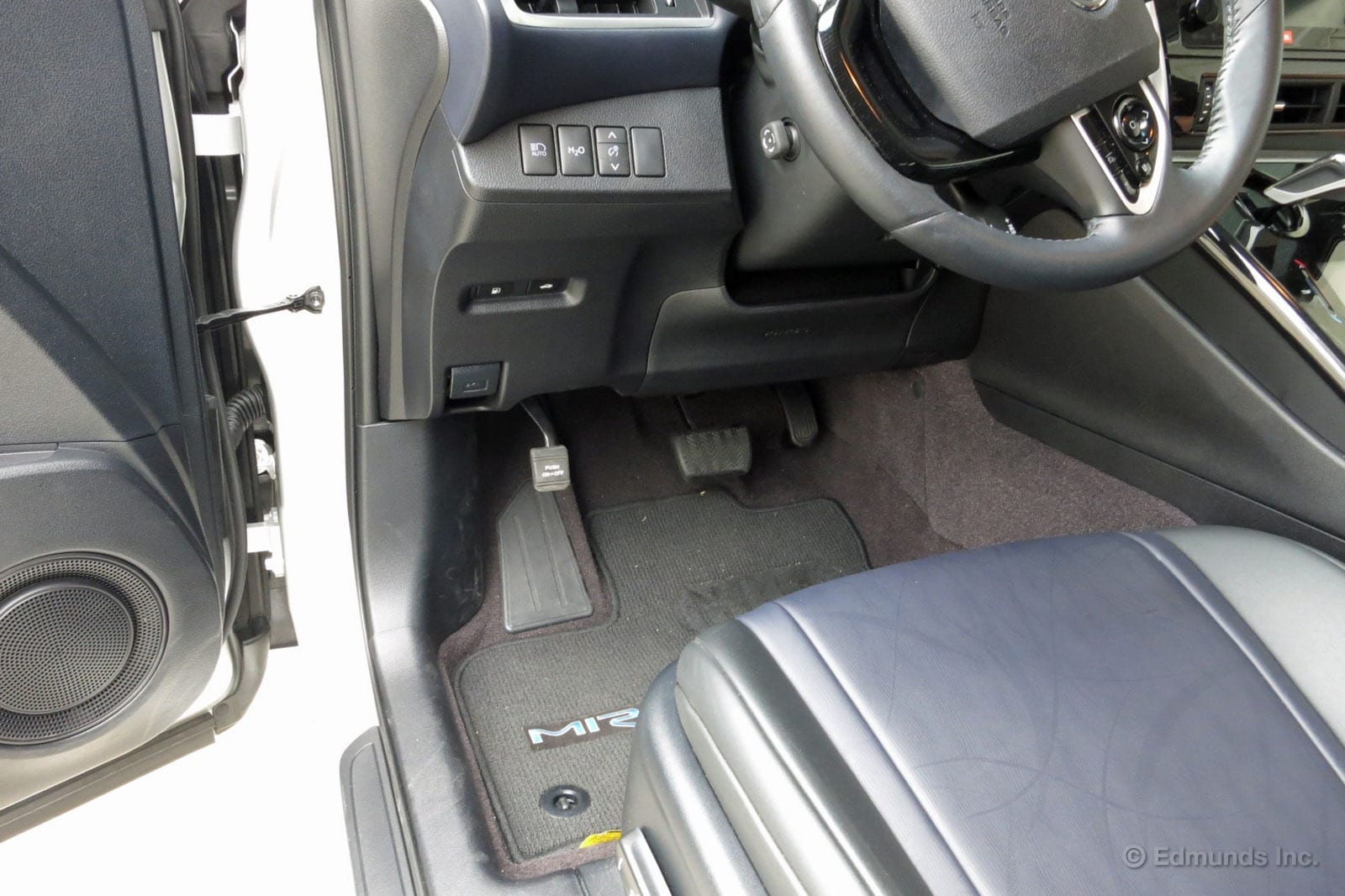
Say what you will, even call me an idiot. But I had never driven the Mirai before, and never, ever did I expect that an advanced hydrogen-powered vehicle would still be using such old-school technology.
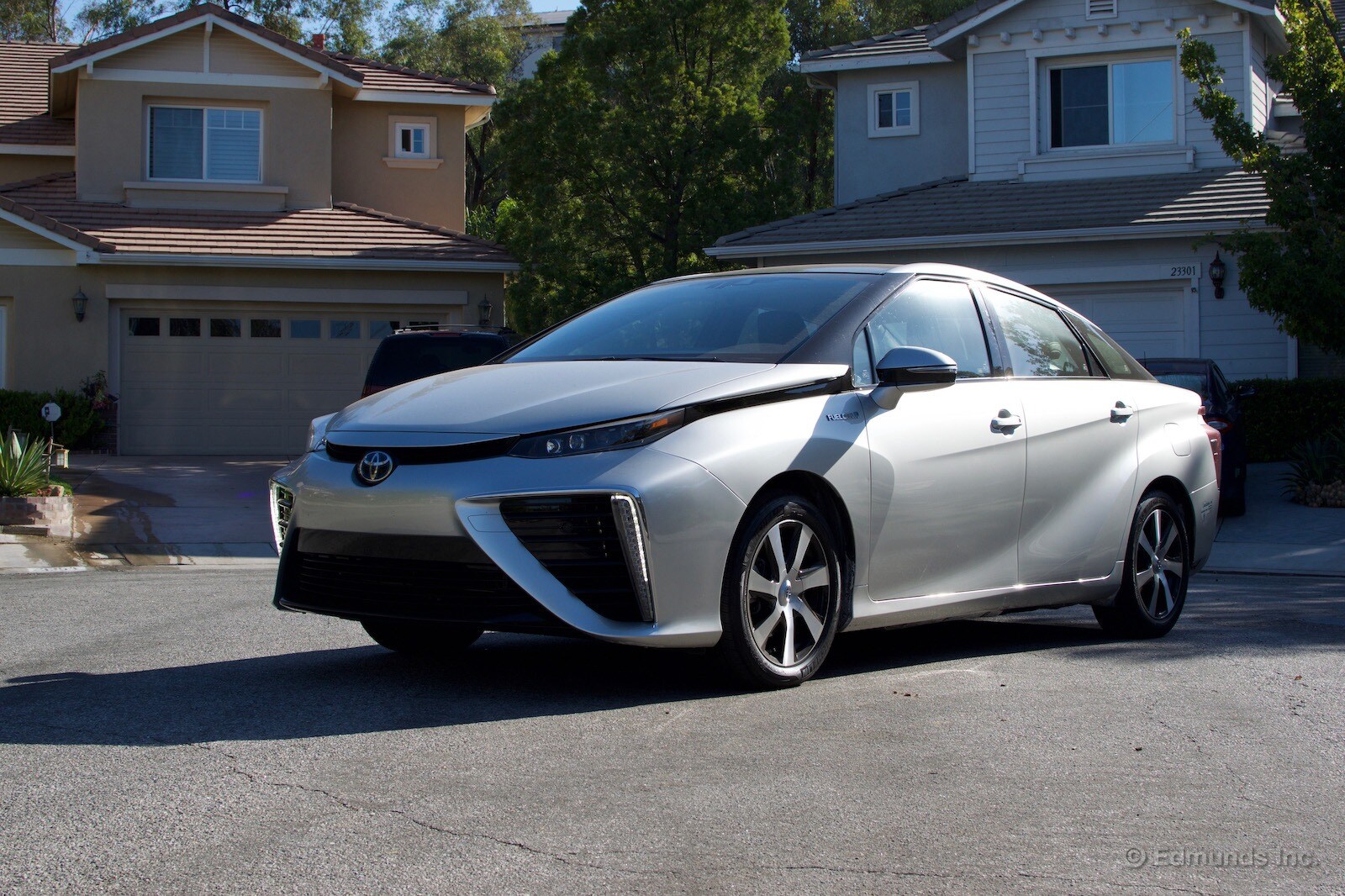
I popped the trunk on our 2016 Toyota Mirai for the first time before driving three friends to a reality-show dinner party. What I saw concerned me. There's a bump in the cargo floor due to the rear hydrogen tank and battery, which are stacked on top of each other.
It didn't look like there was much space left over.
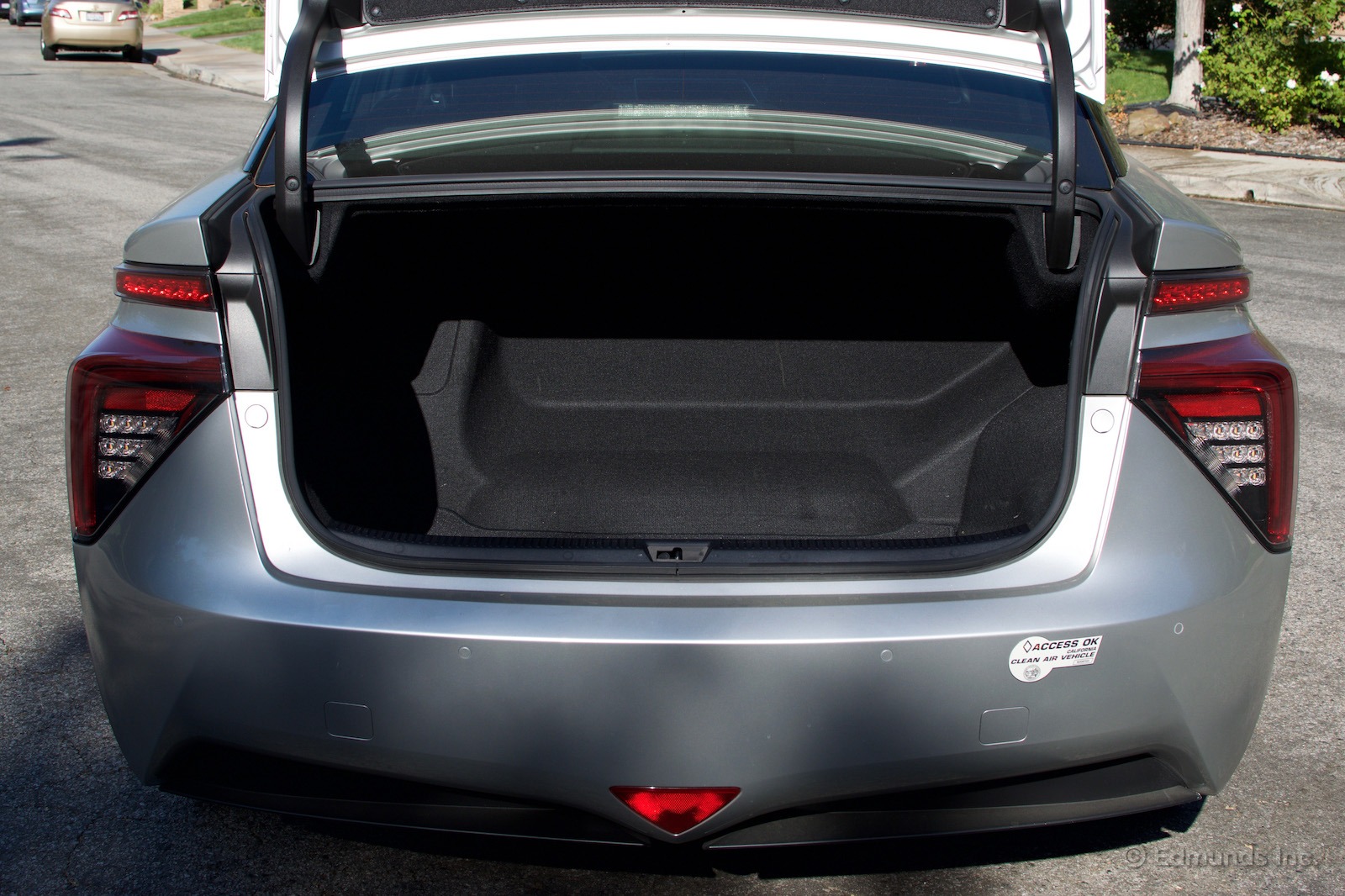
Fortunately, we didn't have that much stuff to load. Three backpacks, a pan of brownies and a couple packages of soy chorizo went in without issue. It didn't matter that the rear seatbacks don't fold down, and since the trunk hinges disappear into their own covered channels, there was no fear of crushed cargo.

There's no doubt that the Mirai's trunk is modest, but it got the job done in this case. And less time spent worrying about our cargo meant more time to focus on who was or wasn't getting a rose.
Wrap-Up
What We Got
The 2016 Toyota Mirai was the first fuel-cell-powered electric vehicle available for public sale in North America. It is only available in California, and at the beginning of our test there were just over 10 fueling locations. It was not only an important test for Toyota but also for the viability of hydrogen as a gasoline alternative.
We did not have to put much thought into how to equip our Mirai. The sedan was available in just one trim, fully loaded. The standard equipment list included leather seating, heated everything, blind-spot monitoring, an Entune infotainment system and more. The MSRP was $58,335.
There was plenty of bait to entice buyers, including a $7,500 Toyota "Trailblazer Purchase Support" incentive, a $8,000 federal tax credit and a $5,000 California rebate. On top of all that, every Mirai had access to carpool lanes and a complimentary hydrogen fuel card for the first three years of ownership.
What would hydrogen cost us when the three free years ran out? Is hydrogen a feasible alternative to battery-electric vehicles? How realistic is the 312-mile range projection? These were some of the questions in mind when our six-month test of the 2016 Toyota Mirai began. Here's what we found out:
Performance
"At speed the Mirai is undramatic. Its ride comfort is better than the Tesla's, and its relatively compact dimensions make it feel tidier on the road. Rolling on skinny all-season tires, it has nothing like the handling and braking capability of the Tesla. But the driving experience is reassuringly normal." — Jason Kavanagh
"Combined, the steering heft and large turning circle make the Mirai hard to park and generally cumbersome to maneuver in tight quarters. After a week in the Toyota I found these driving characteristics to be my least favorite." — Mike Schmidt
MPG
"Today's Hydrogen Highway is eerily similar to those early days of the Tesla Supercharger Network, and that realization recently prompted Jay Kavanagh and me to concoct a friendly contest. It's the 2016 Toyota Mirai versus the 2016 Tesla Model X, hydrogen versus electricity, fuel cell versus batteries. It's the Hydrogen Highway versus the Tesla Supercharger network." — Dan Edmunds
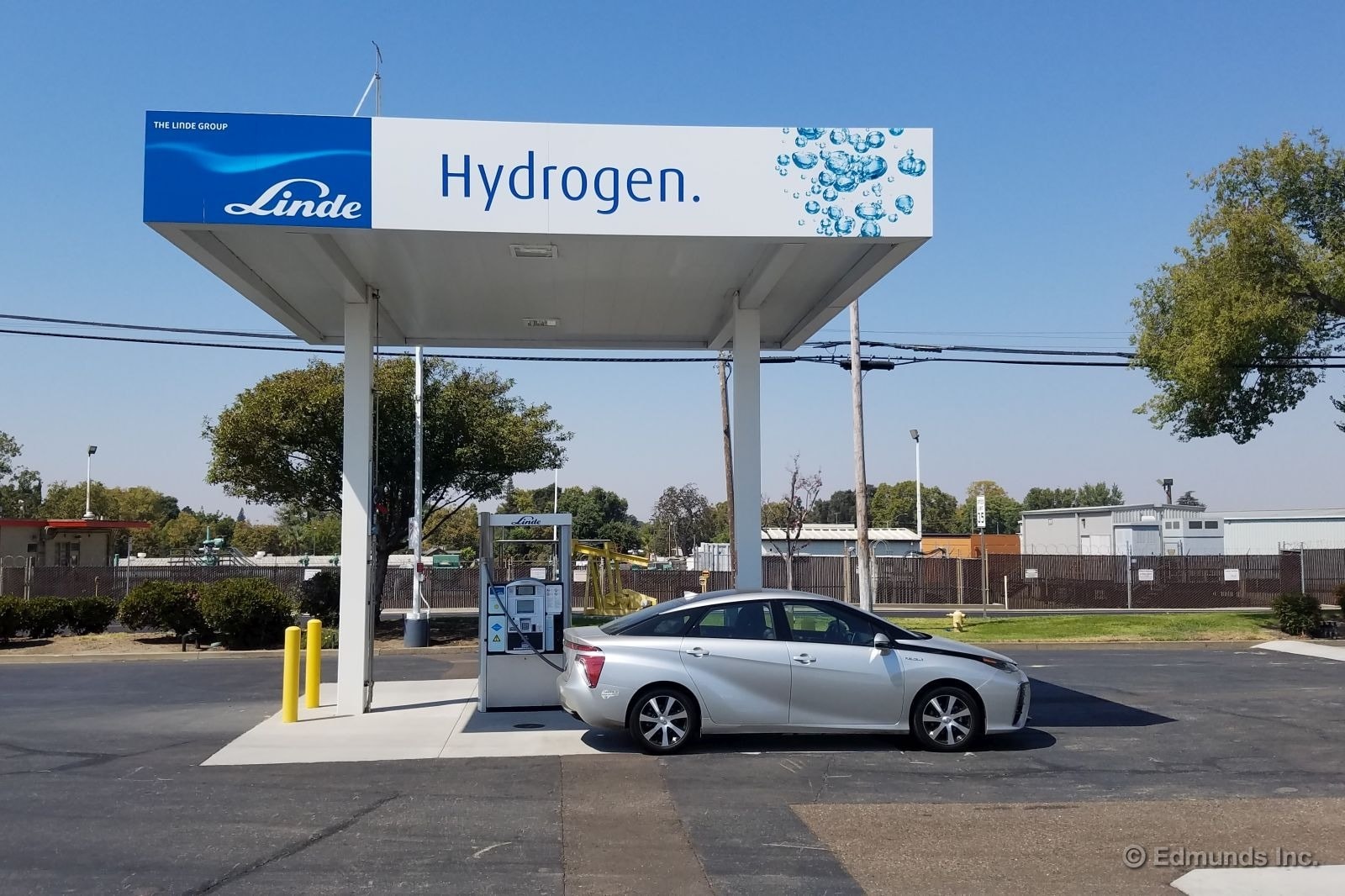
"Sacramento comes up swiftly, but the filling station forces me to watch the dreaded instructional video before refueling. Arrggh. Then some poor instructions result in the video playing a second time. And then a third. ... Still, the refueling stop consumes only 12 minutes, even with the unexpected delay." — Jason Kavanagh
Comfort
"Seat comfort was also another surprise. I wasn't expecting anything special, but the driver seat in the Mirai fits my 6-foot-2 frame perfectly. It has excellent bolstering along the sides and plenty of support for my thighs." — Ed Hellwig
"Sitting behind the 5-foot-5-inch Emma, who of course hadn't moved her seat forward to accommodate her 5-foot-7-inch mother, I realized I had plenty of room for both my knees and my feet. So much, in fact, that I allowed my laptop bag to share my footwell." — Kelly Hellwig
Cargo Space
"There are so many aspects of our Mirai that are unusual. Thankfully, the trunk isn't one of them. Sure, it's not as big as it could be thanks to the twin tanks of compressed hydrogen hiding underneath the floor, but there's still more than enough room for a standard set of golf clubs." — Ed Hellwig
Interior
"If you're going to pay nearly $60,000 for a Toyota, it had better not have the interior of a $30,000 Prius. Thankfully, our long-term Mirai does not. Indeed, its cabin is what I would call 'Lexus Lite,' wherein it's a clear step above other Toyotas yet not quite to the level of the company's luxury division." — James Riswick
"If you like futuristic touchscreen controls, you'll love the Mirai. It has them in spades, even where you don't want them. Thankfully, there are some redundant controls on the steering wheel that use actual buttons. Are they enough to make up for the clumsy touchscreen on the center stack? Uh … sometimes." — Ed Hellwig
Audio and Technology
"The Mirai ... comes with a Qi-compatible wireless phone charging pad ... concealed inside the center armrest bin. It sounds like a brilliant idea. ... But there is a catch. ... Your phone must have designed-in wireless charging capability or be fitted into a phone case or other adapter that is compatible." — Dan Edmunds
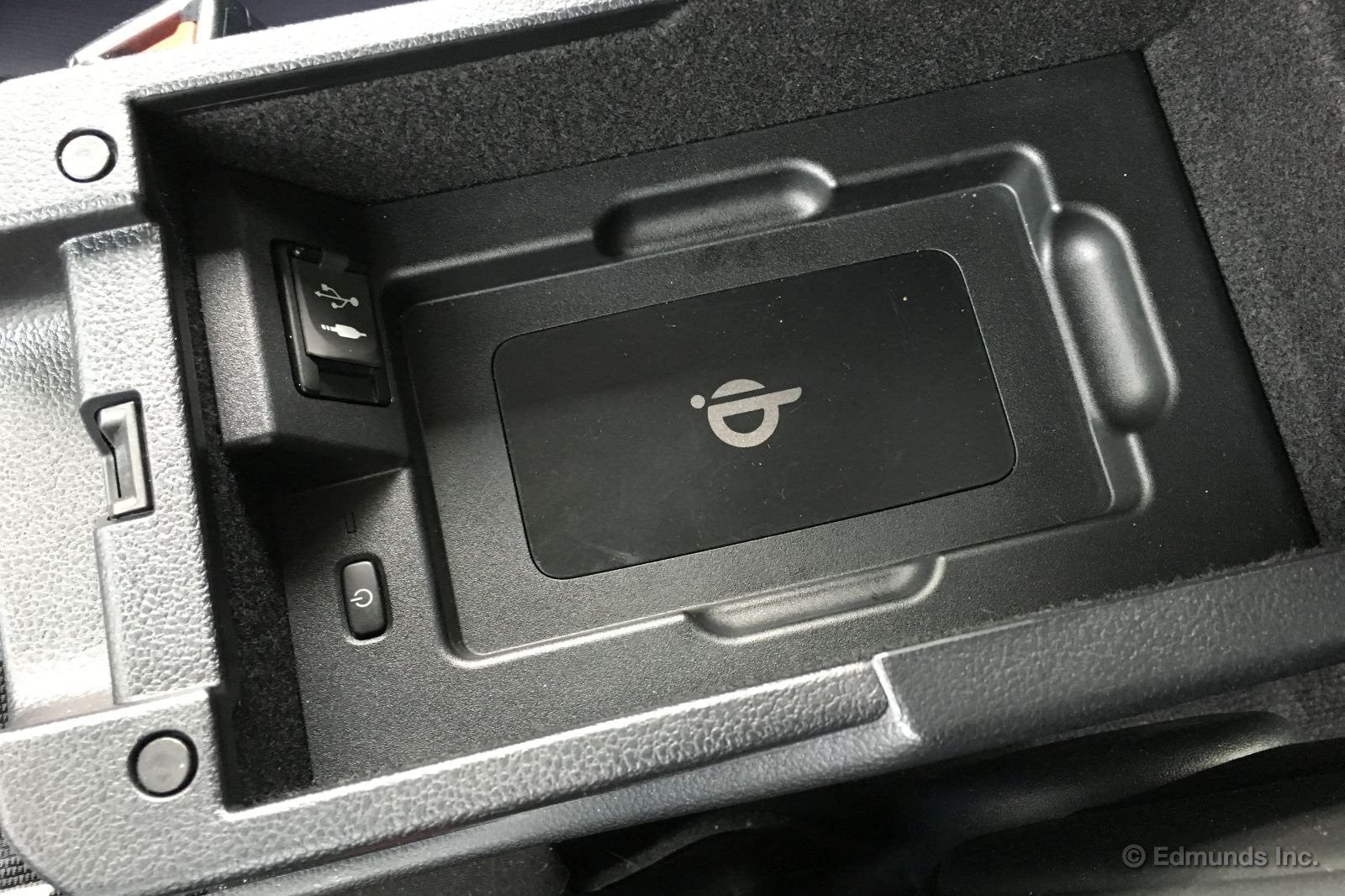
"The Mirai sure doesn't skimp on providing things that are heated. This panel at the bottom of the center stack includes controls for driver and front passenger seat heaters, the heated steering wheel and even heated windshield wipers." — Ed Hellwig
Maintenance
"The wiper fluid reservoir was easy to find under the hood. It's tucked near the firewall on the passenger side. Less than a gallon satisfied the warning light. Case closed." — Mike Schmidt
Miscellaneous
"There's a water purge button. As you may or may not know, the sole byproduct of the fuel cell's conversion of hydrogen into electricity is water. Under normal use, that water is expelled through a discharge pipe underneath the car, so it might leave a small puddle much like the air-conditioning system of a normal car does." — Ed Hellwig

"Buy or lease a Mirai and you'll get a gas card that gives you free fuel for three years. Like a Tesla's Supercharger electricity, it costs you nothing. In three years you get up to $15,000 worth. ... After three years, though, you're on your own. Maybe the price will drop. Probably the price will drop. The future of hydrogen power depends on it. But by how much? Maybe it's better to lease this one. A lot can change in three years. Something better will come along. Something better-looking certainly will." — Dan Edmunds
Maintenance & Repairs
Regular Maintenance:
Aside from a tire rotation at 5,000 miles, no maintenance was required during our test.
Service Campaigns:
No recalls or technical service bulletins were issued during our test.
Fuel Economy and Resale Value
Observed Fuel Economy:
Fuel economy was the wildcard with the Mirai. We can tell you our car averaged 58.9 MPkg of hydrogen and that our best tank was 74.3 MPkg and our worst 41.9 MPkg. But that means little without a comparison to a gasoline powered car. So let's compare our long-term 2016 Toyota Mirai to our long-term 2016 Toyota Prius.
During the first three years it is free to fuel the Mirai. It wins, right? Except it isn't that easy. Say you left your fuel card on the dresser or say the three-year grace period ran out. We found hydrogen prices vary considerably from station to station and paid anywhere from $9.54 to $16.63 per kg during our test. Our average cost per mile was 24 cents.
Now take our Prius. We have averaged 47.7 mpg to date. Since the Mirai is a California-only car, we take the $2.80 average cost of 87-octane gasoline in this state for the calculation. Our average cost per mile in the Prius is 6 cents, or four times less than the Mirai, if we had to pay.
We have no idea what hydrogen will cost in the future. For the success of the technology it has to drop considerably. But for the purposes of drawing a conclusion, the safe bet at this point in time is to lease a Mirai rather than buy.
Resale and Depreciation:
MSRP on our Mirai was $58,335. After our six-month test the odometer read 7,925 miles. Using Edmunds TMV Calculator and assuming a private-party sale, we calculated a drop in value to $39,035, or a 33 percent depreciation from MSRP. Not that great but on par with other alt-fuel vehicles.
If we subtracted the $7,500 discount offered by Toyota, things got interesting. This adjustment effectively lowered MSRP to $50,835 and depreciation to 23 percent. We did not include any other purchase incentives in this calculation, as they can vary from sale to sale. But their existence makes the cost to buy a Mirai even more appealing.
Summing Up
Pros:
It's a surprisingly comfortable sedan thanks to the supple suspension and well-shaped seats; comes fully loaded so there are plenty of features and no options to consider; capably of well over 250 miles on a single tank; plenty of usable trunk space; free hydrogen for three years; eligible for carpool lane access; enough room in the backseats for adults to sit comfortably.
Cons:
The Mirai is sold only in California currently; lack of refueling stations means you have to plan ahead for longer trips; cost of hydrogen fuel varies widely from station to station; some of the interior controls are hard to use at a glance; strong initial acceleration but slow at higher speeds.
Bottom Line:
For a first attempt at a hydrogen-fueled car for the public, the Mirai was surprisingly comfortable, easy to drive and trouble-free. It had more than enough range to drive it everyday without having to worry about staying close to the nearest fueling station, and it felt substantial on the road. In other words, it was an uneventful ownership experience that made running on hydrogen feel as normal as filling up with gas.
| 2016 Toyota Mirai | 2016 Toyota Prius | |
| Average Fuel Economy: | 58.9 MPkg | 47.7 mpg |
| Best Fuel Economy: | 74.3 MPkg | 57.2 mpg |
| Worst Fuel Economy: | 41.9 MPkg | 42.3 mpg |
| Average Cost per Mile (< 3 years): | $0 | 6 cents |
| Average Cost per Mile (> 3 years): | 24 cents | 6 cents |
| Best Range: | 283.4 miles | 468.5 miles |
| True Market Value at service end: | $39,035 (private-party sale) | |
| Depreciation: | $19,300 (33% of original MSRP) | |
| Final Odometer Reading: | 7,925 miles |
Disclaimer:
The manufacturer provided Edmunds this vehicle for the purposes of evaluation.